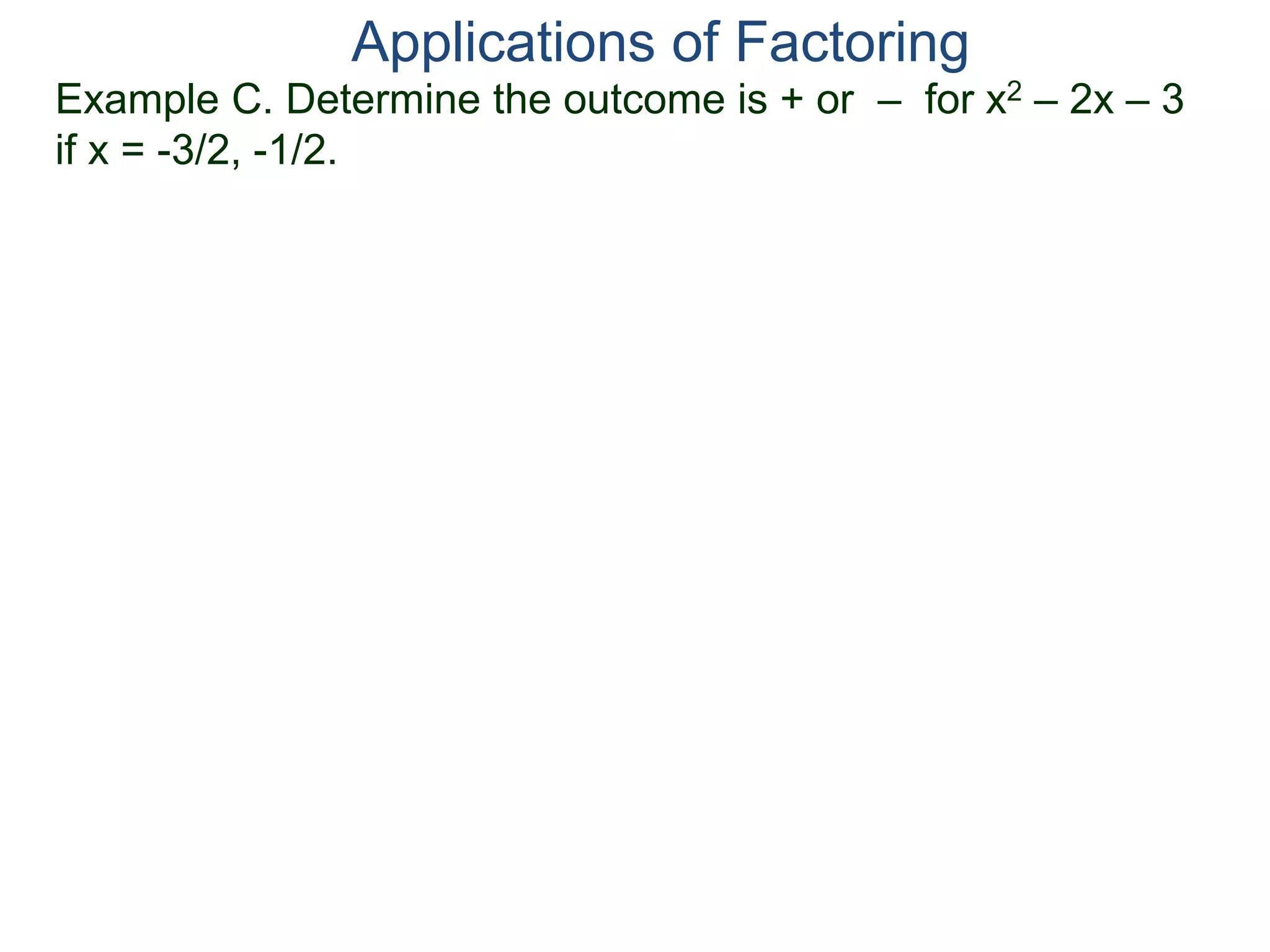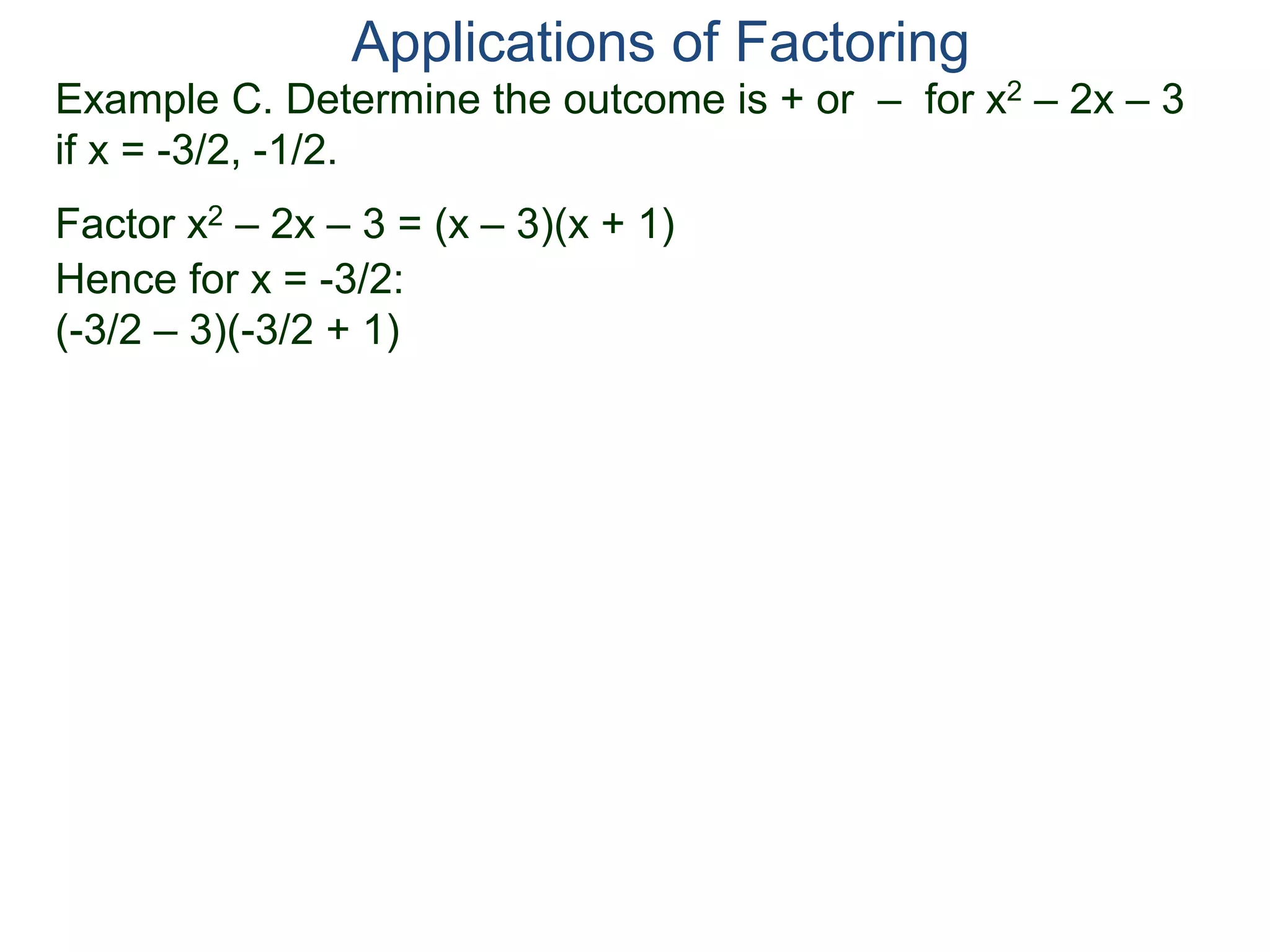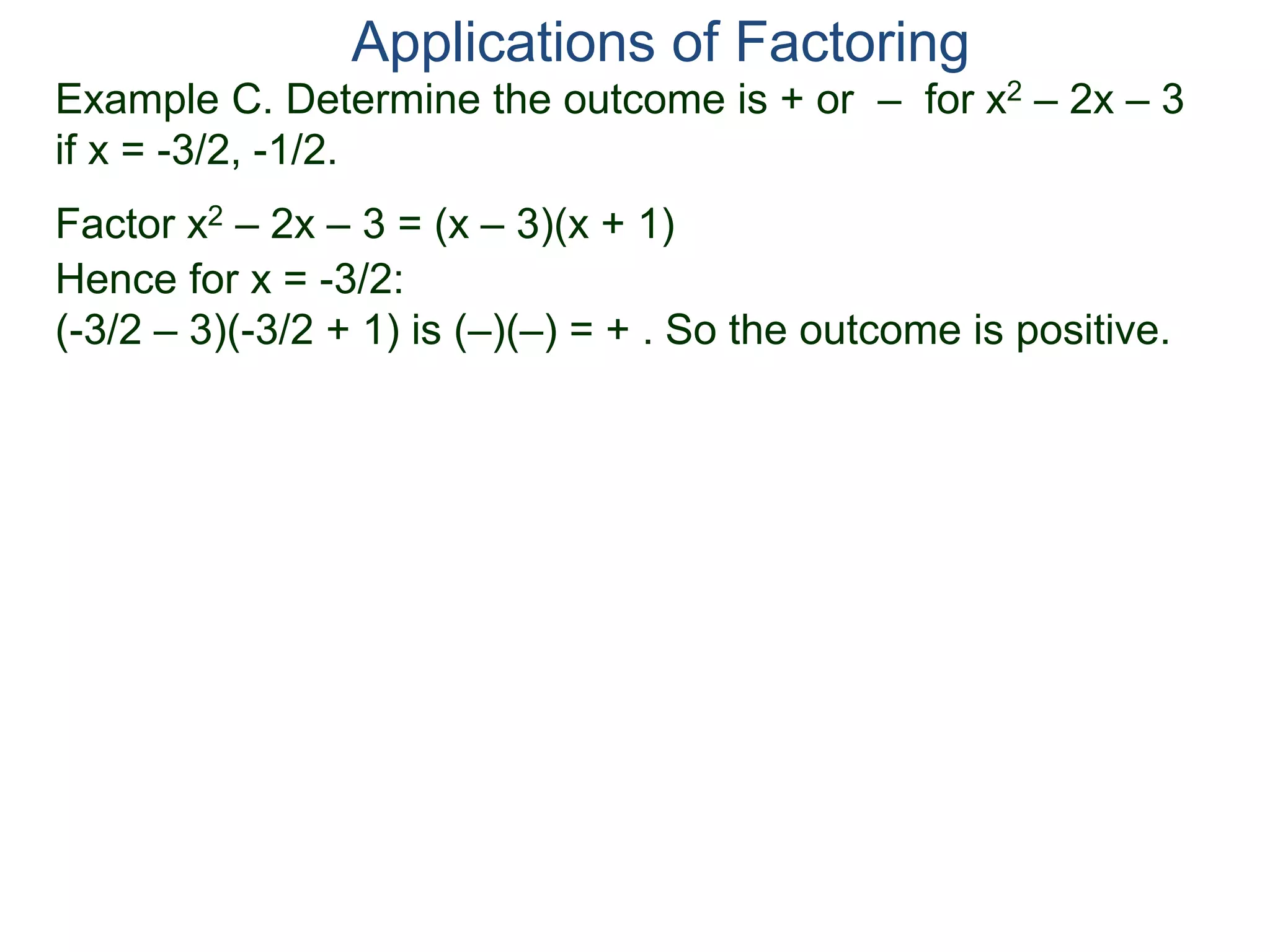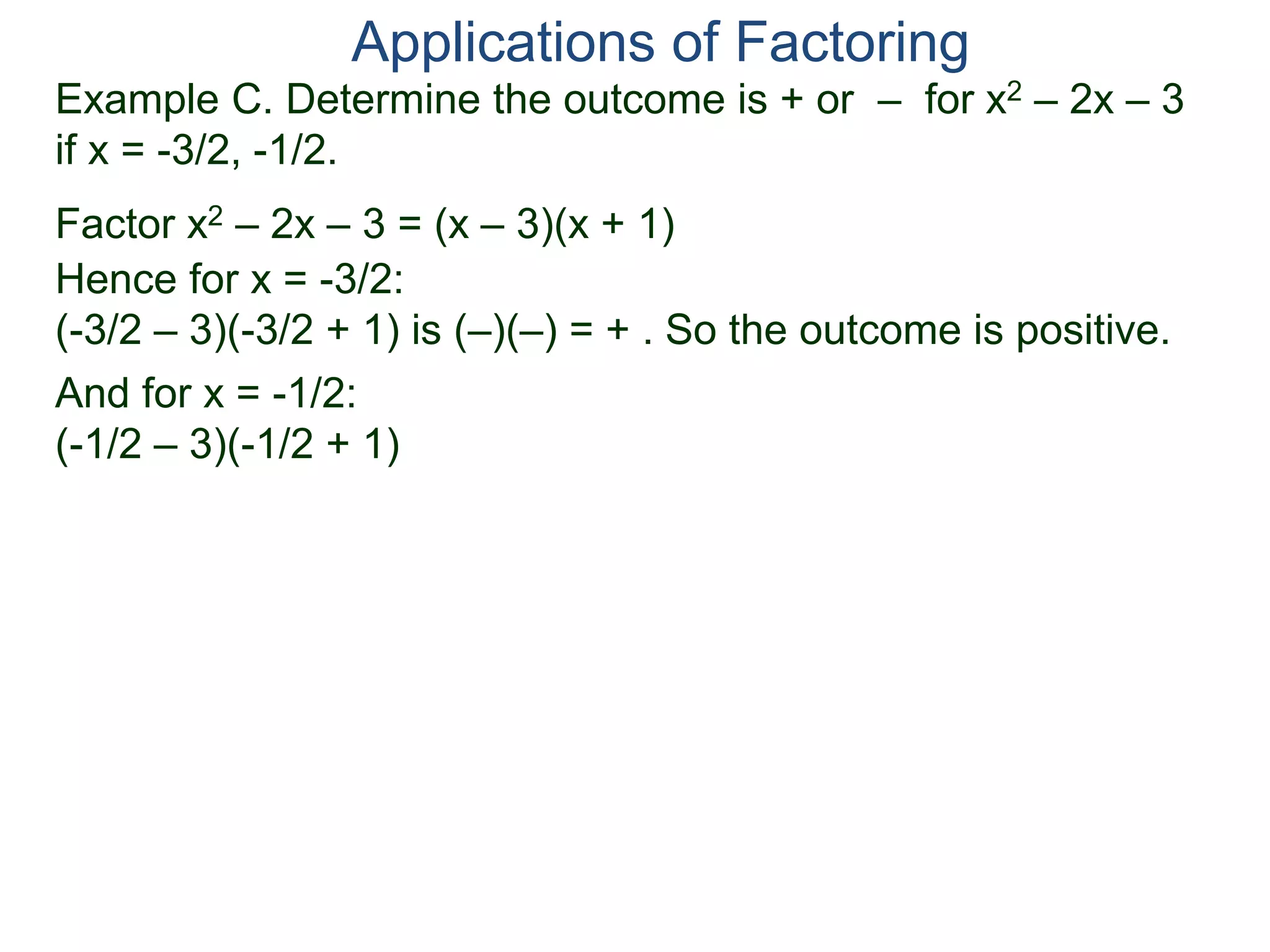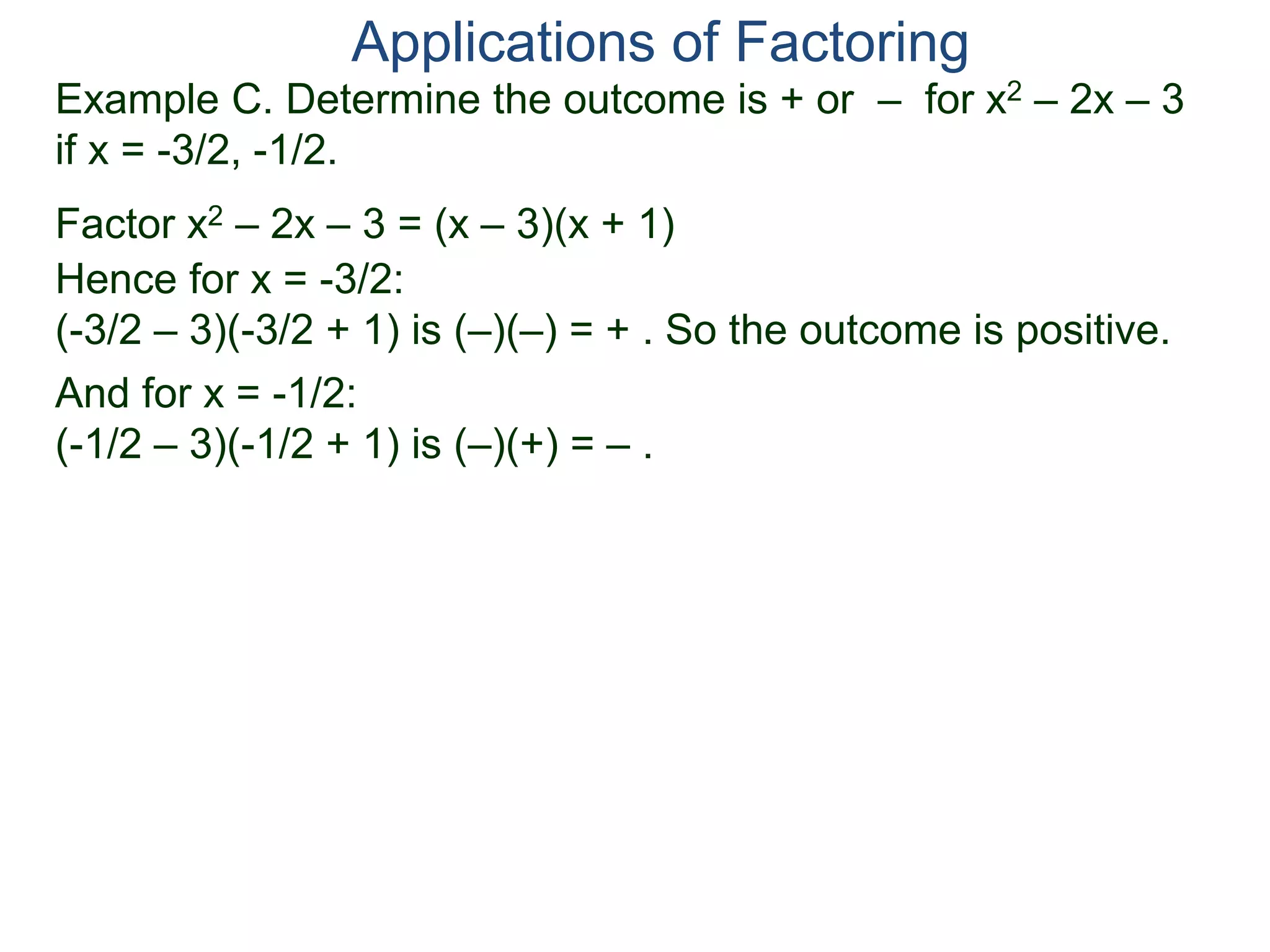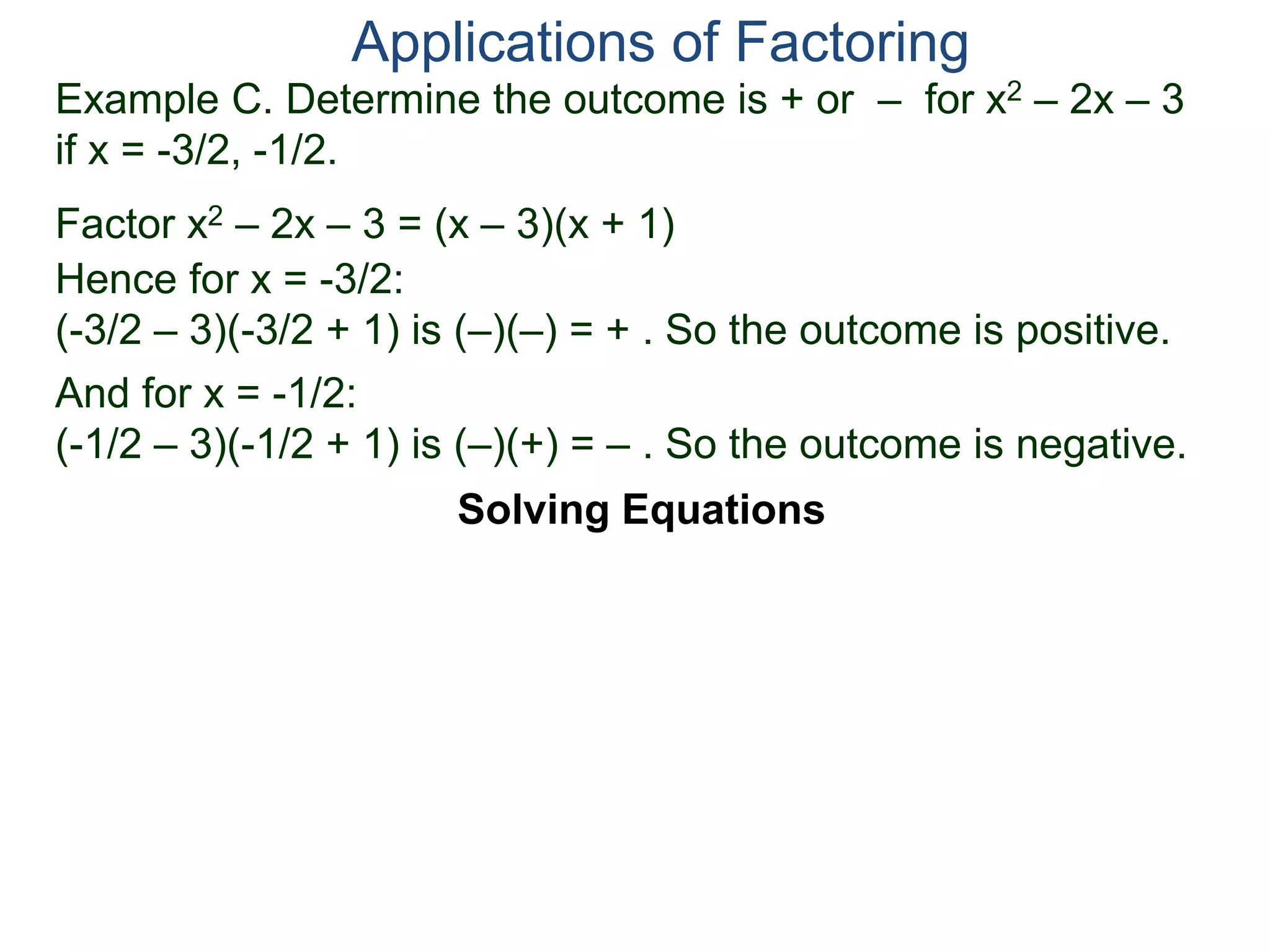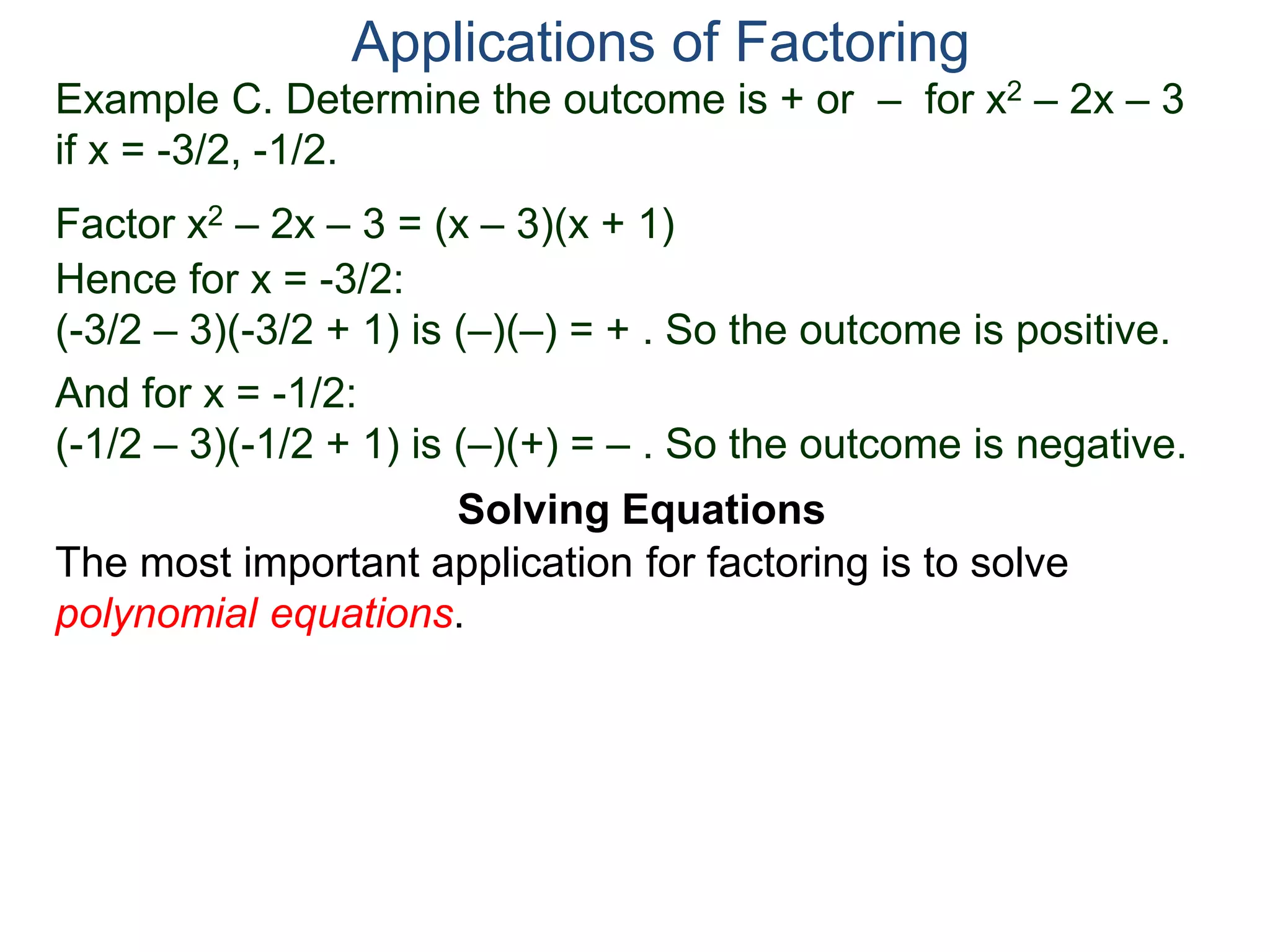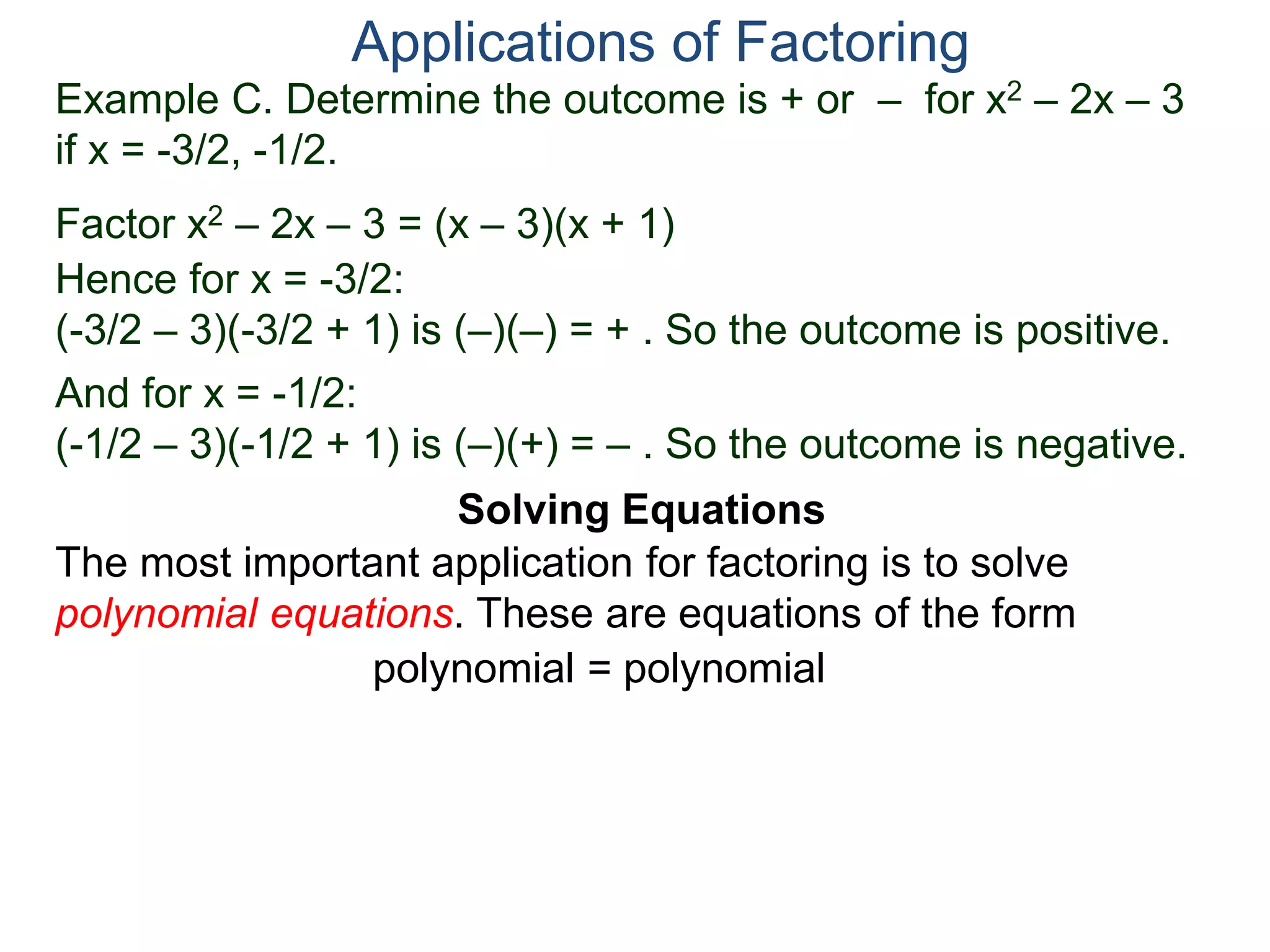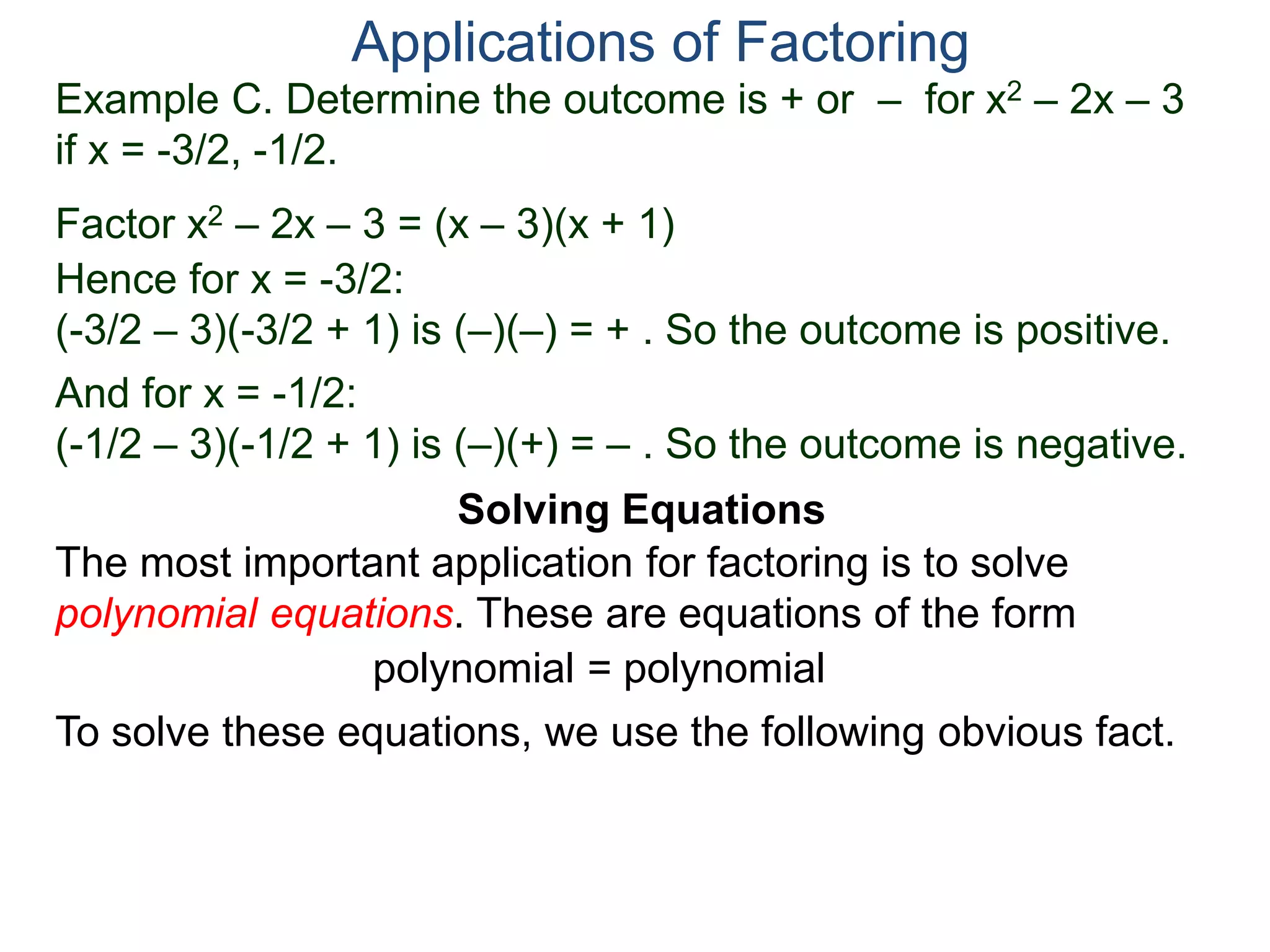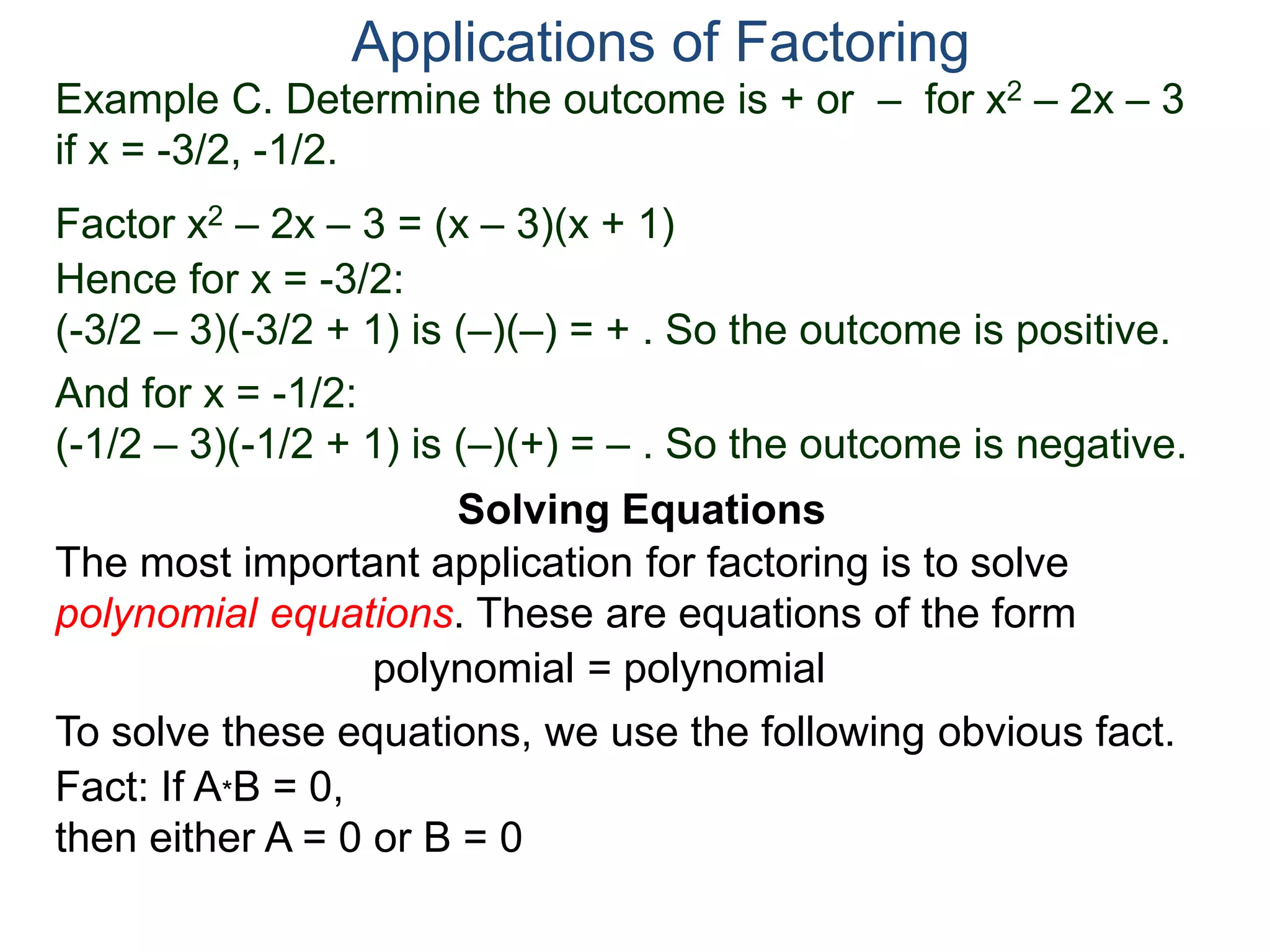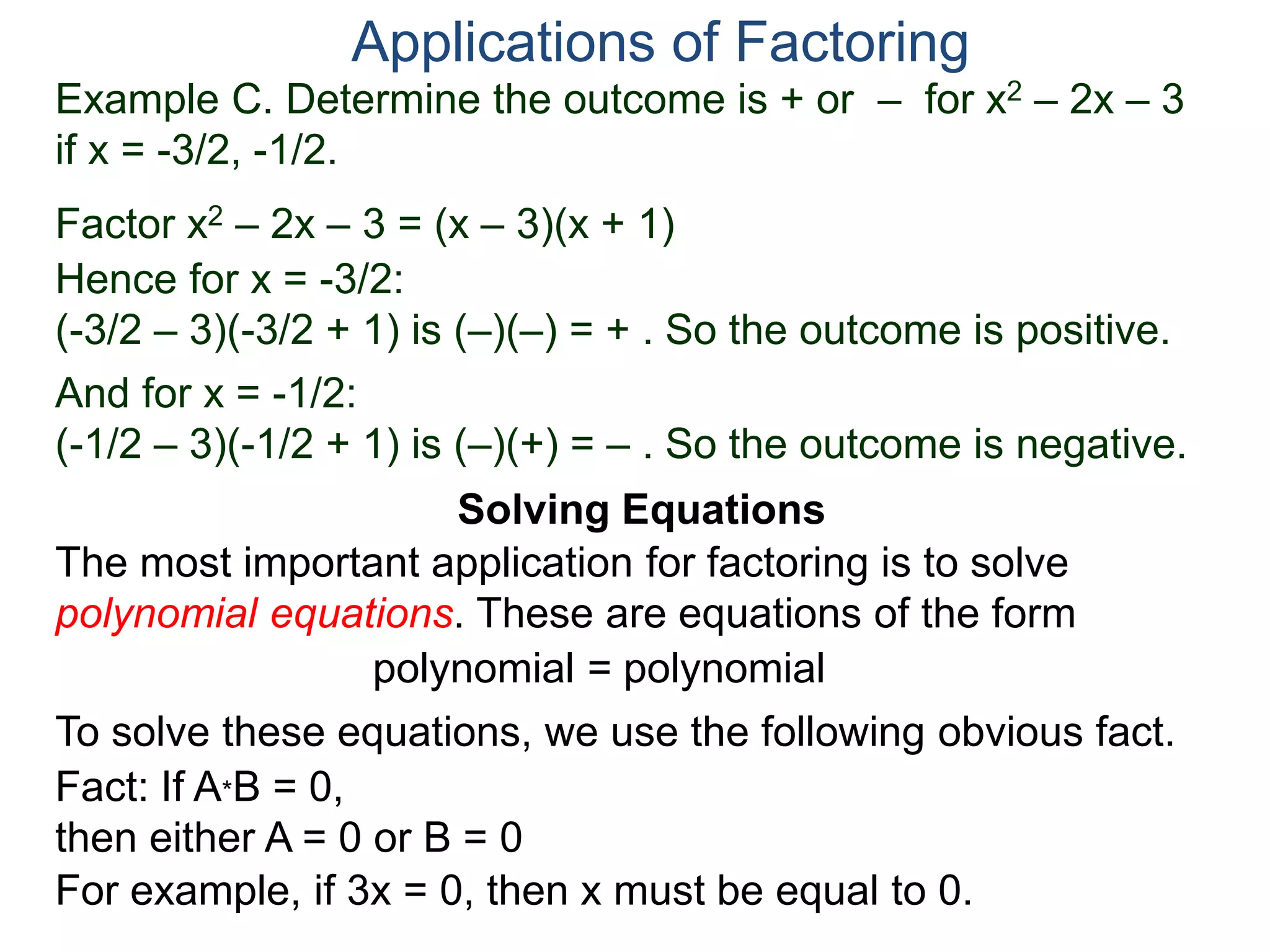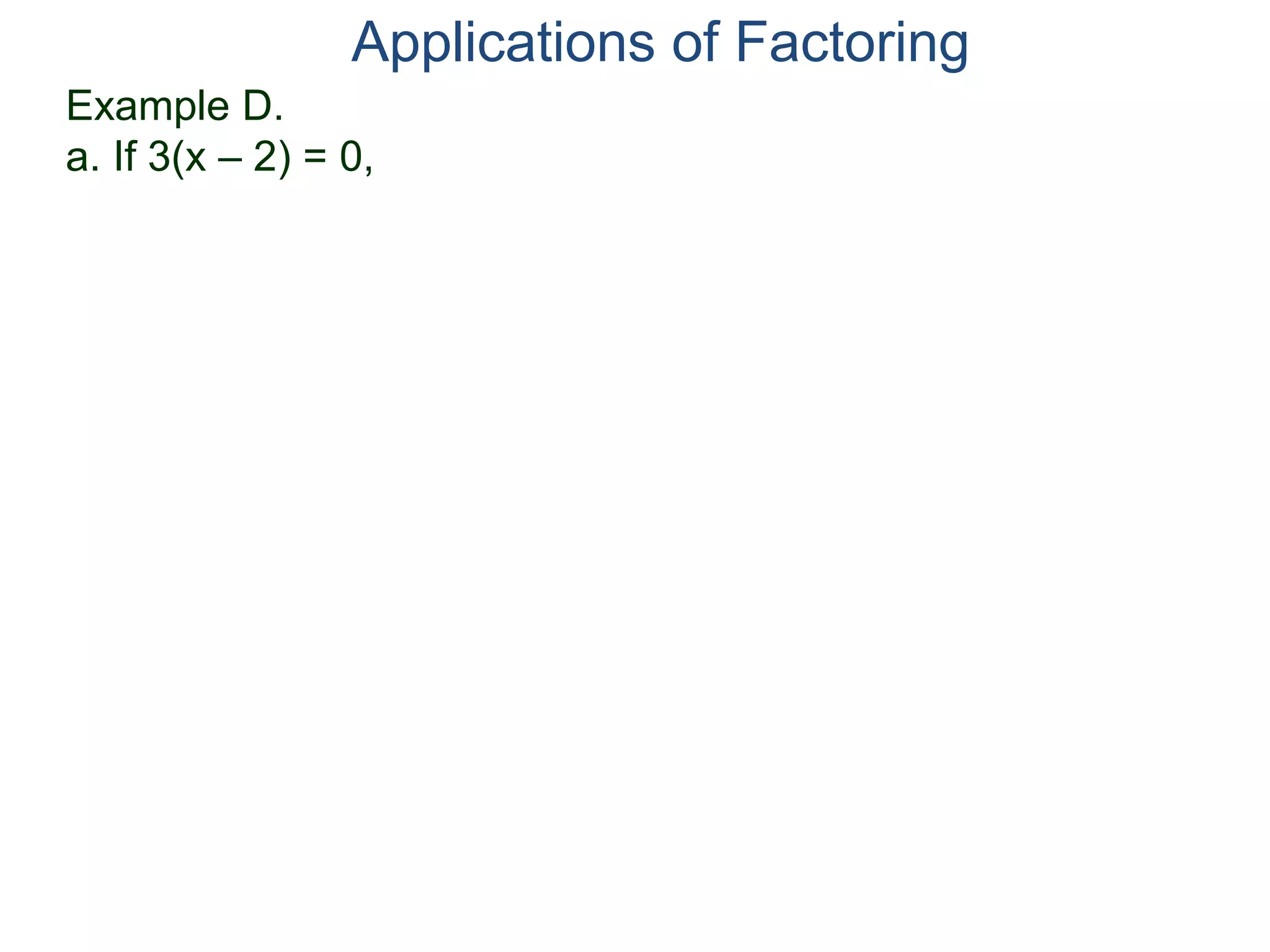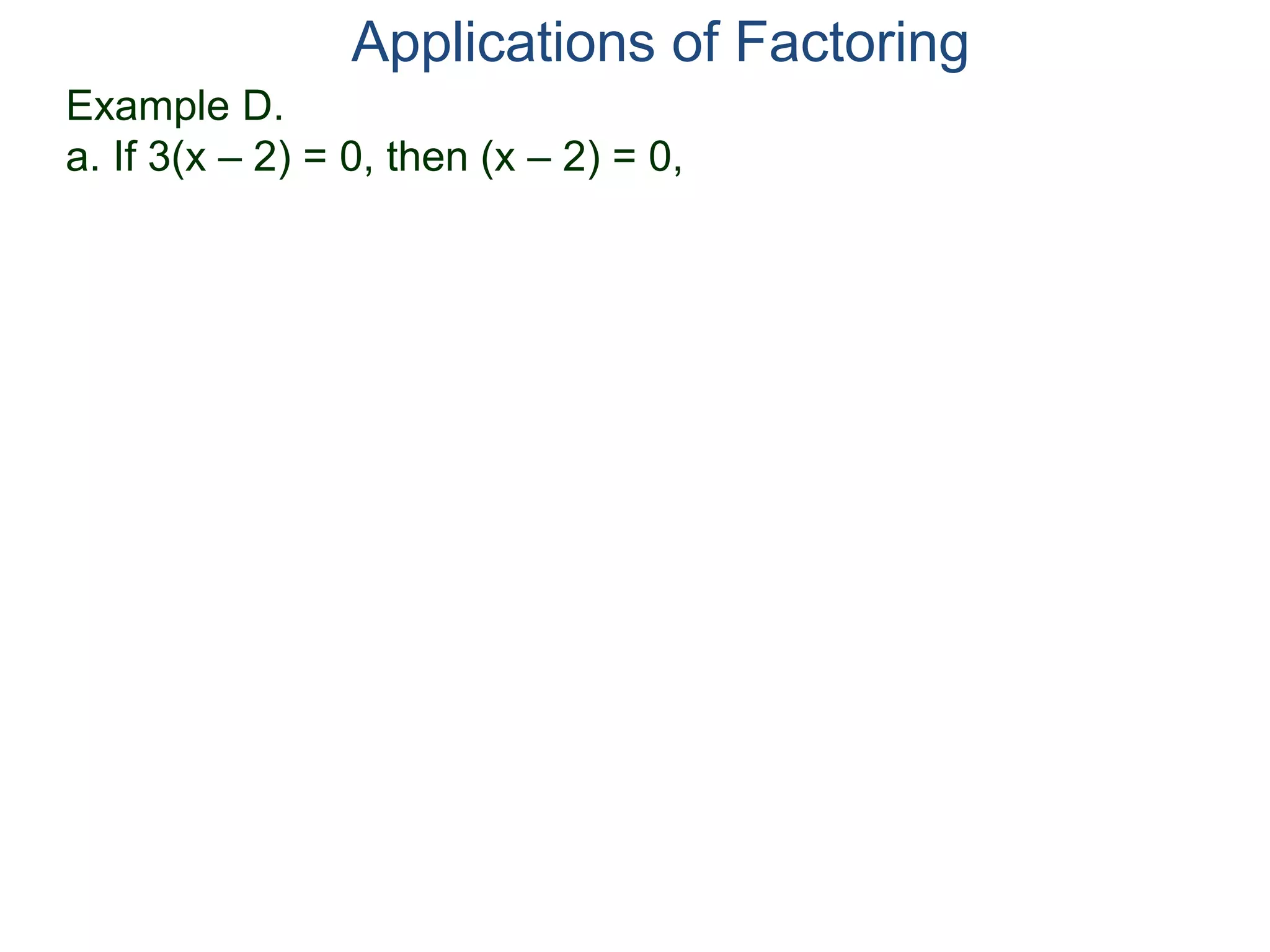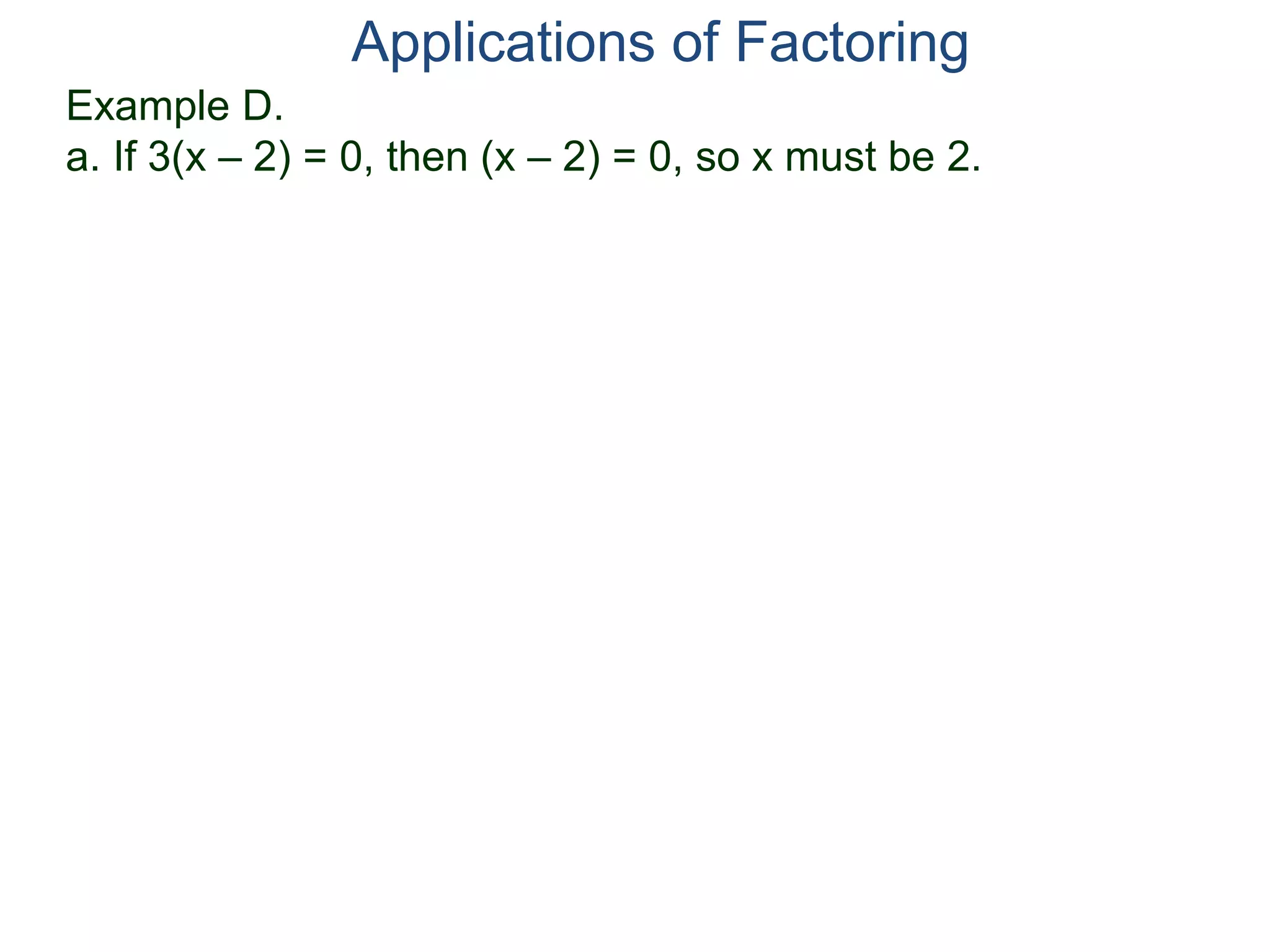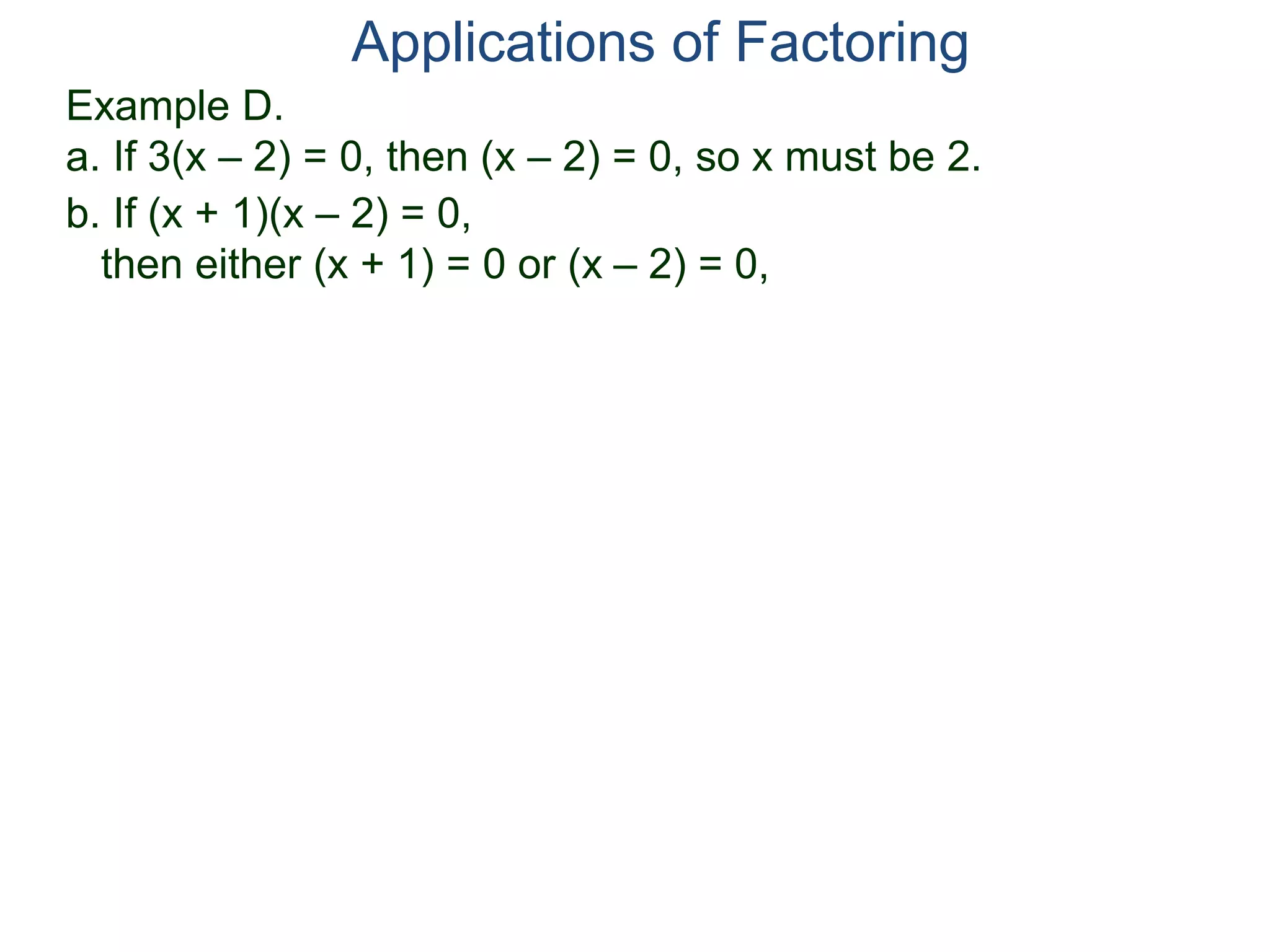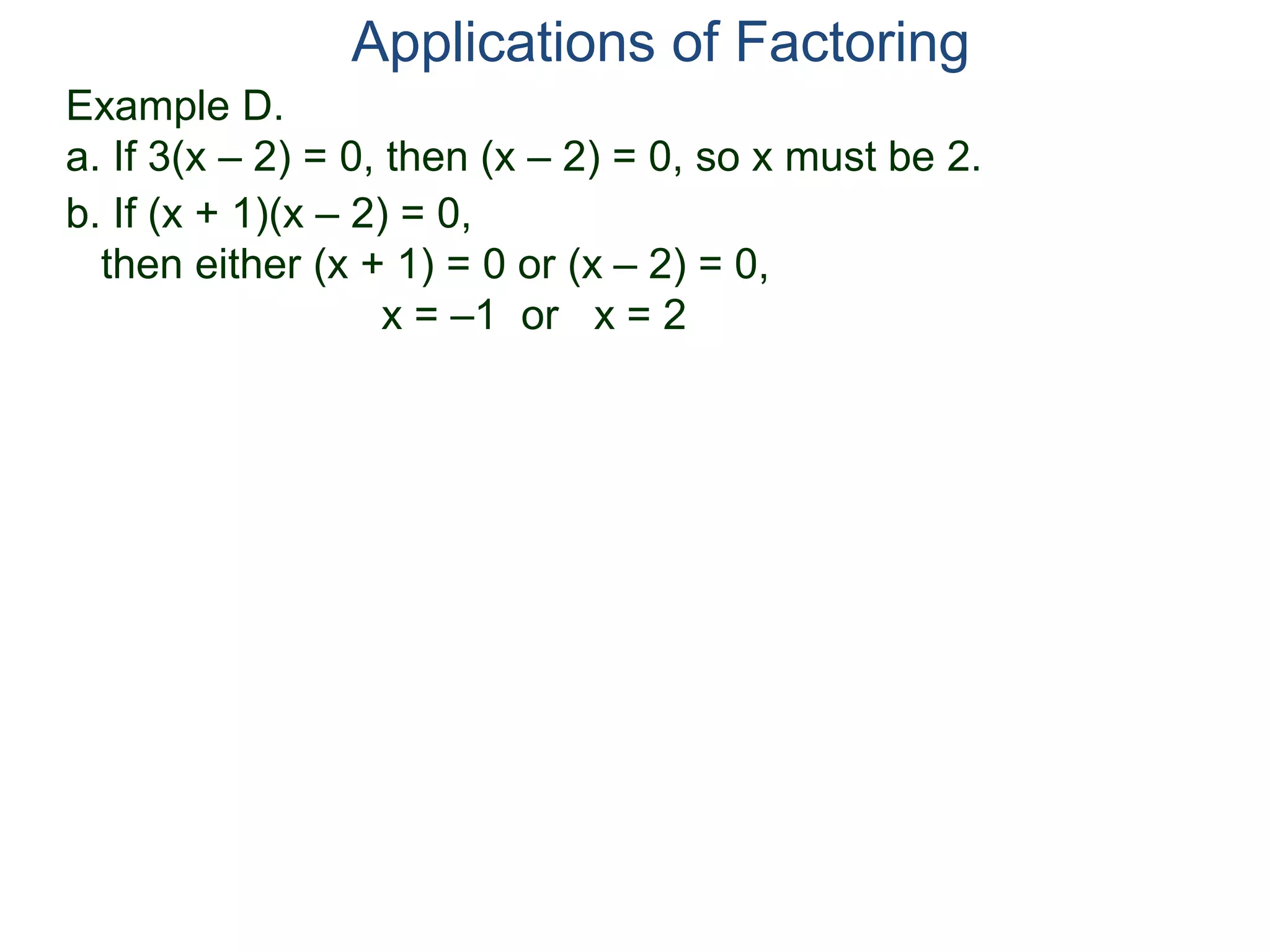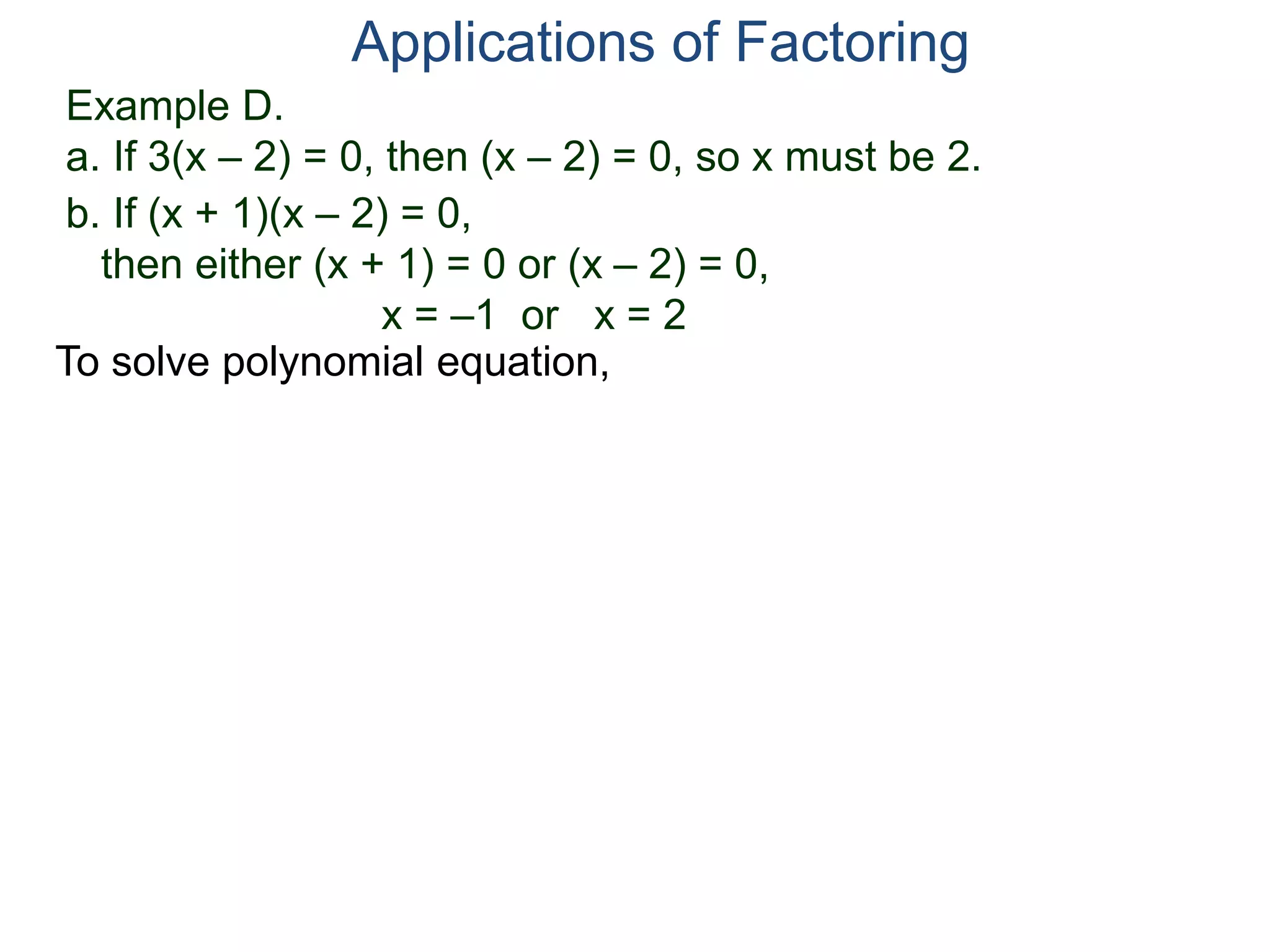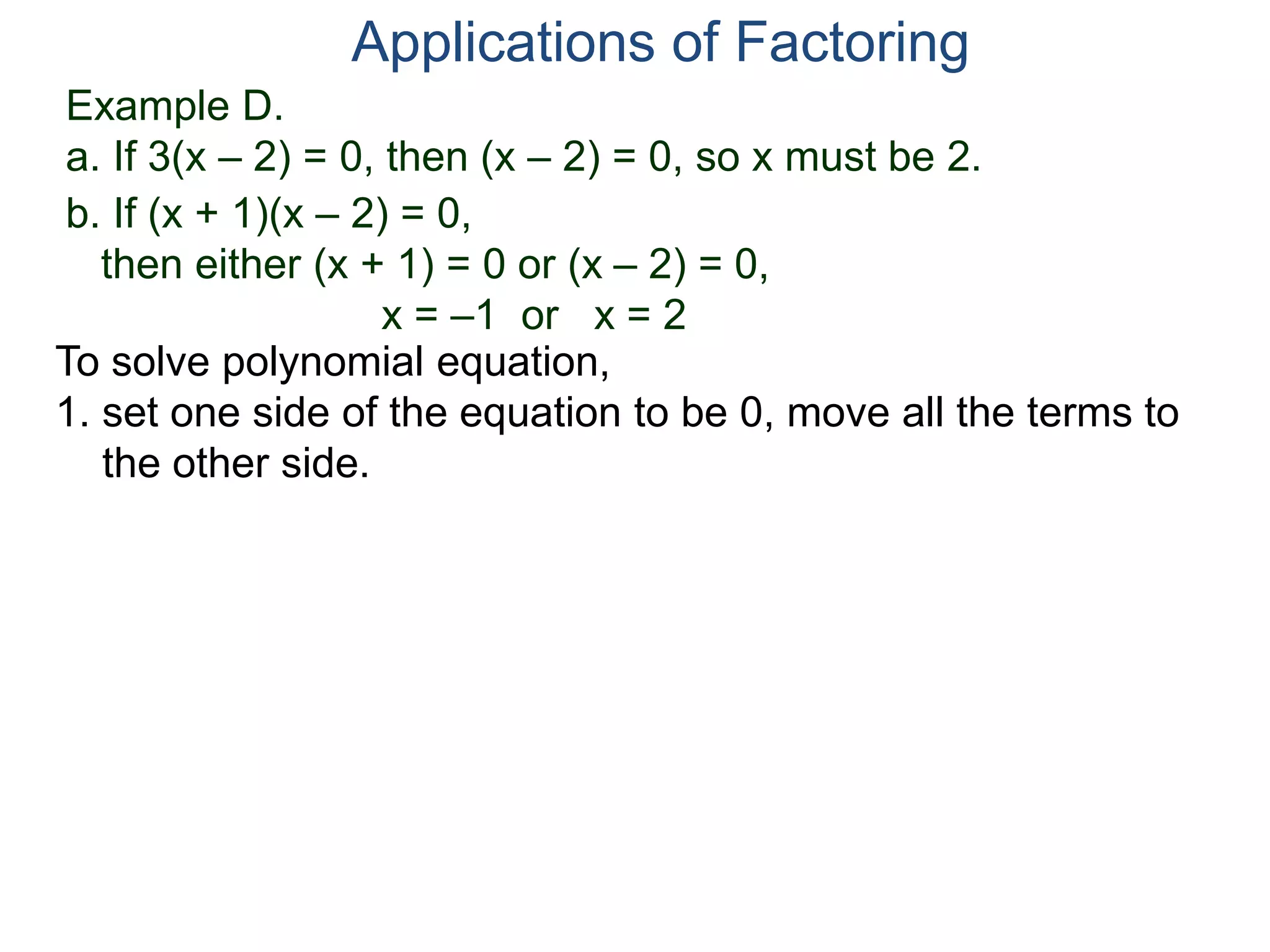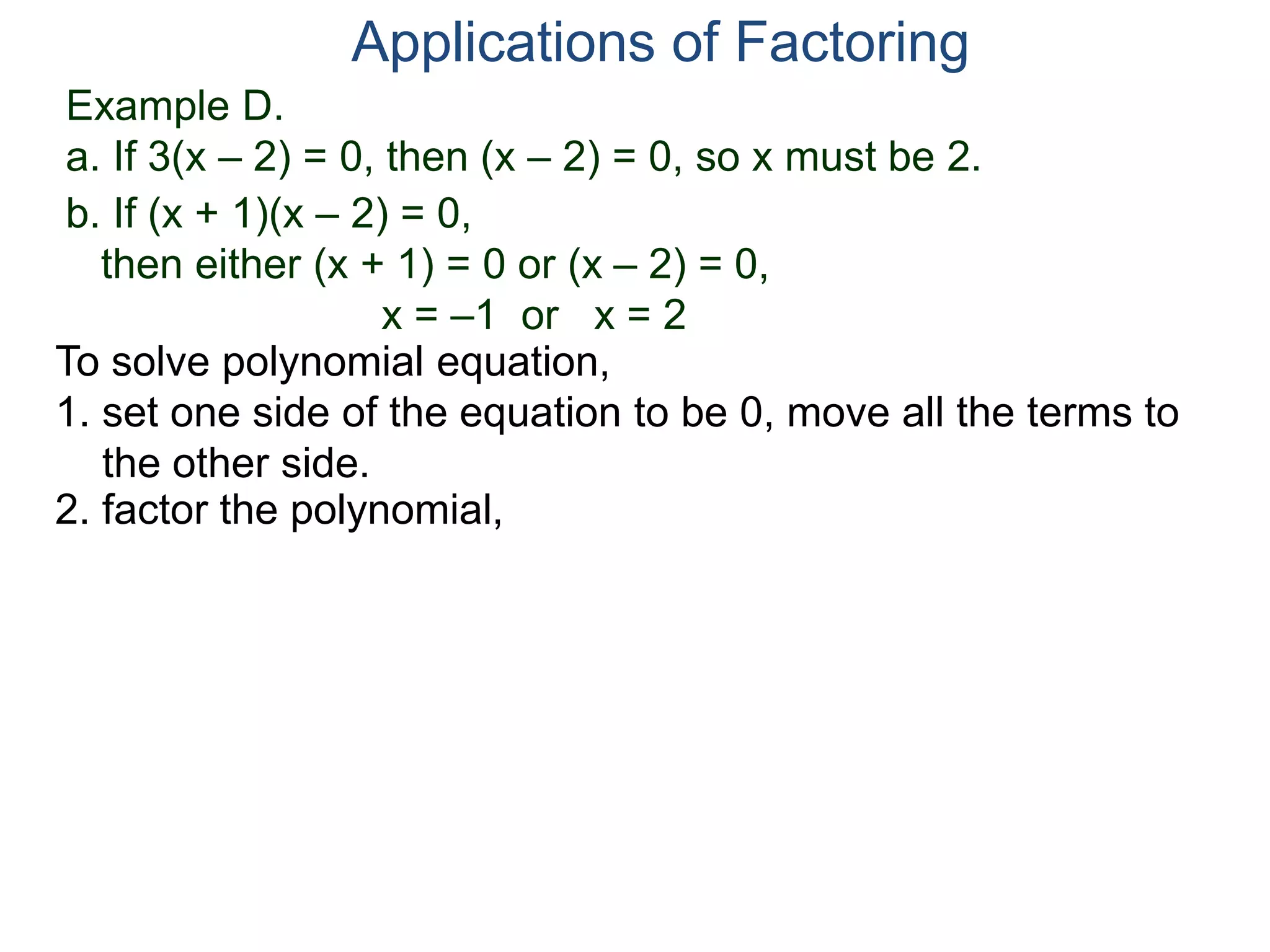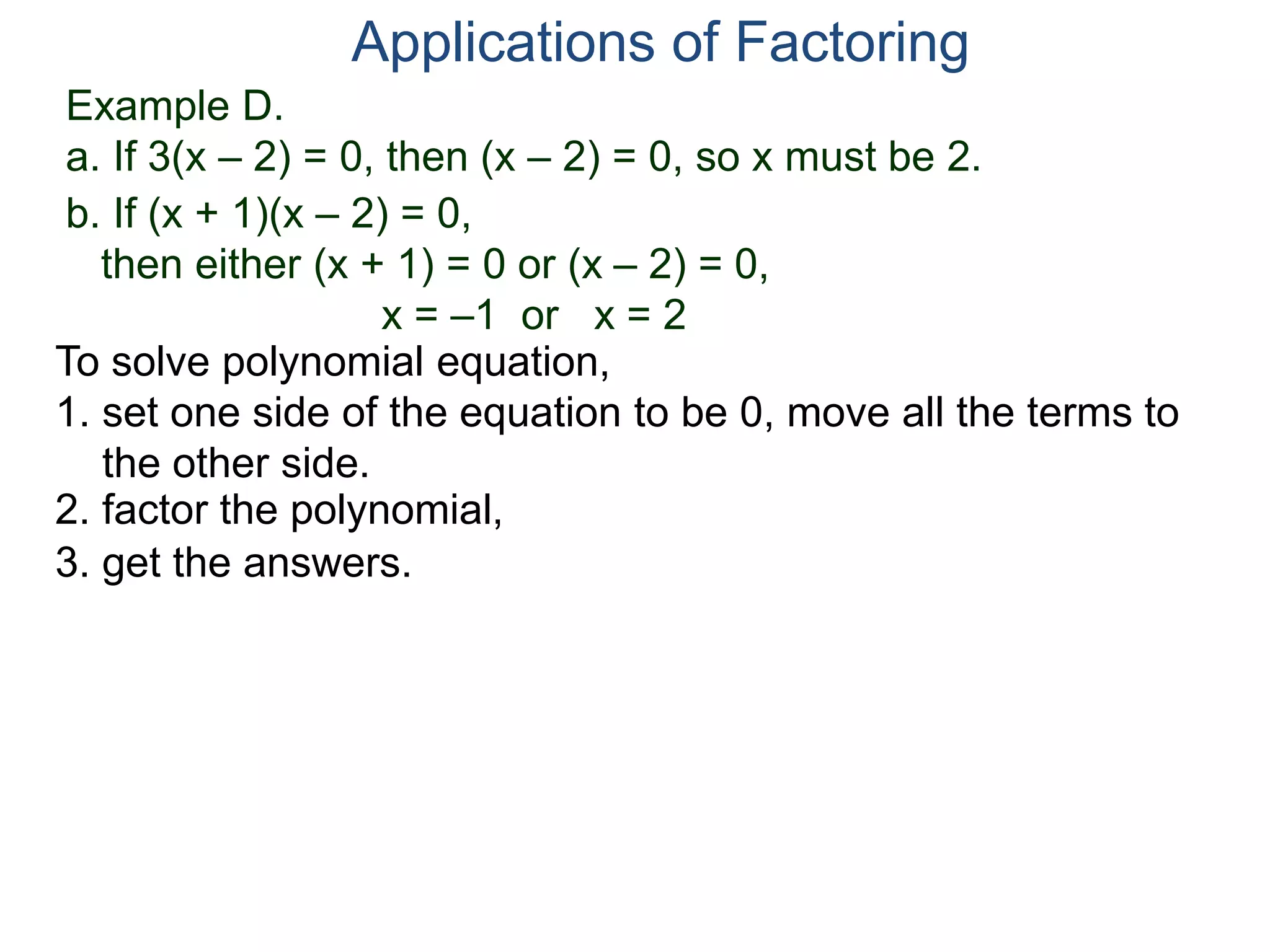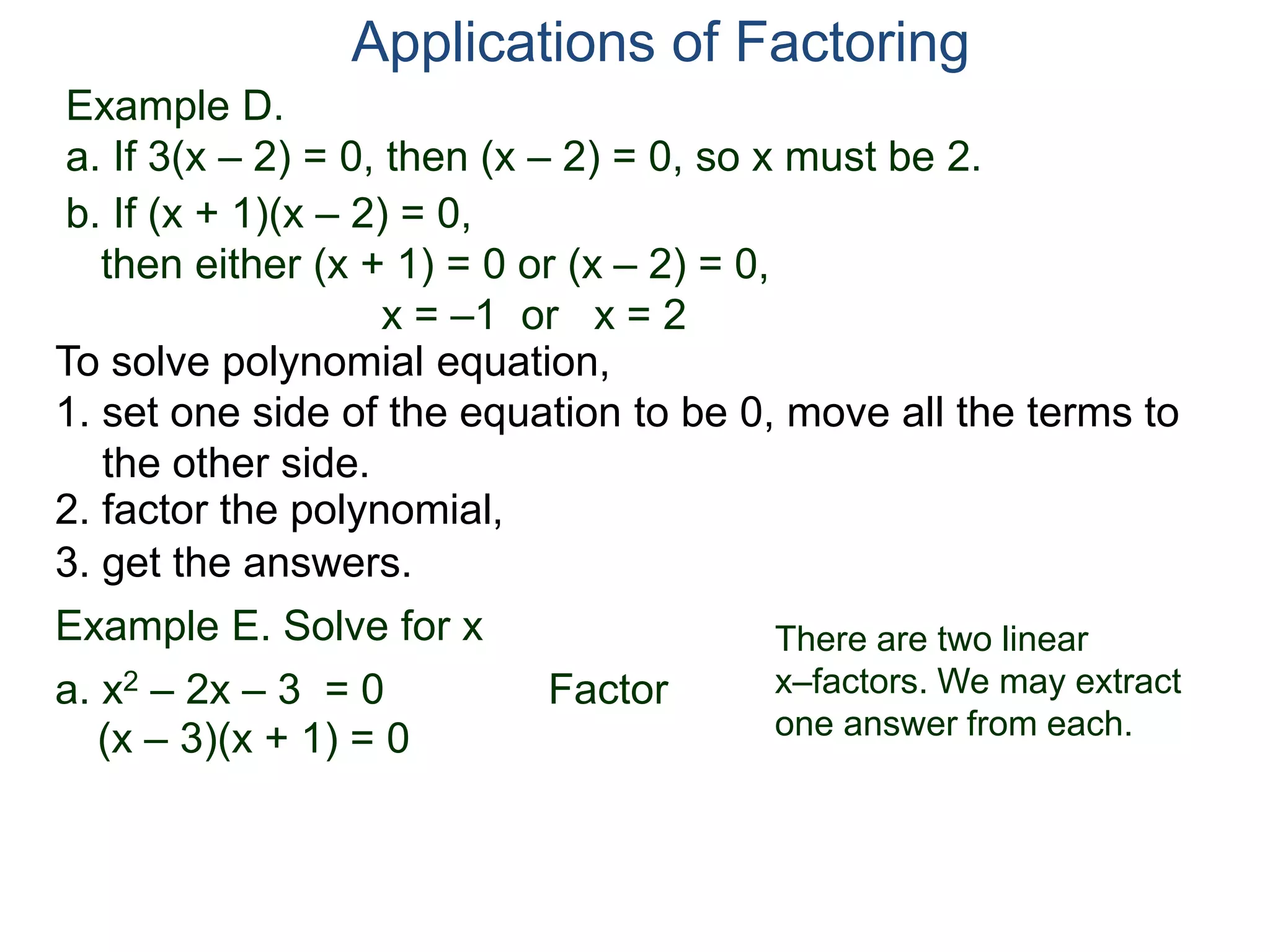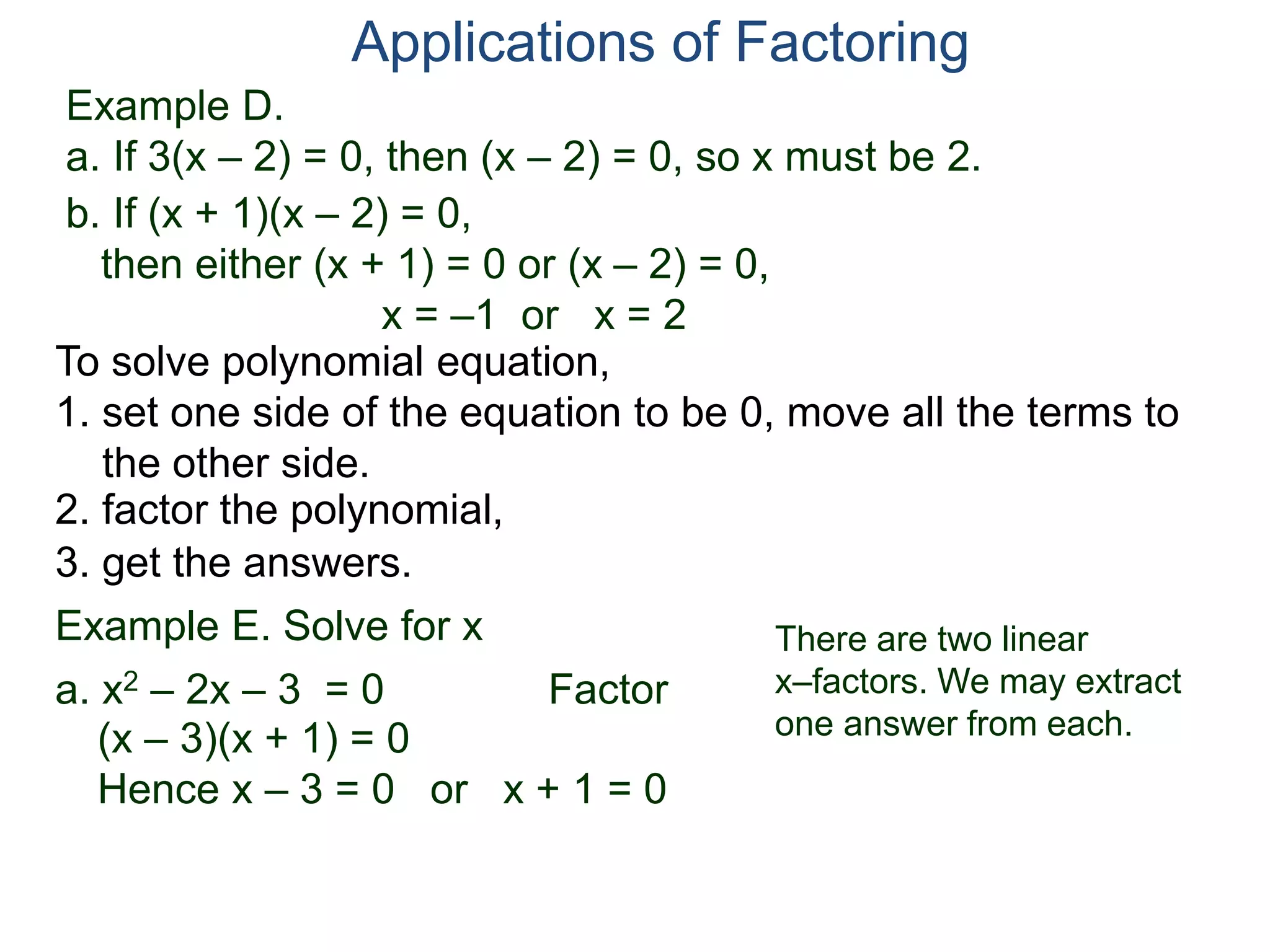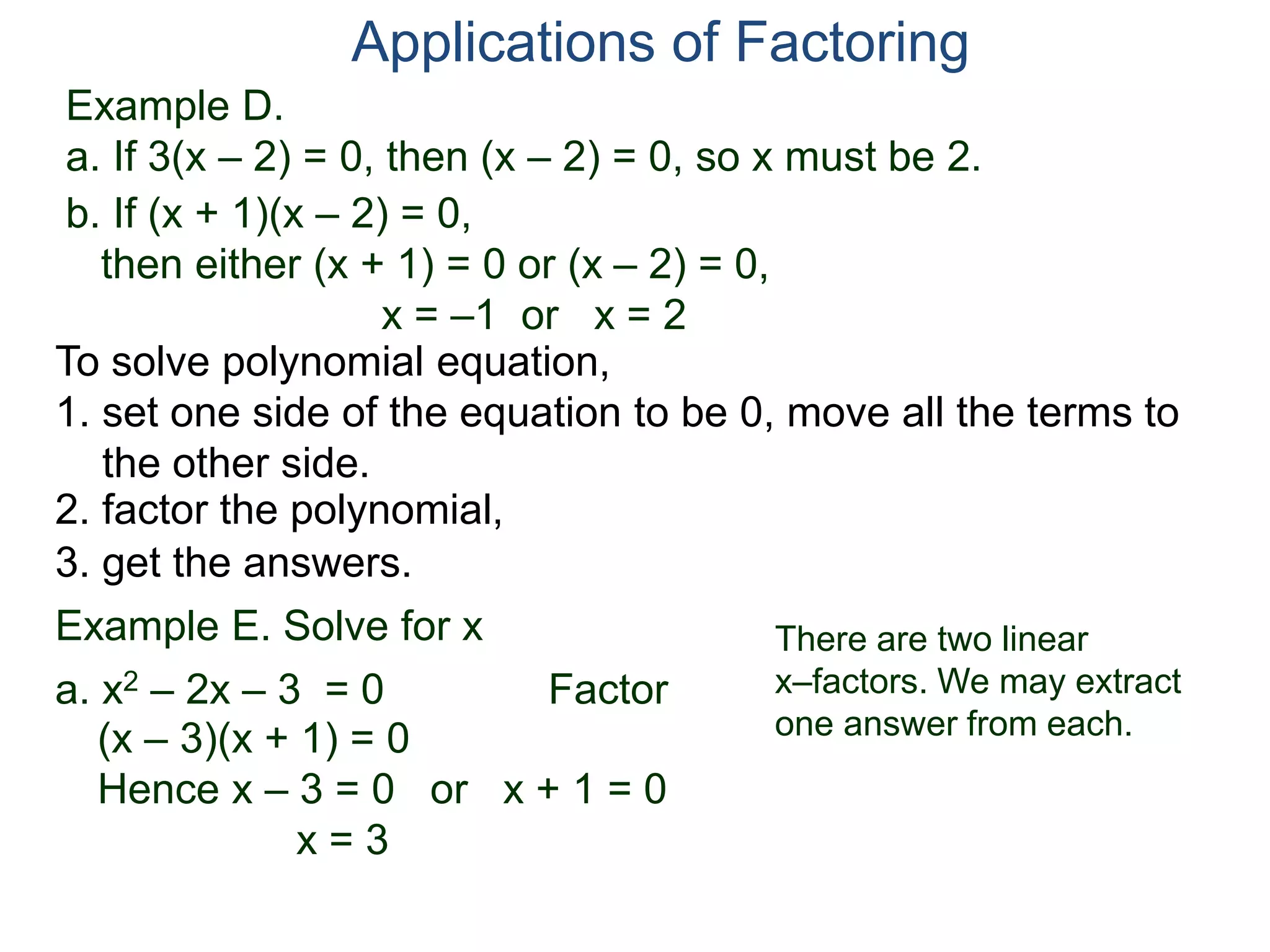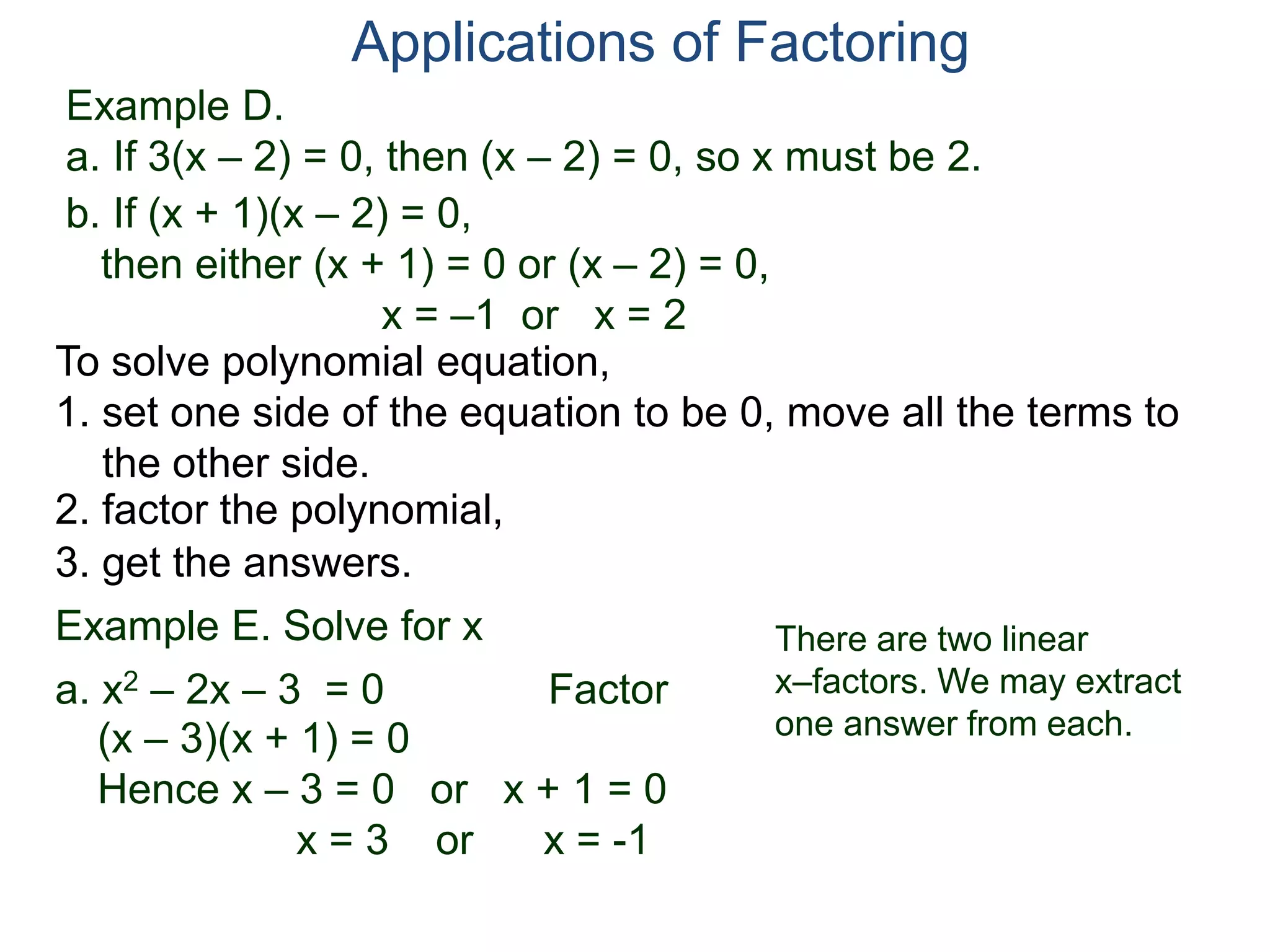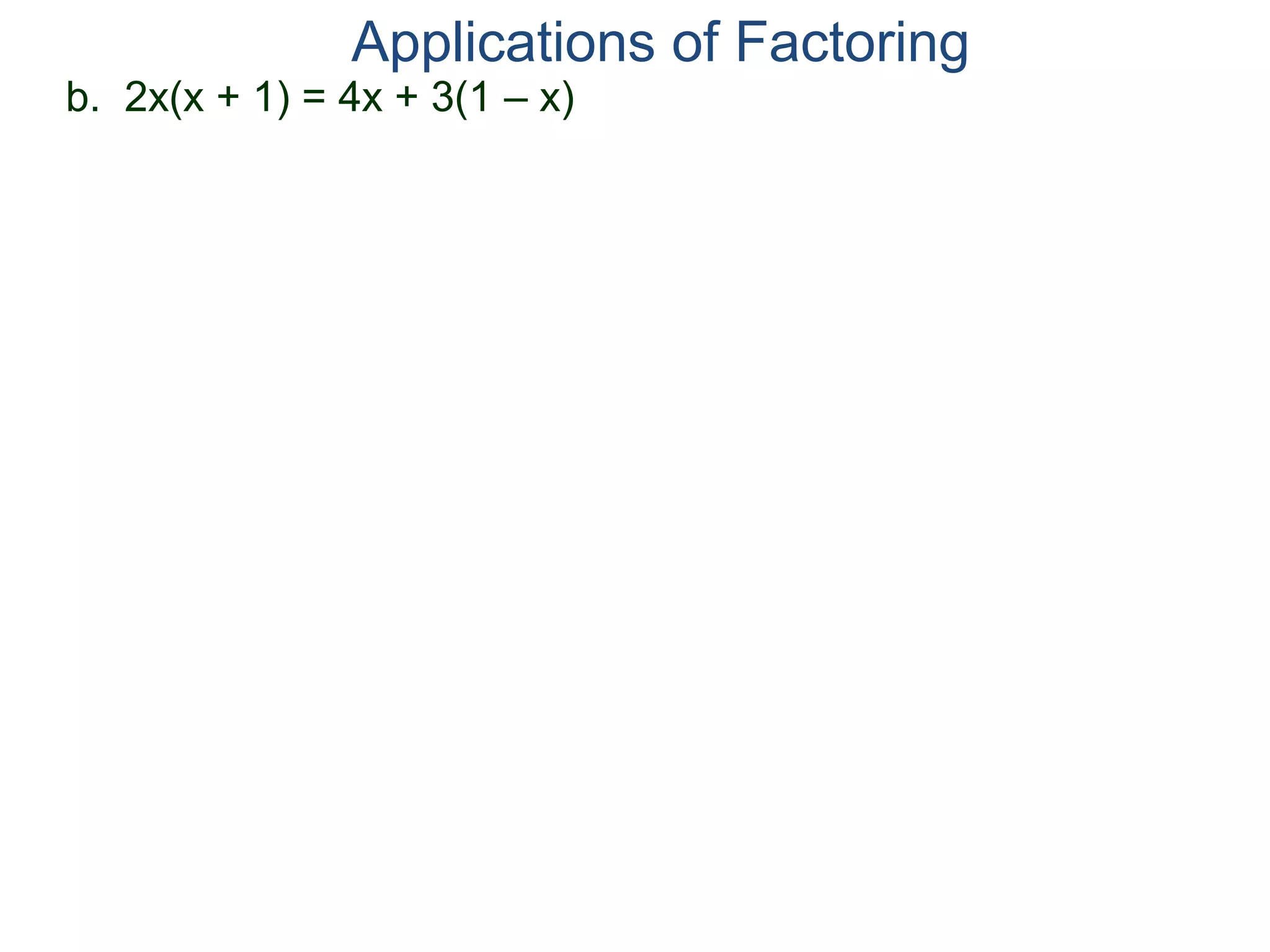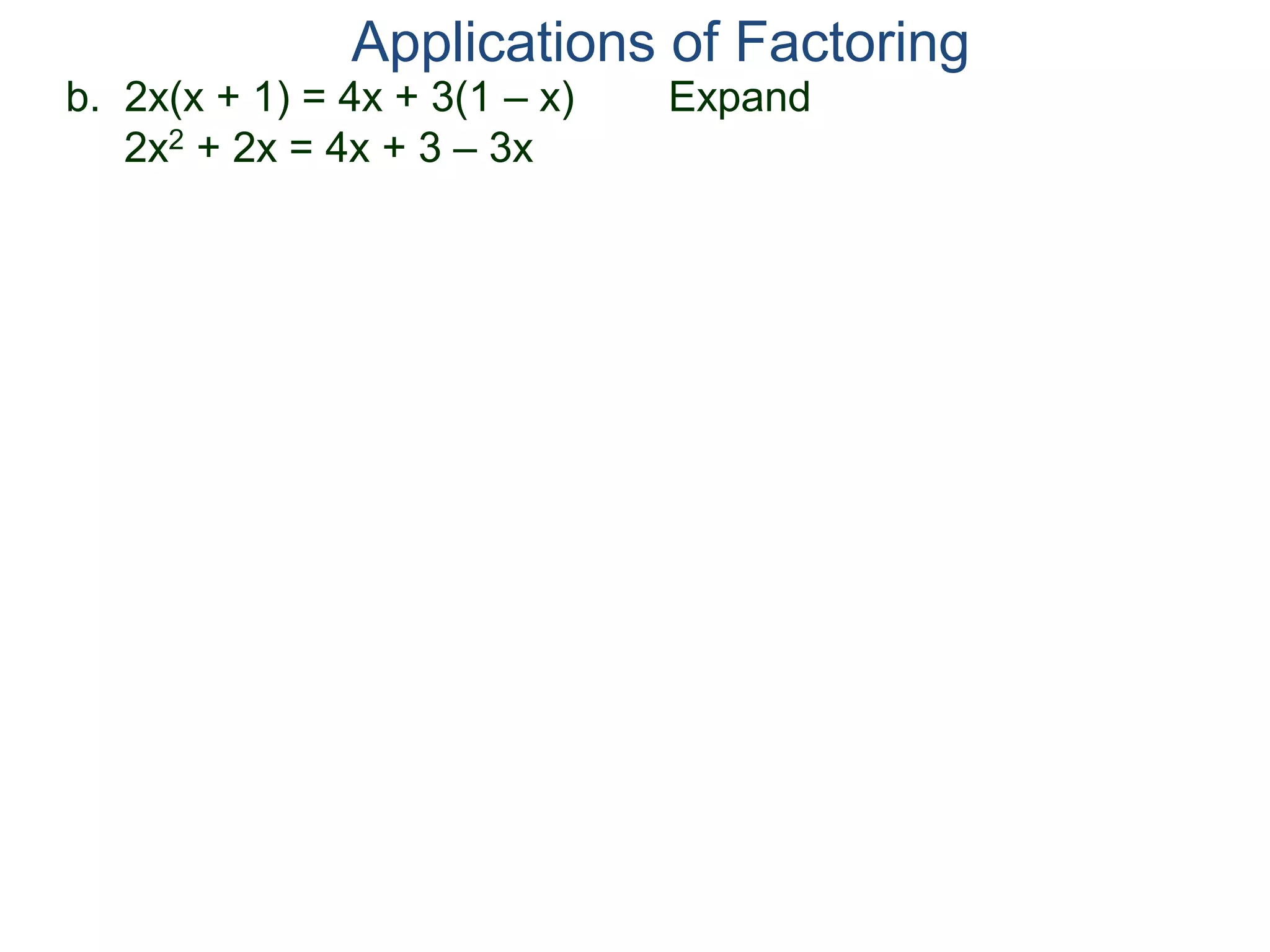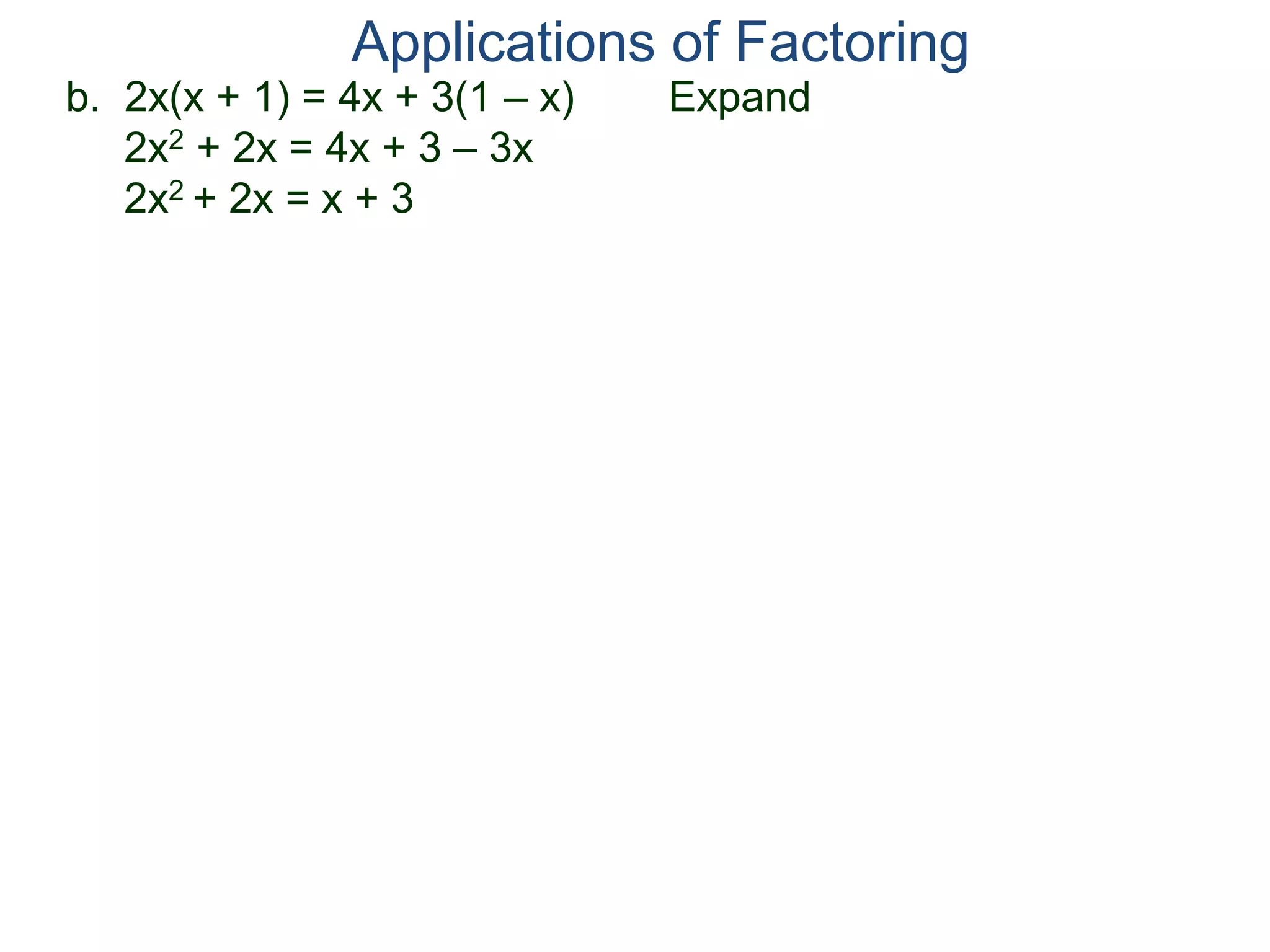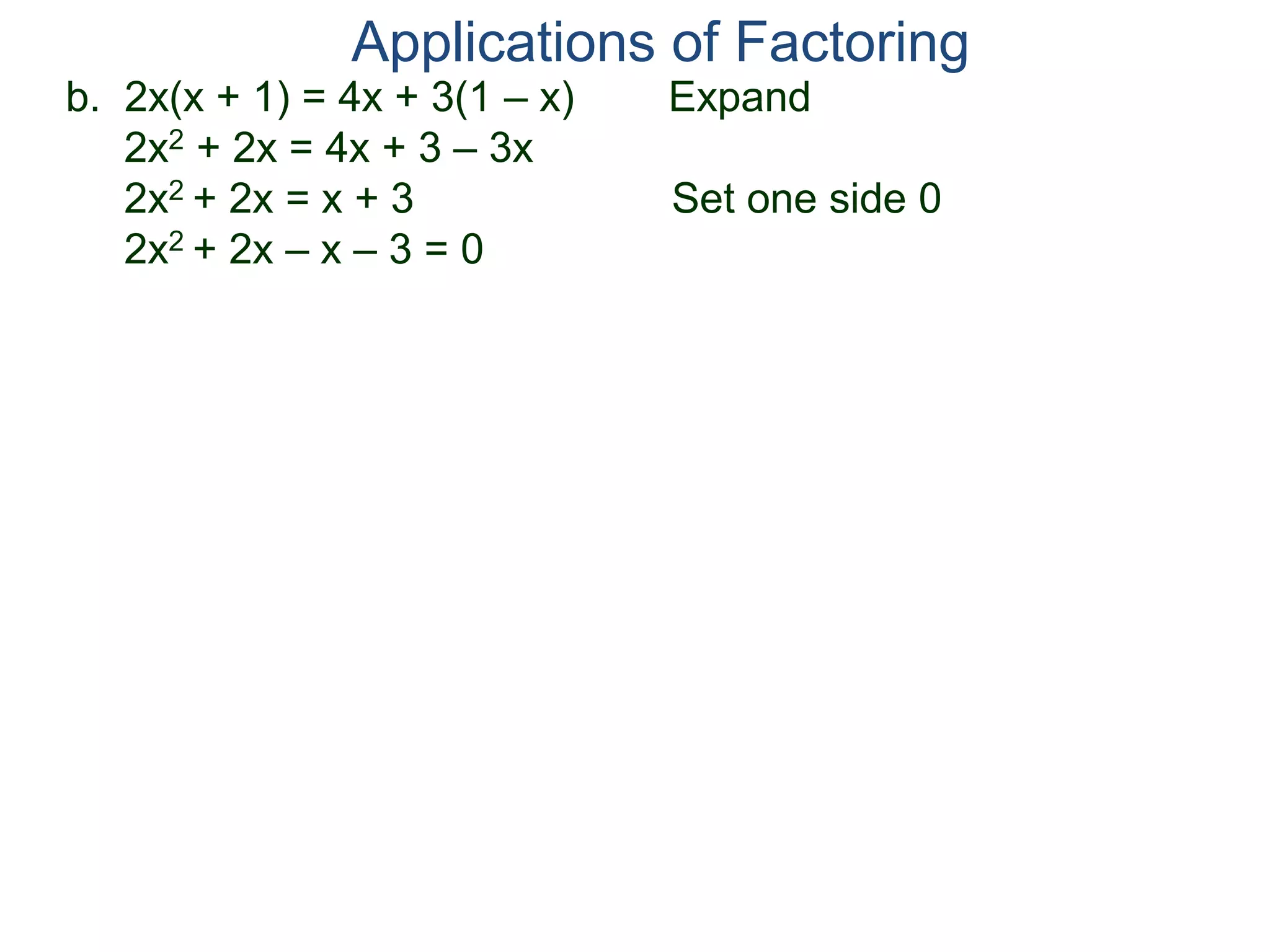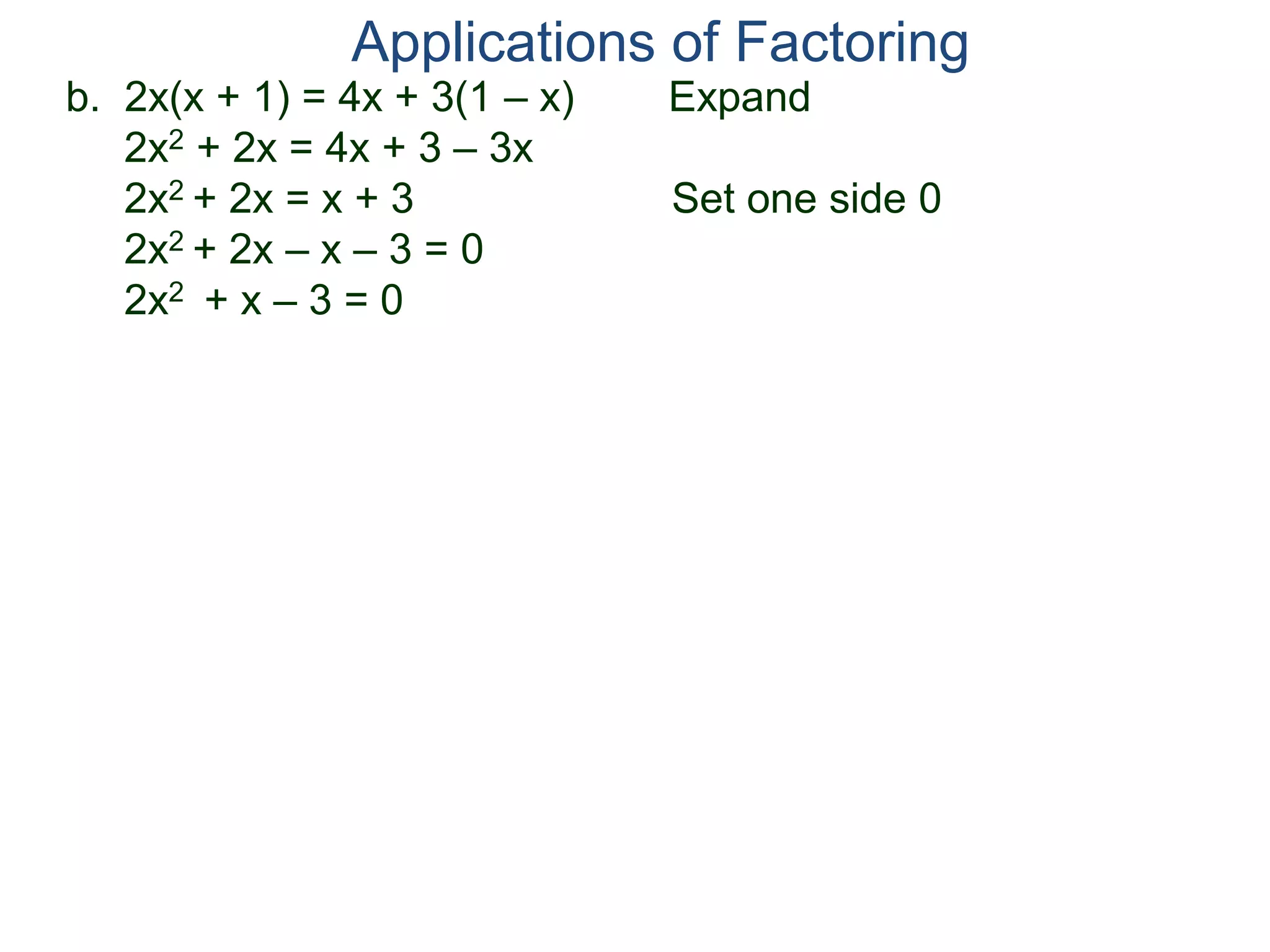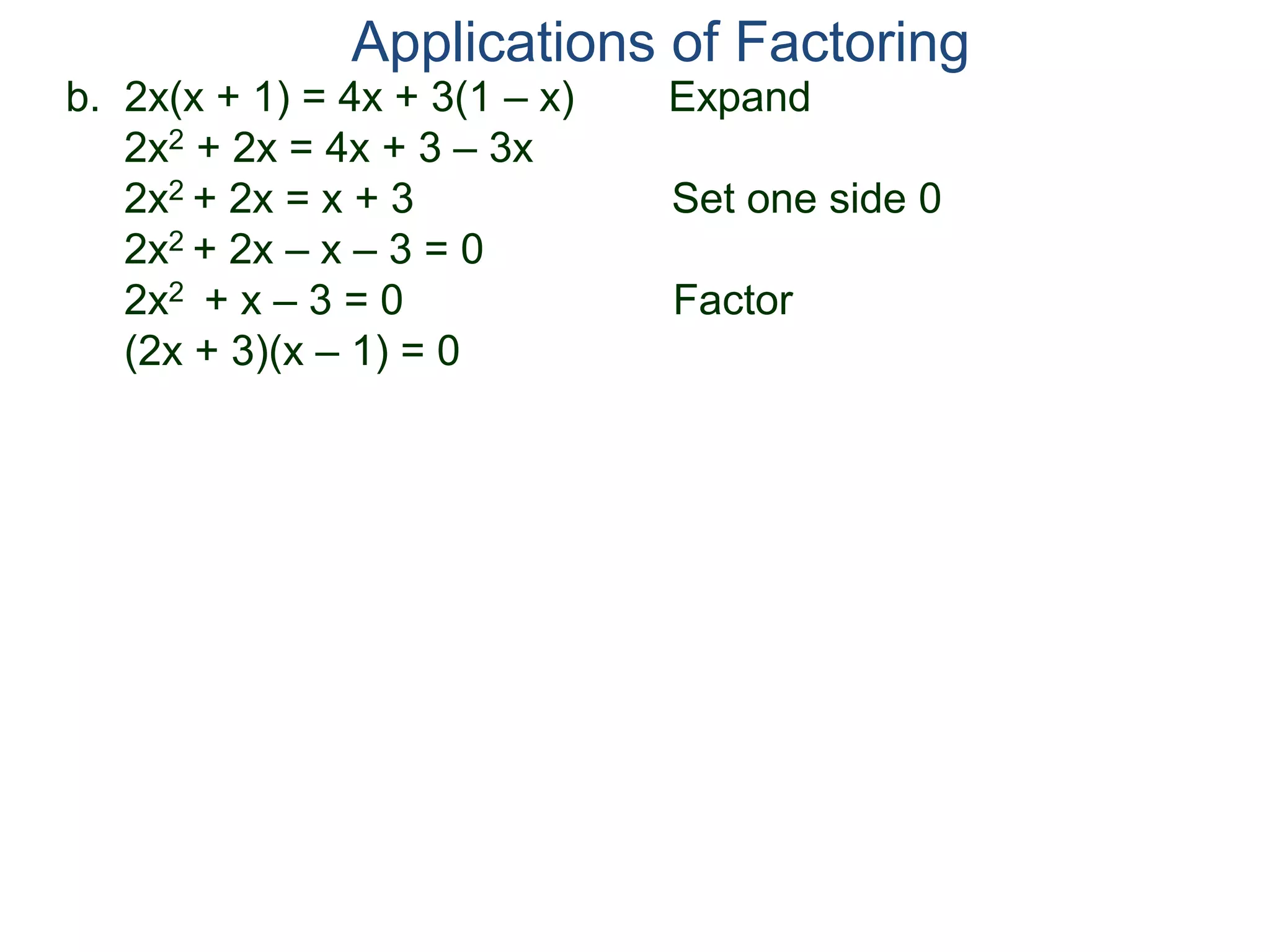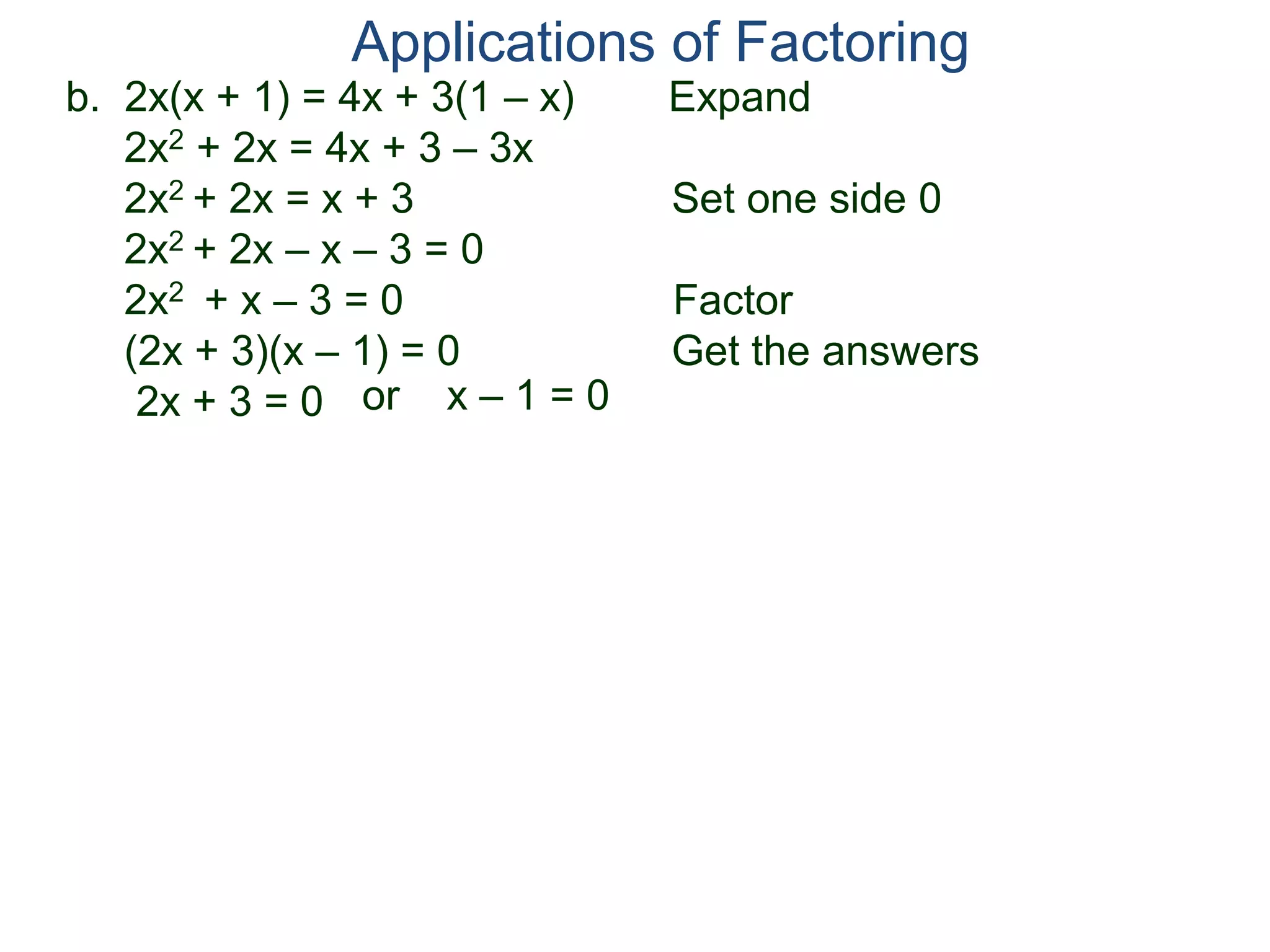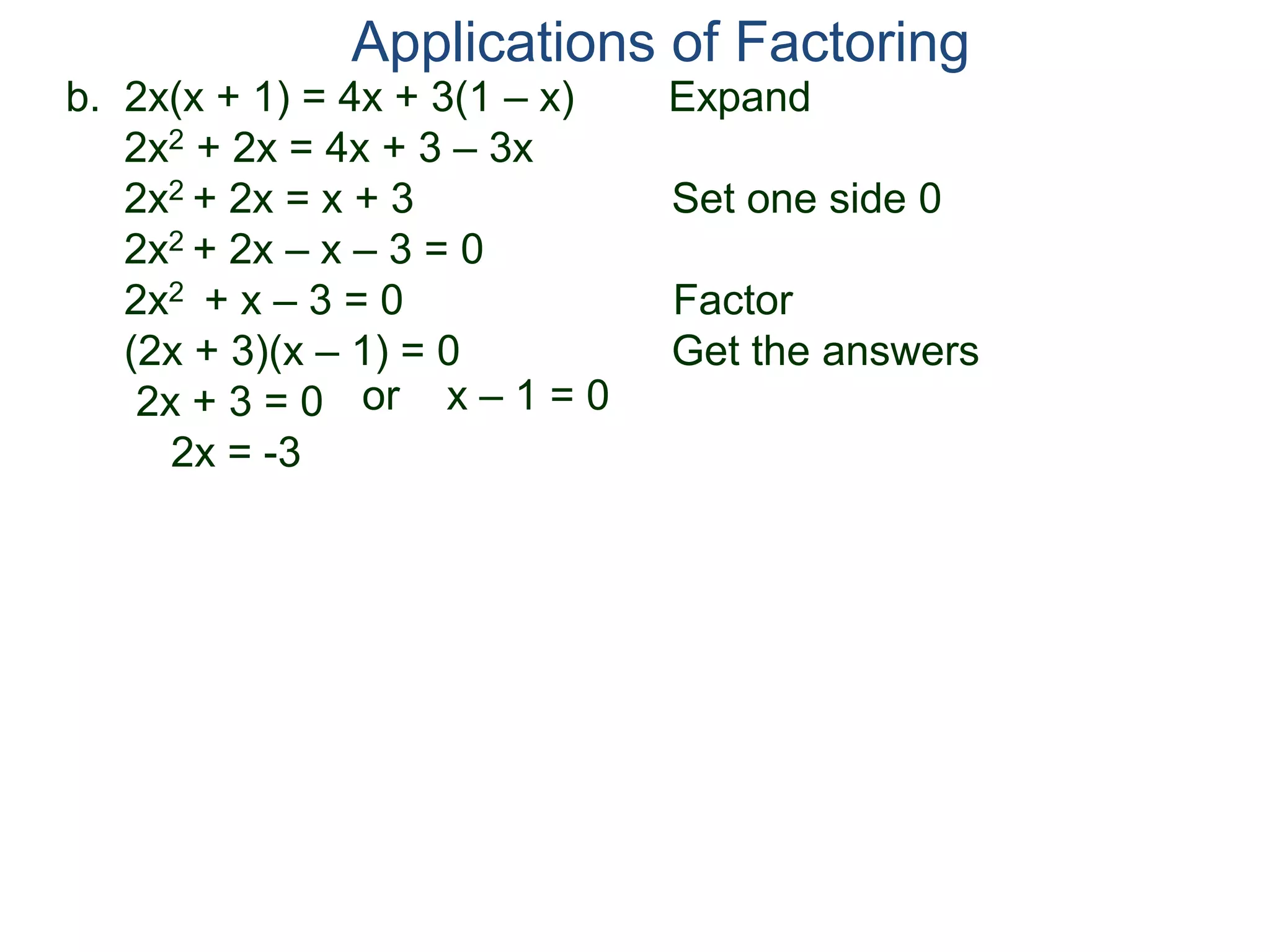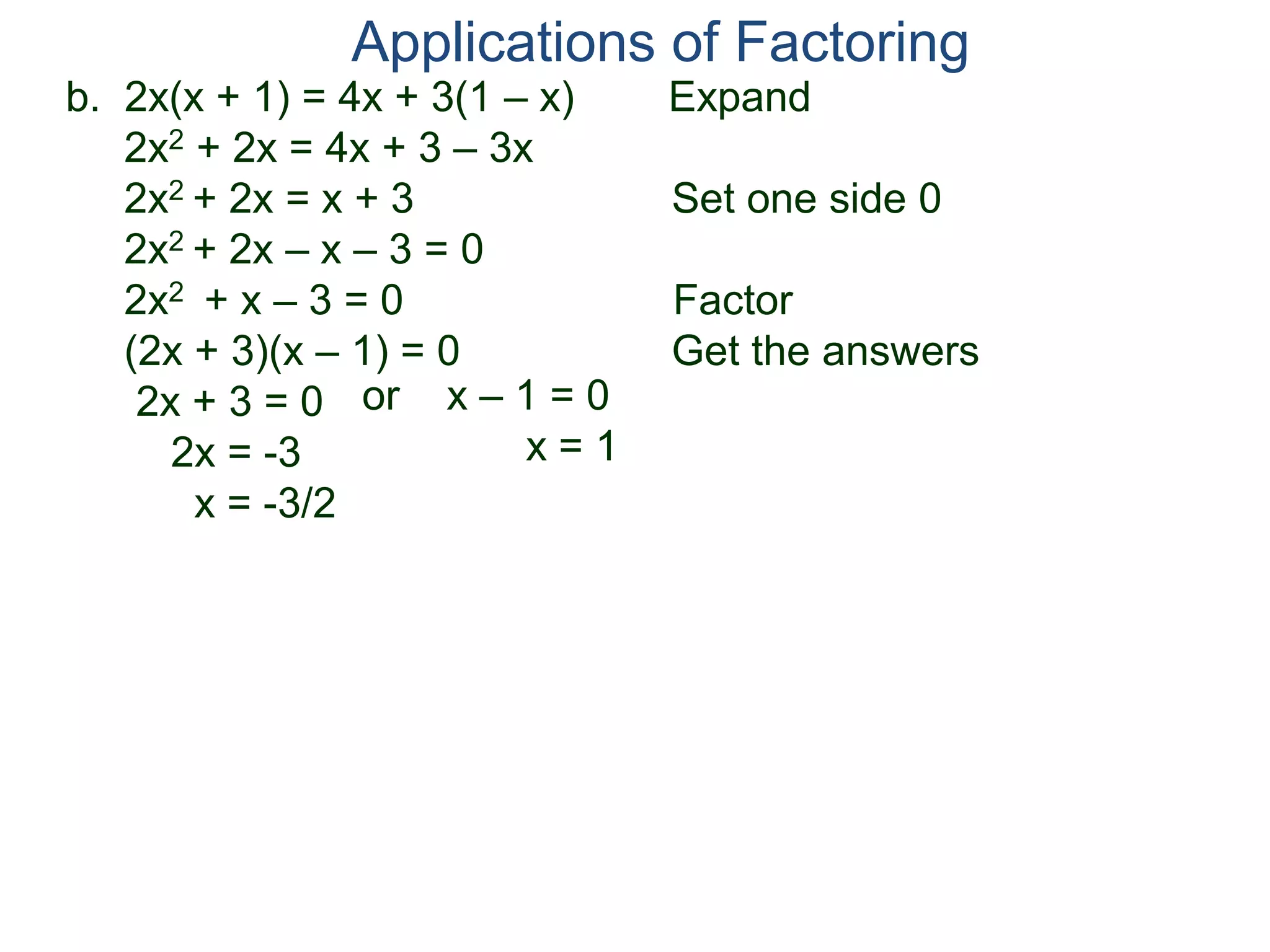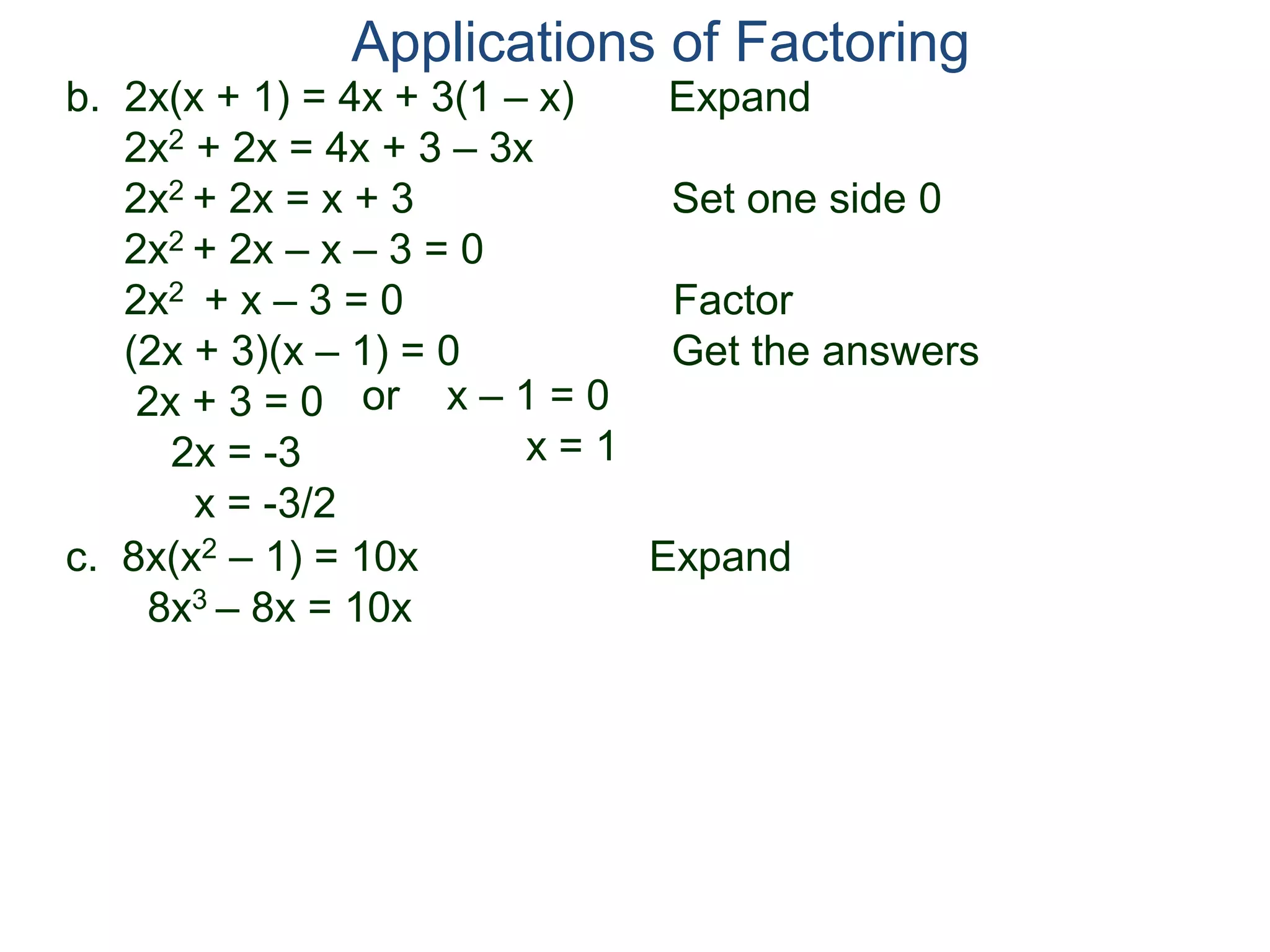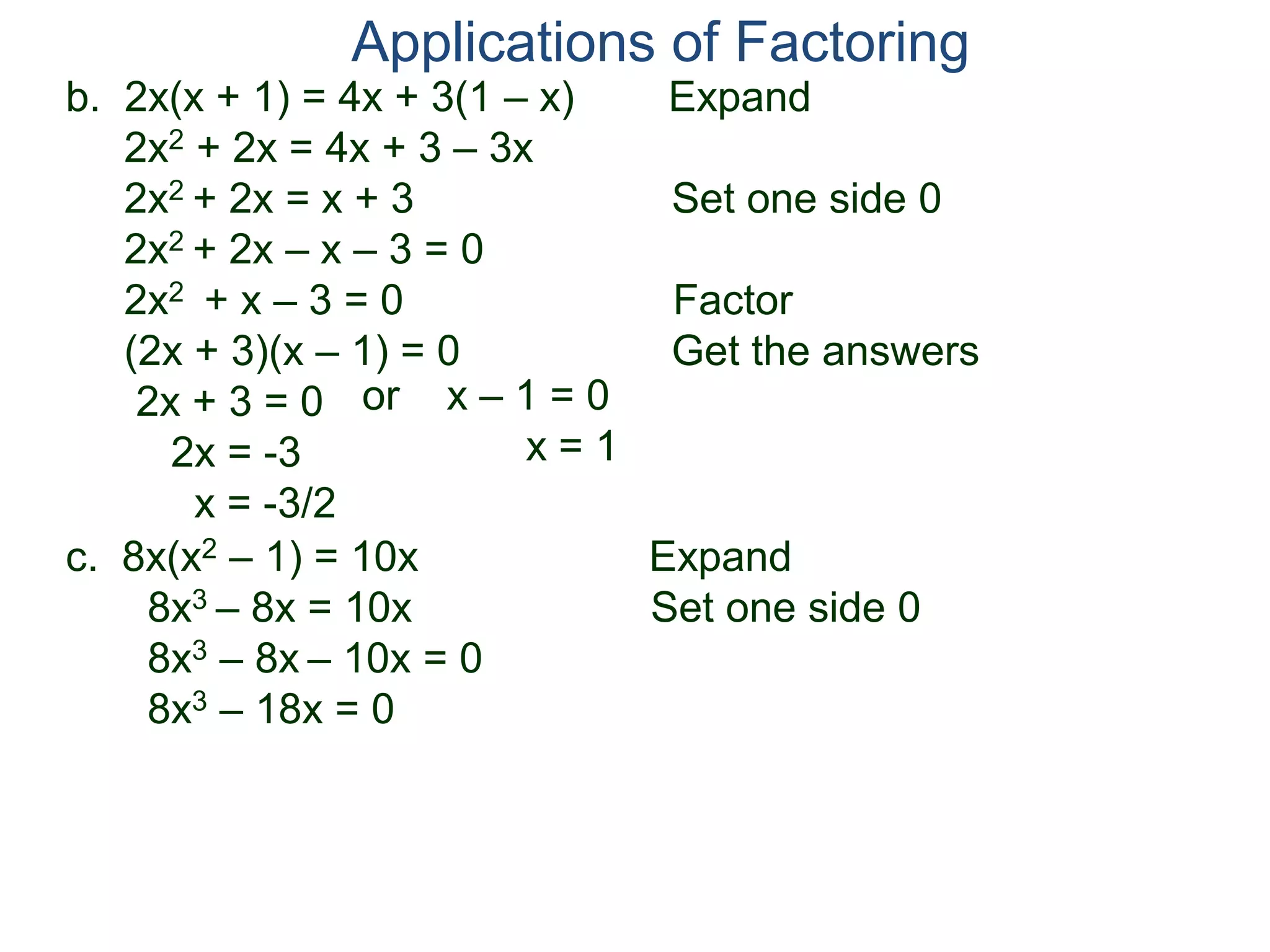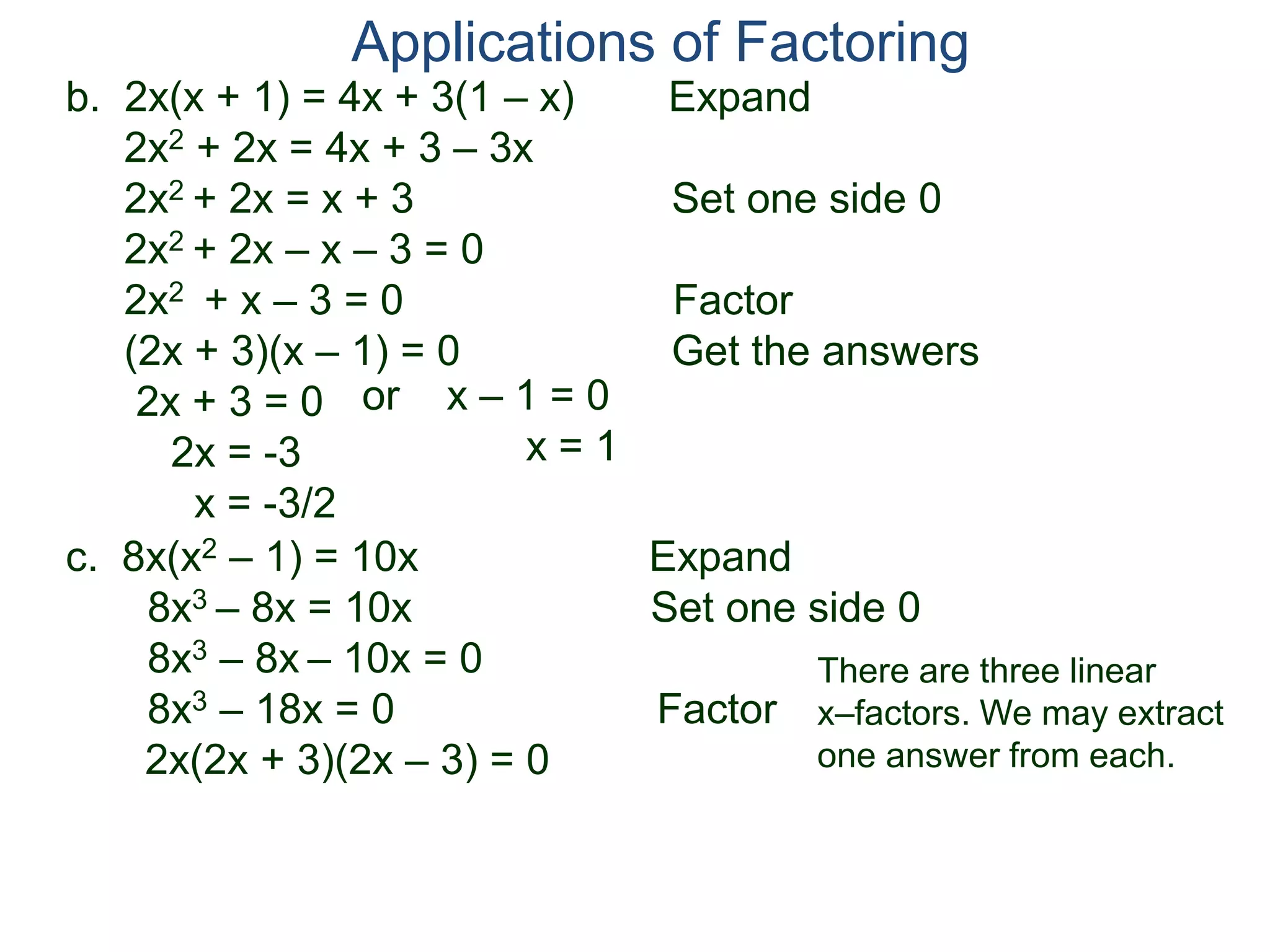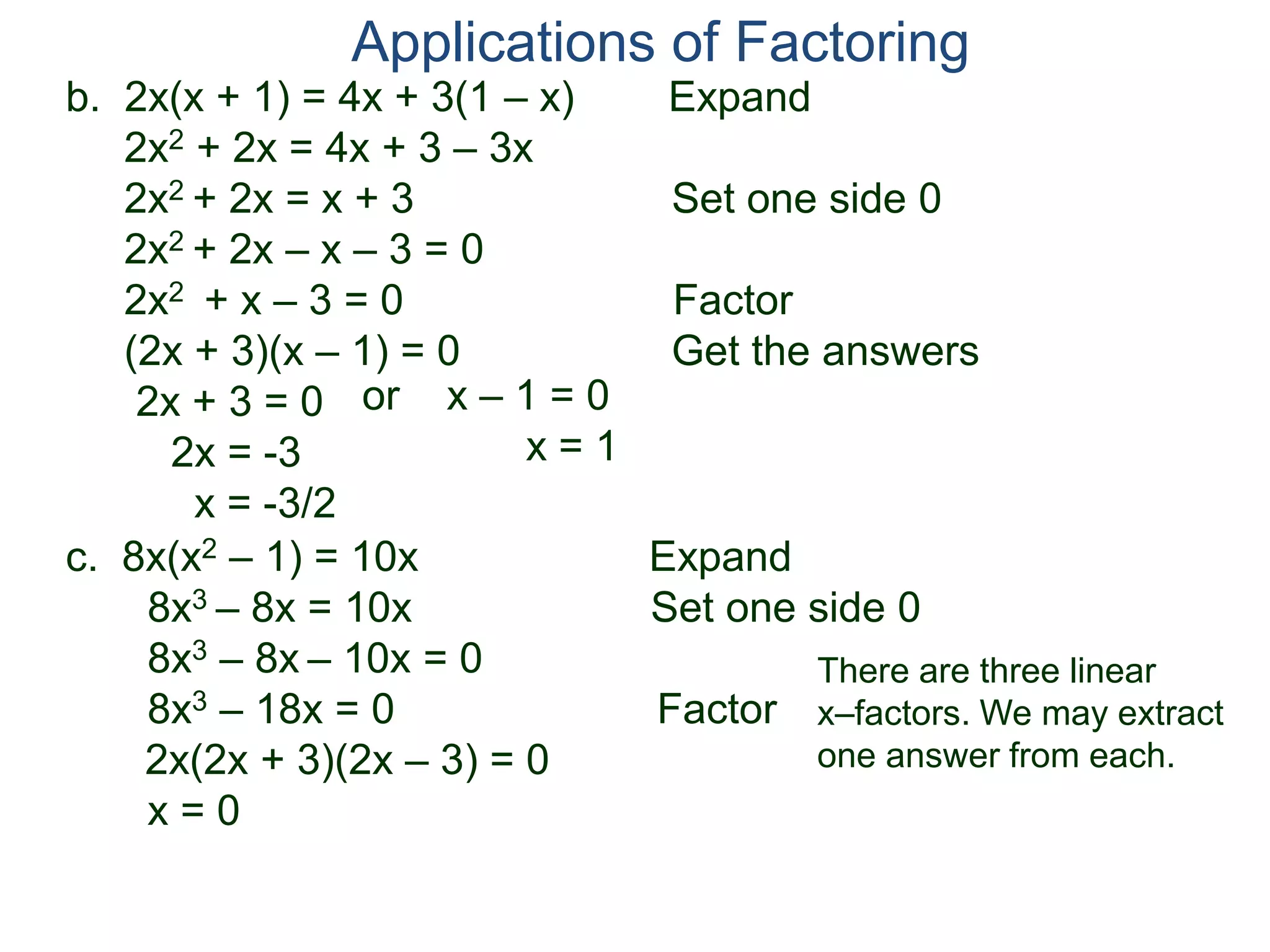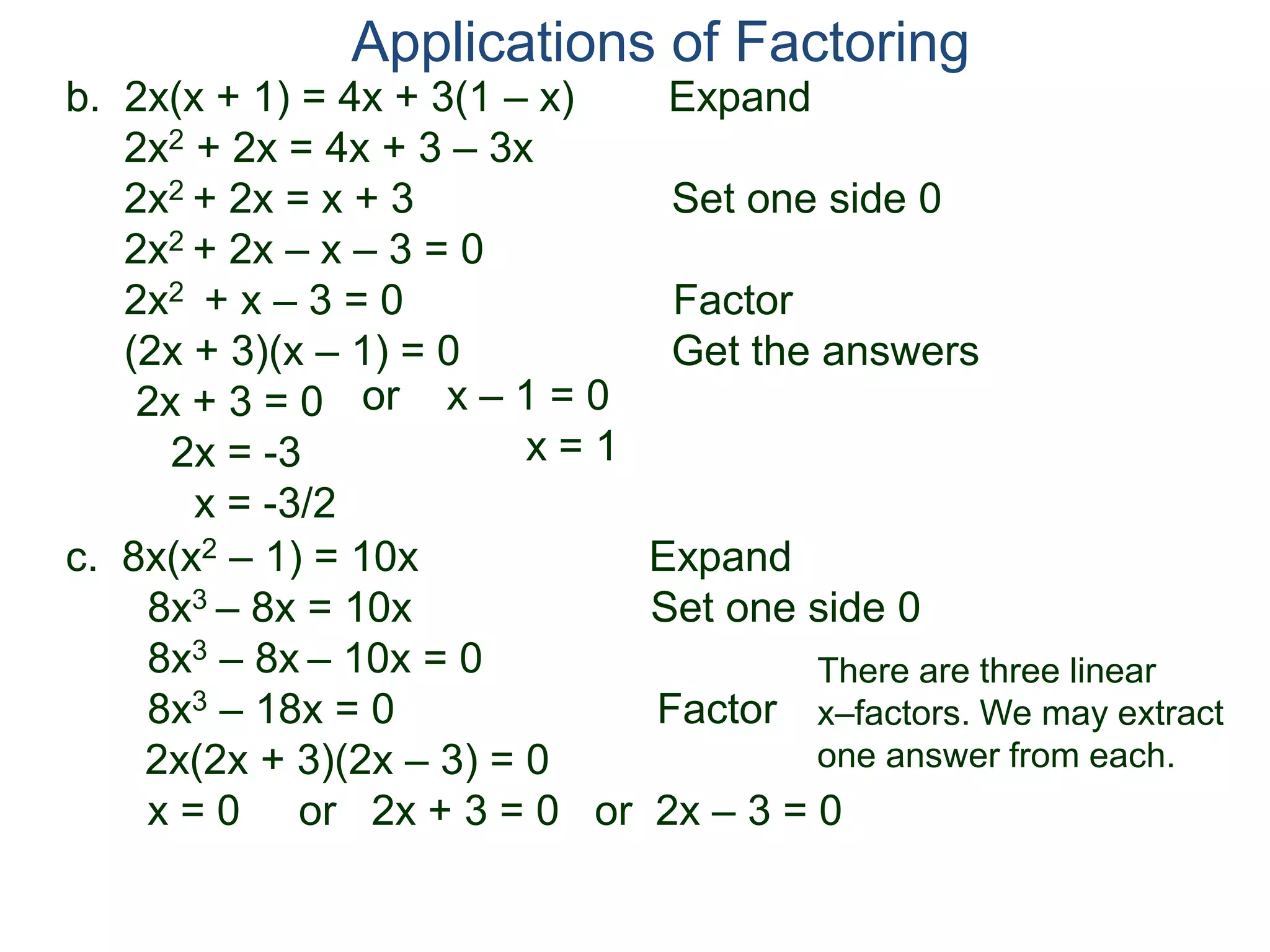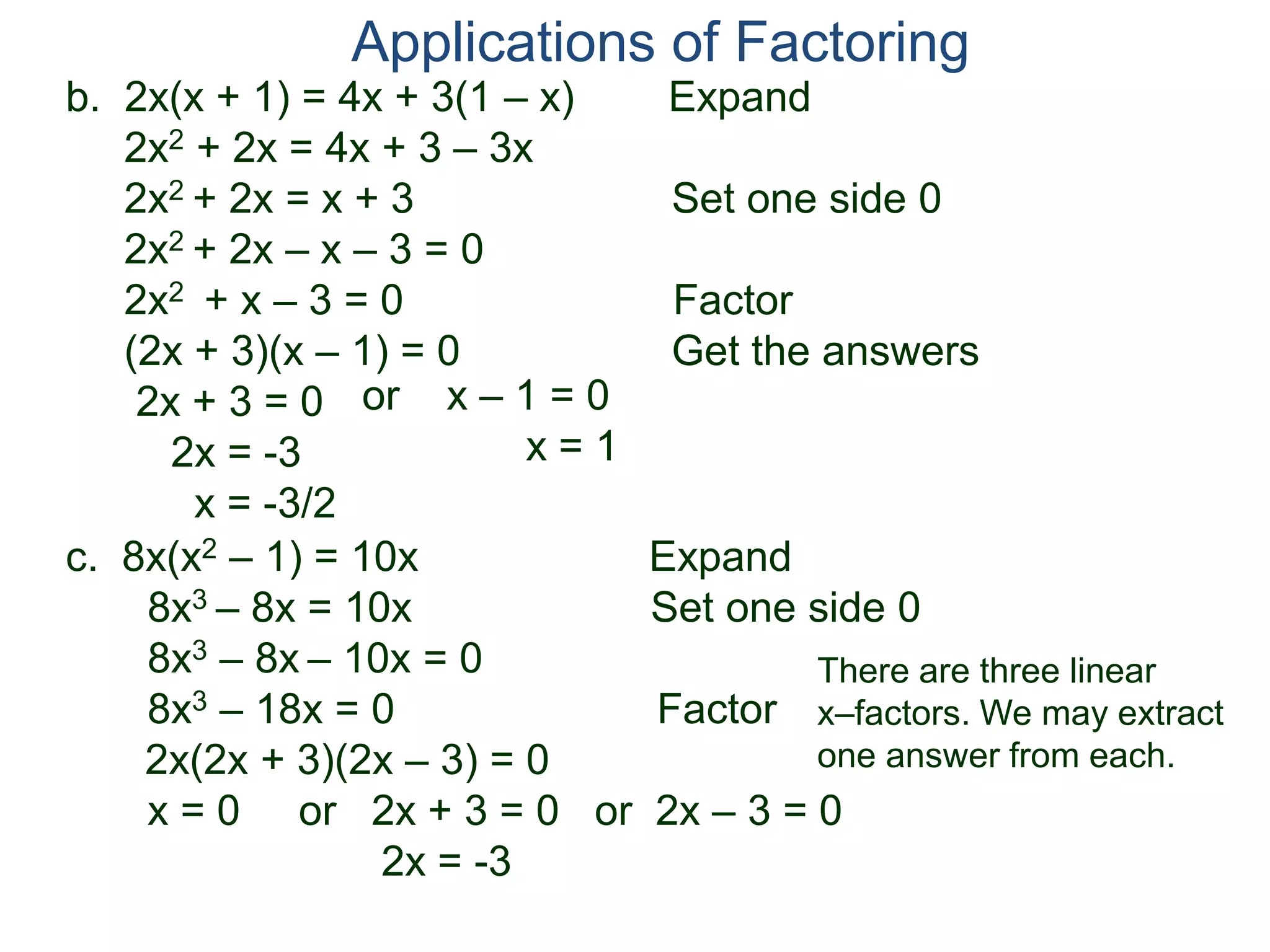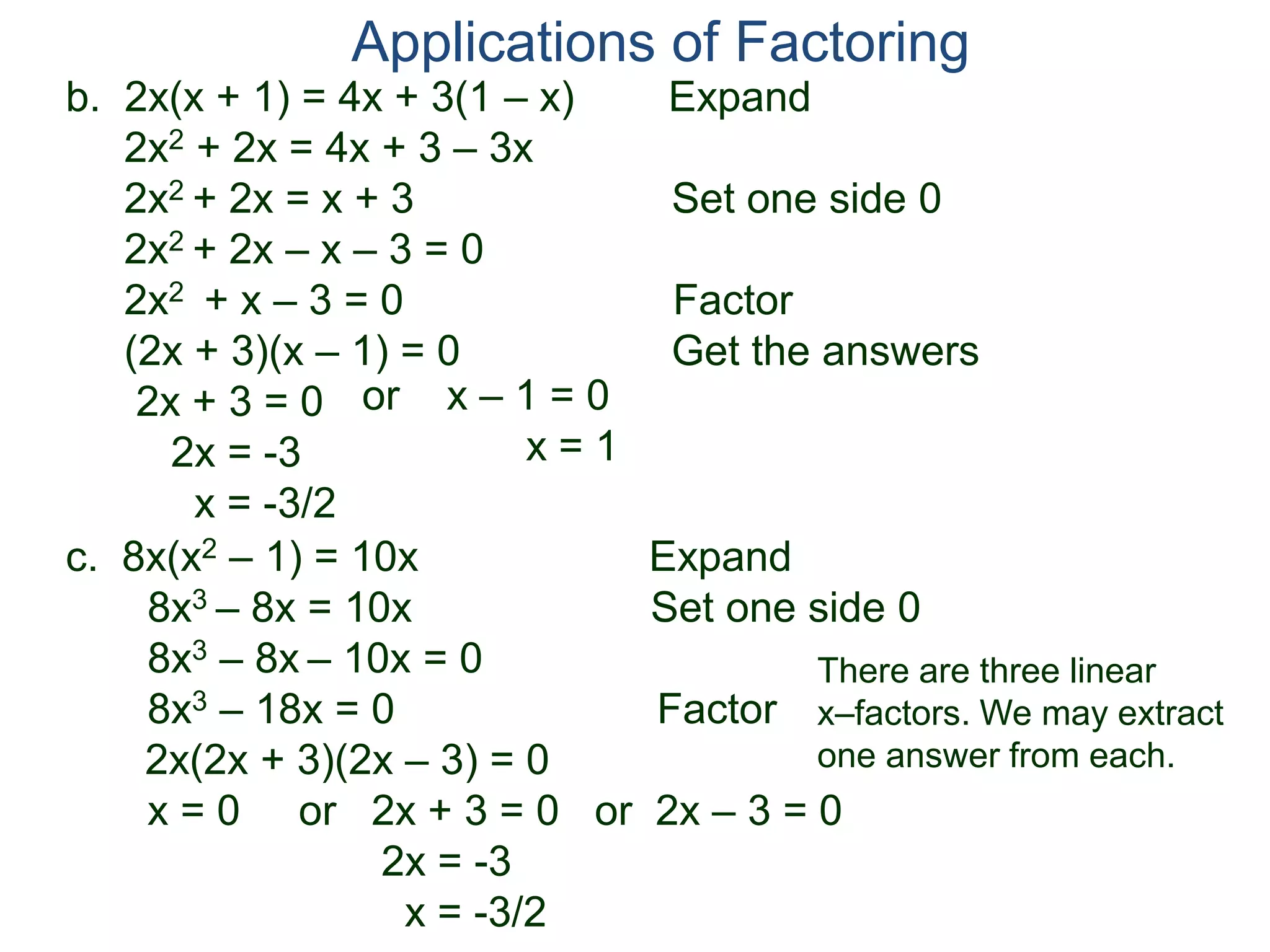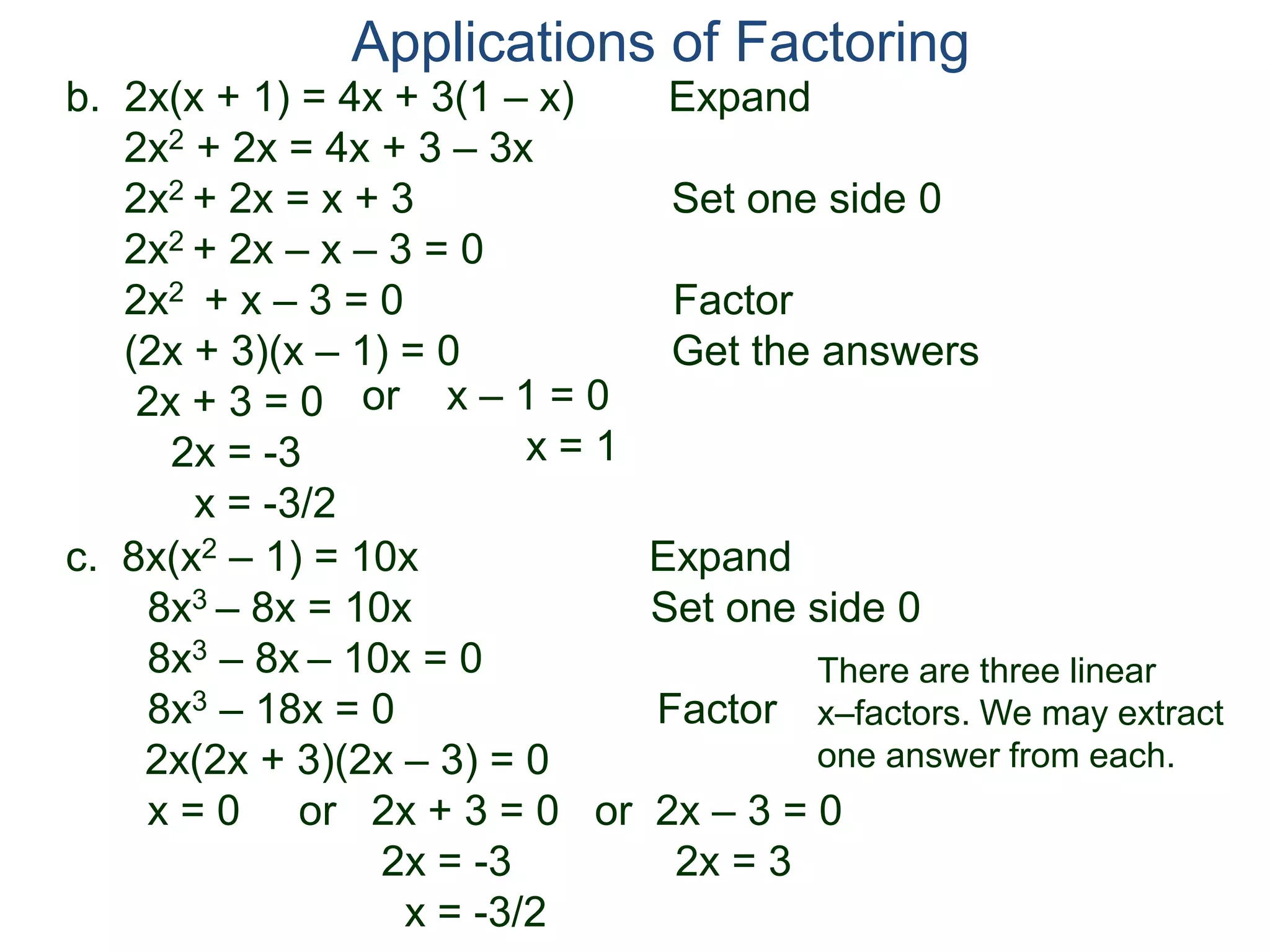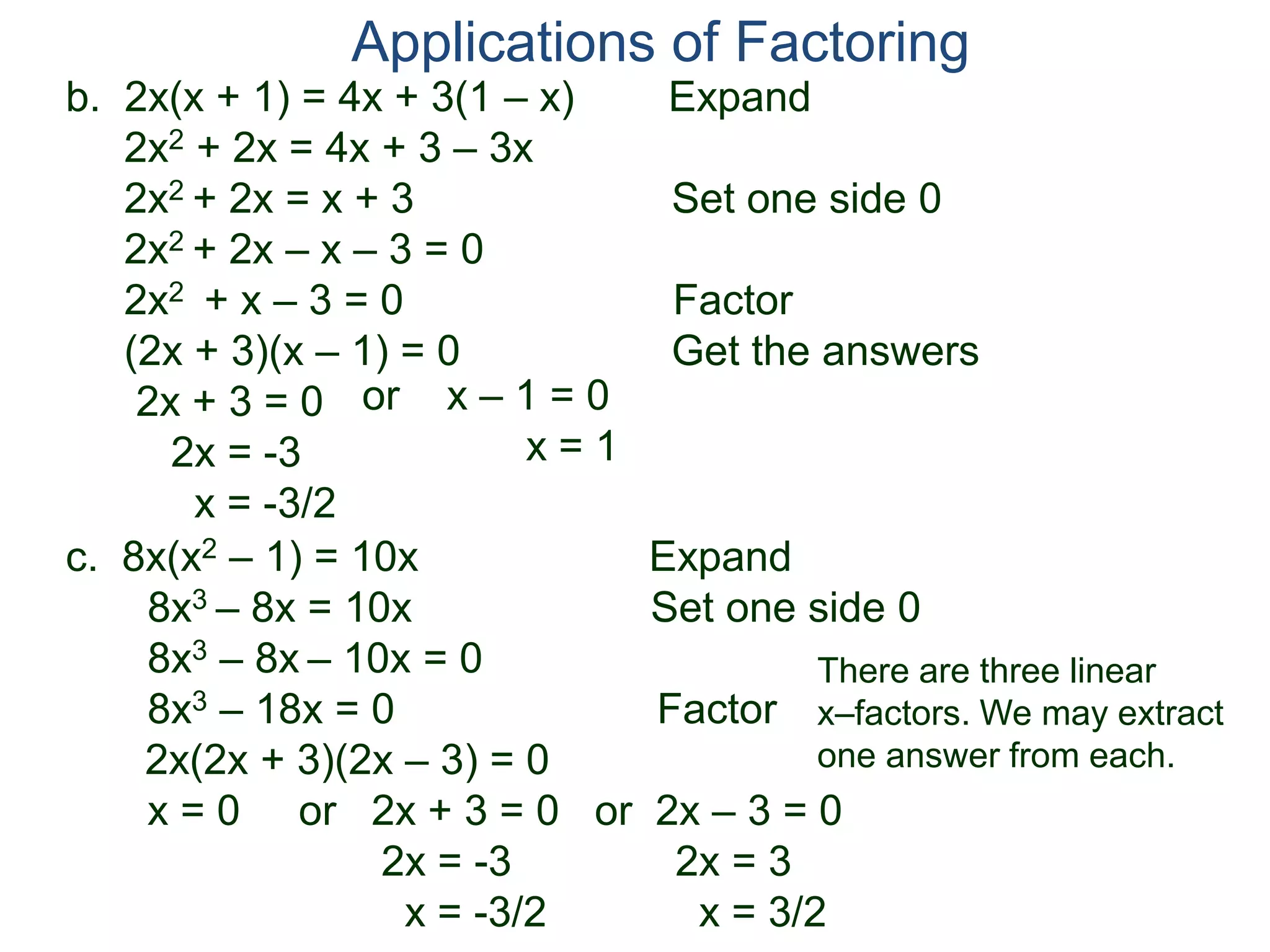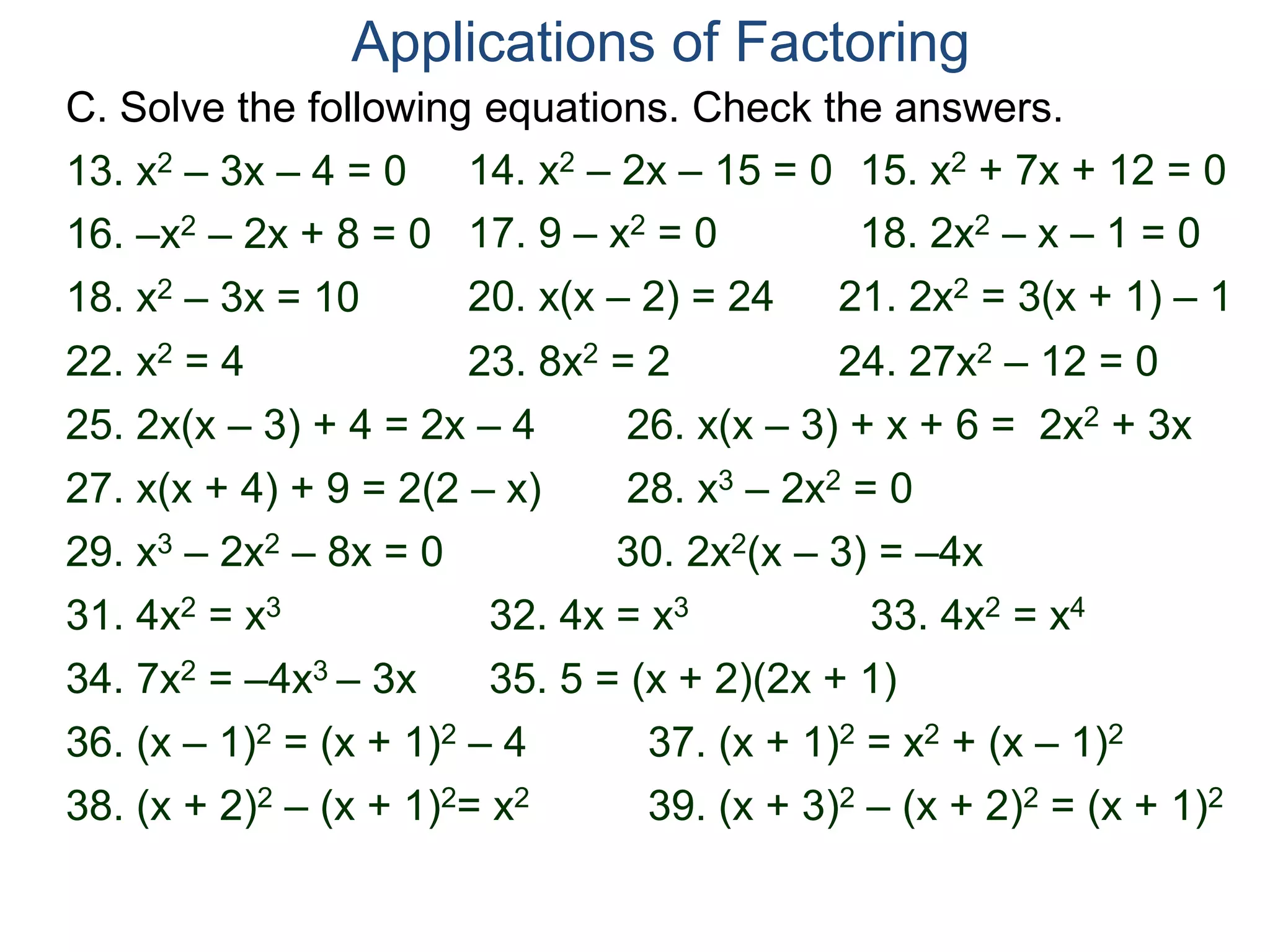The document discusses applications of factoring polynomials. It provides examples of how factoring can be used to evaluate polynomials by substituting values into the factored form. Factoring is also useful for determining the sign of outputs and for solving polynomial equations, which is described as the most important application of factoring. Examples are given to demonstrate evaluating polynomials both with and without factoring, and checking the answers obtained from factoring using the expanded form.

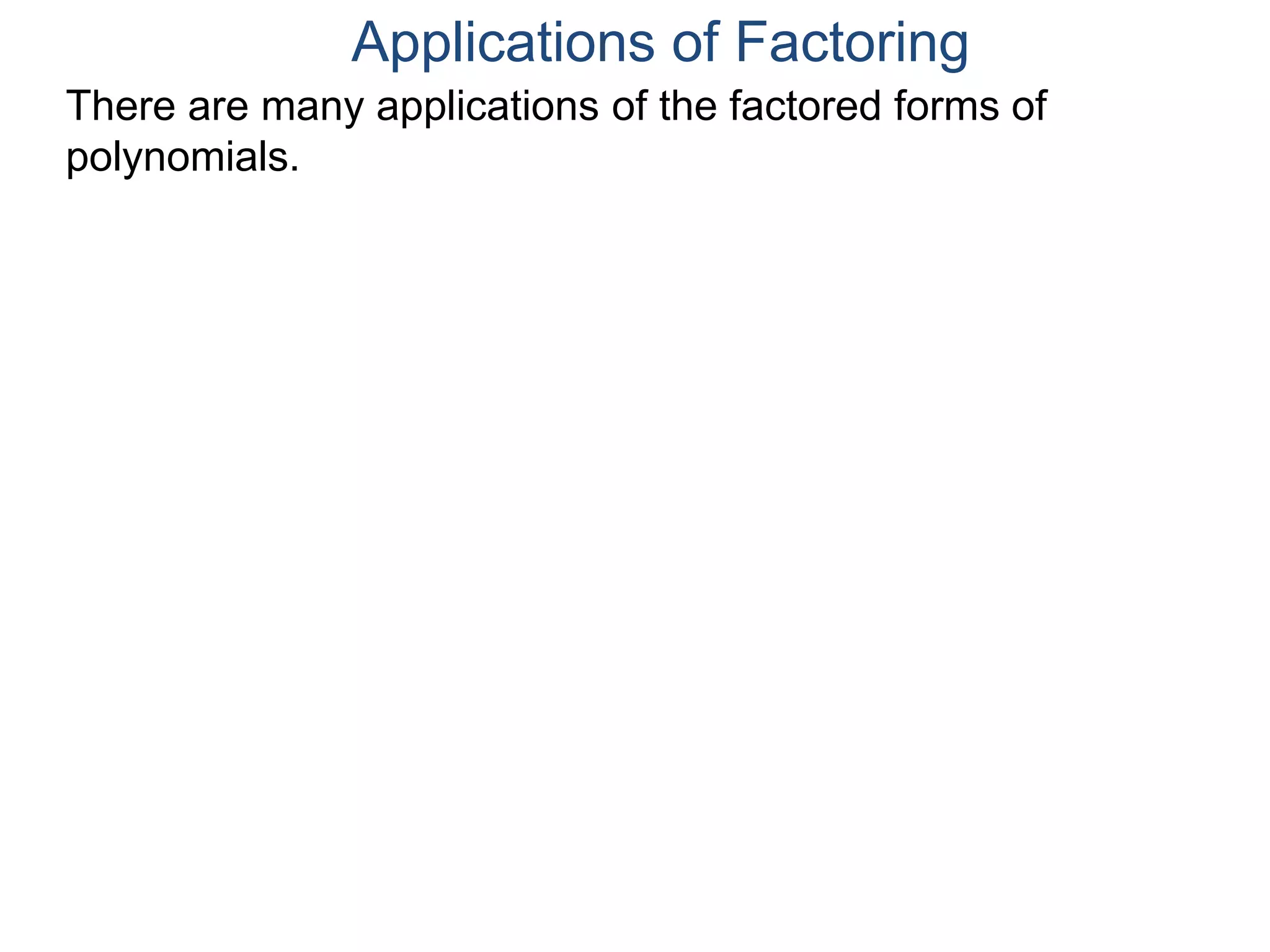
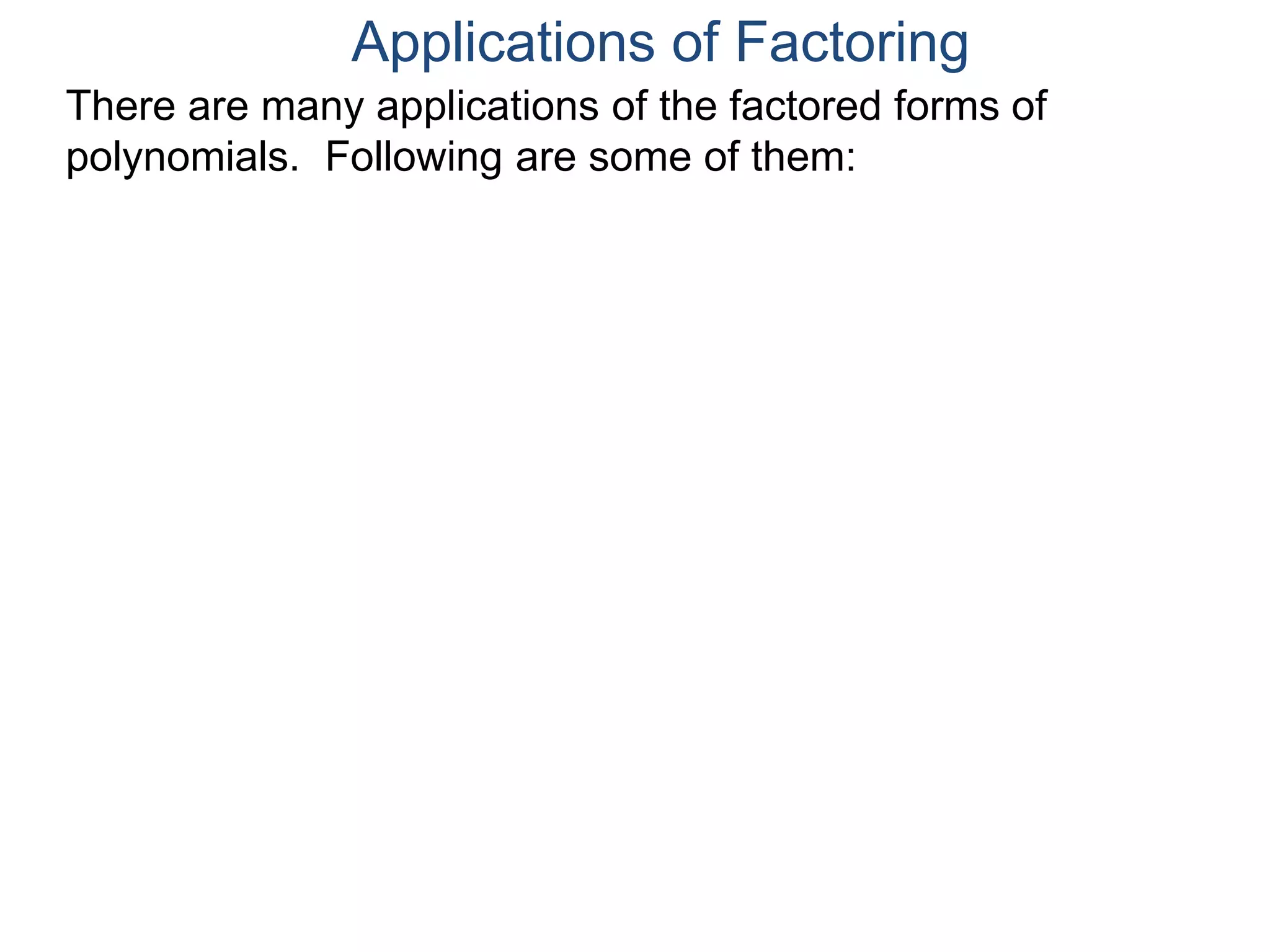
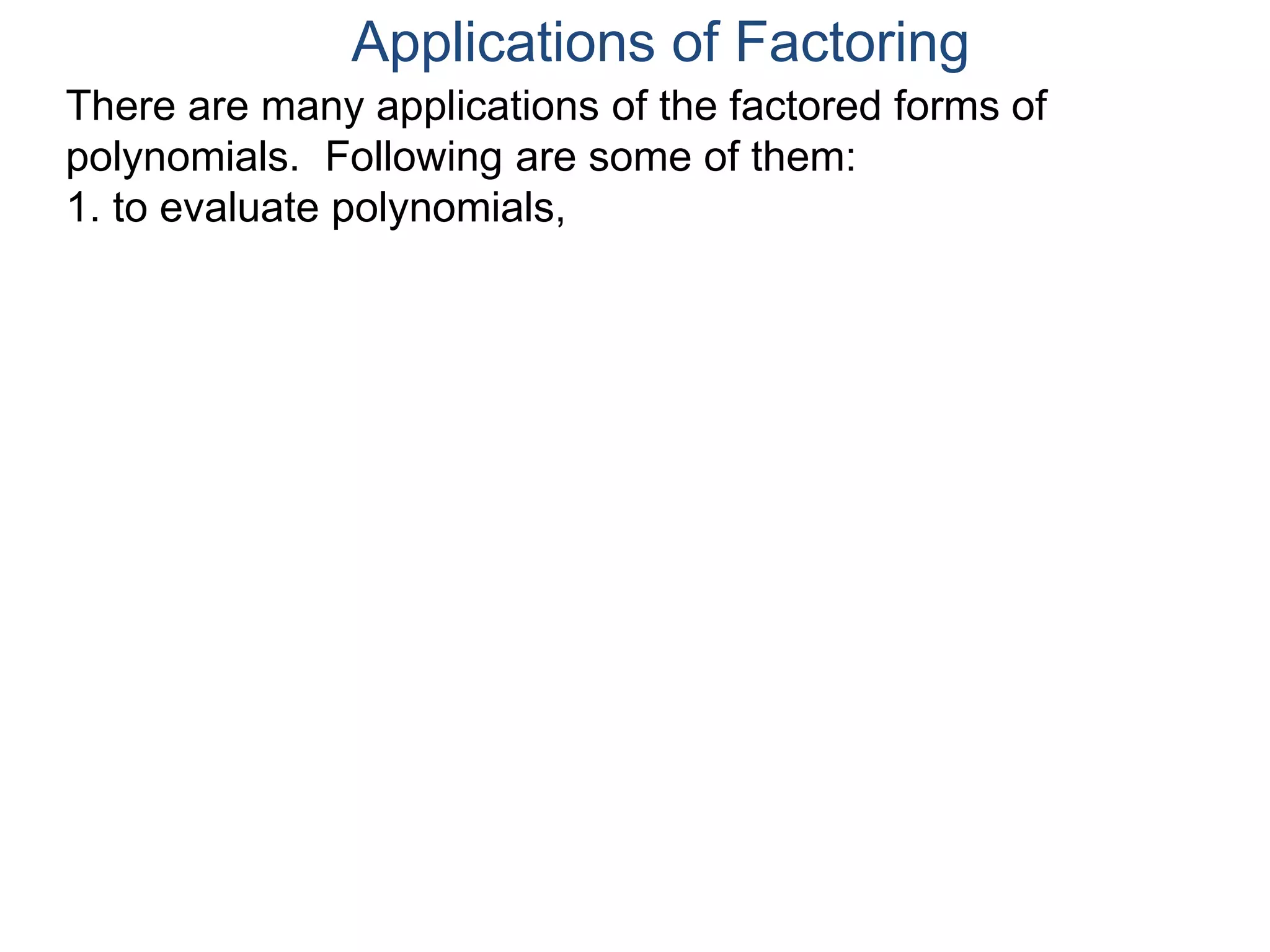
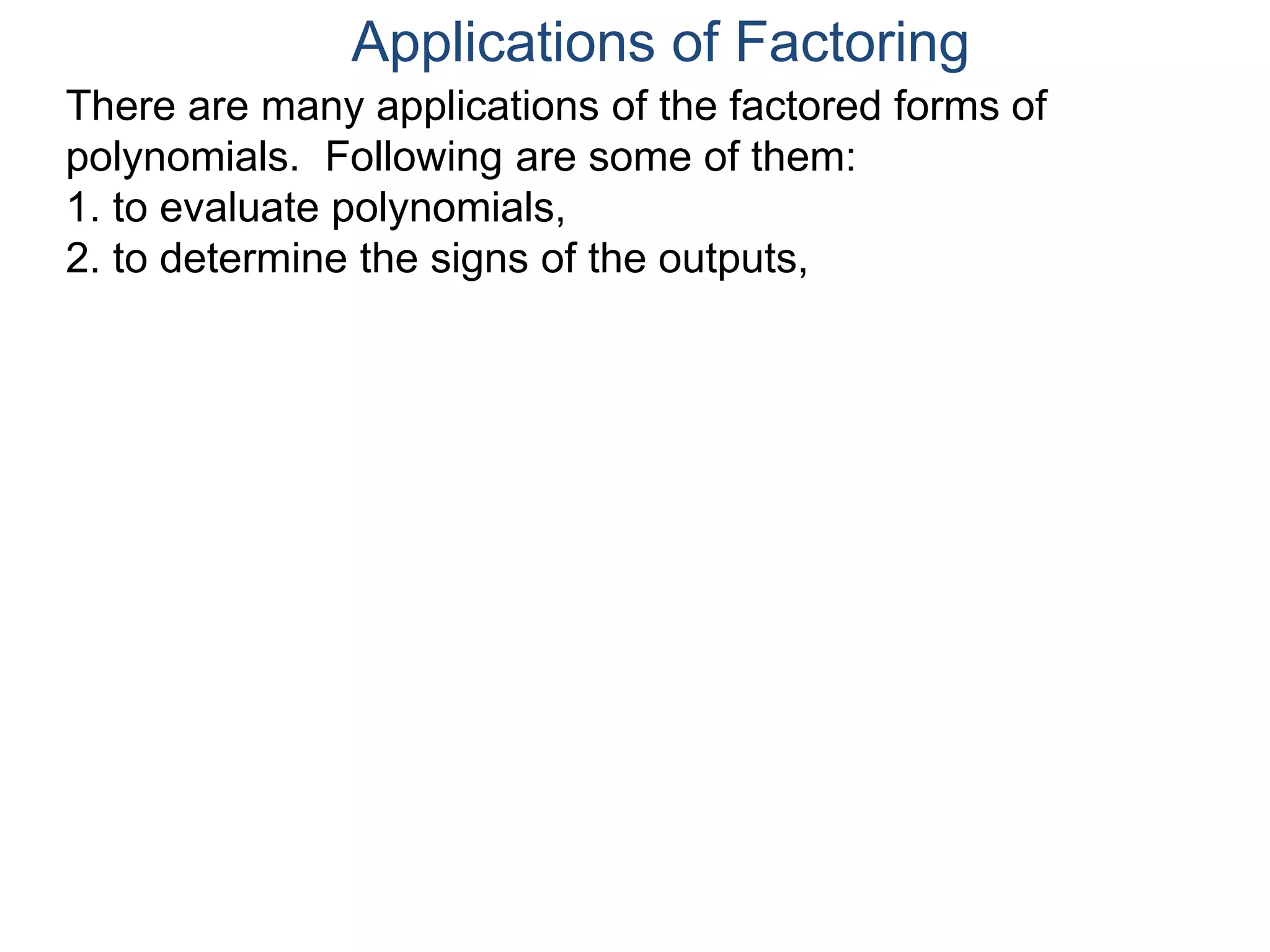

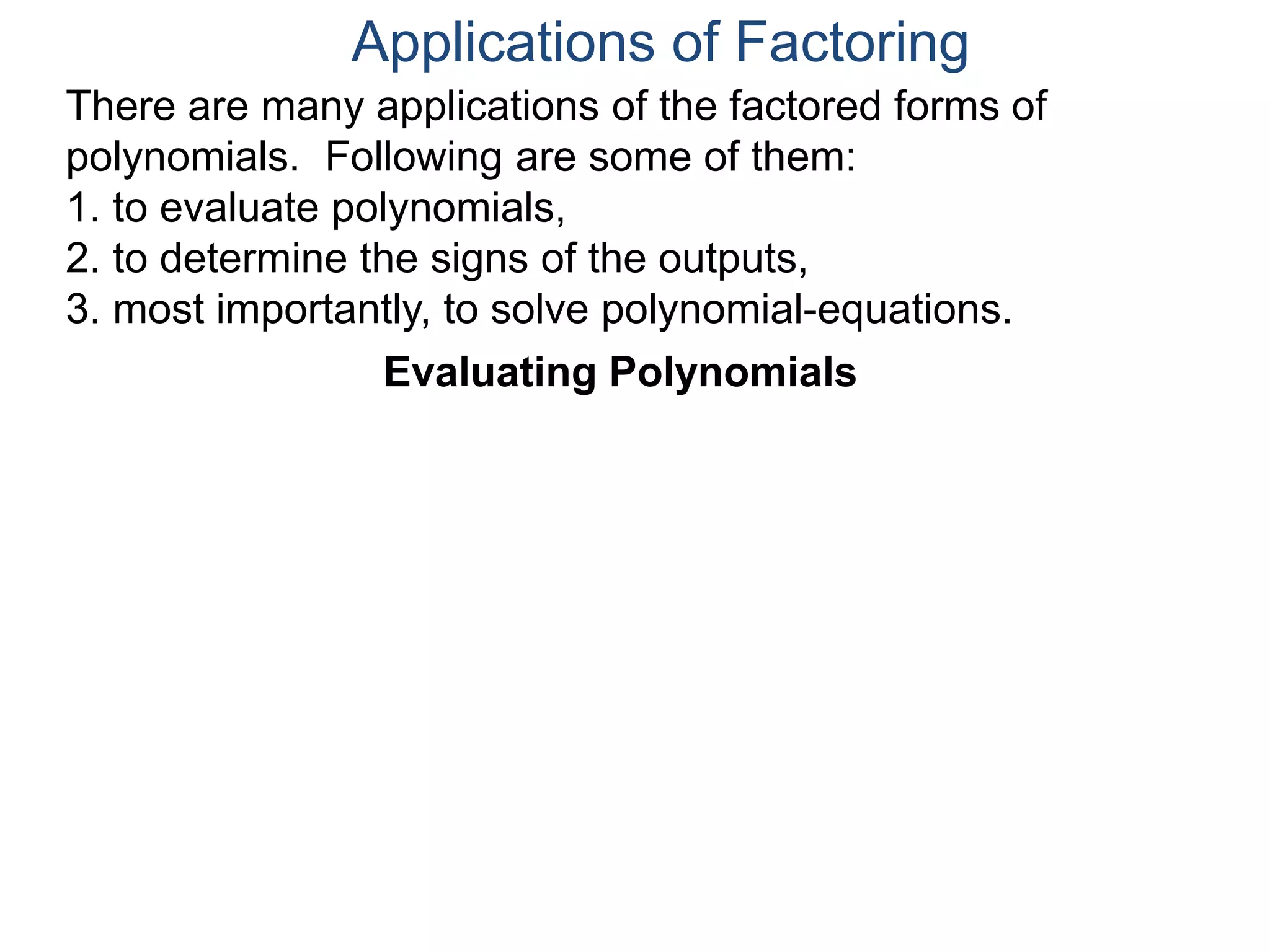
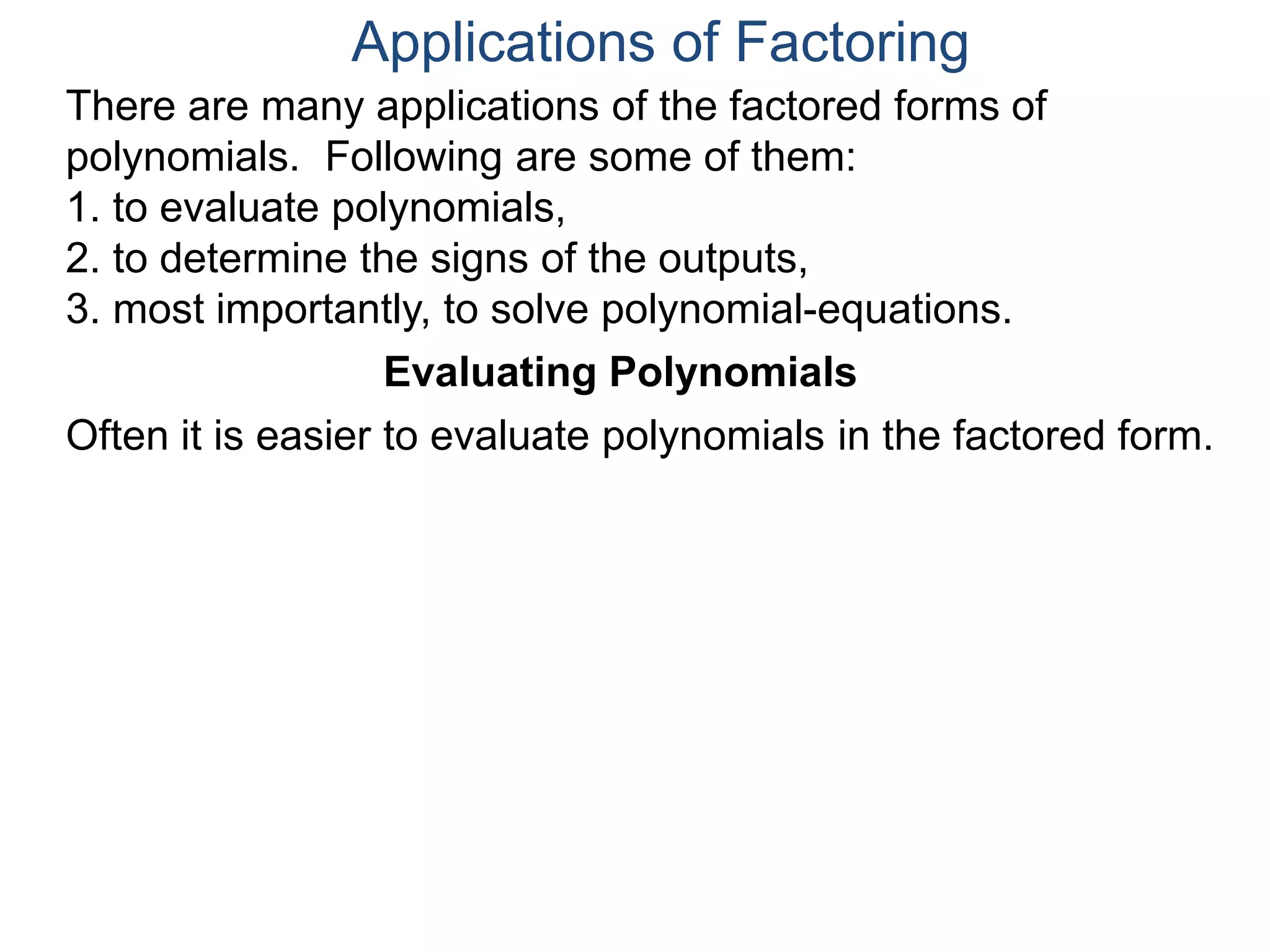
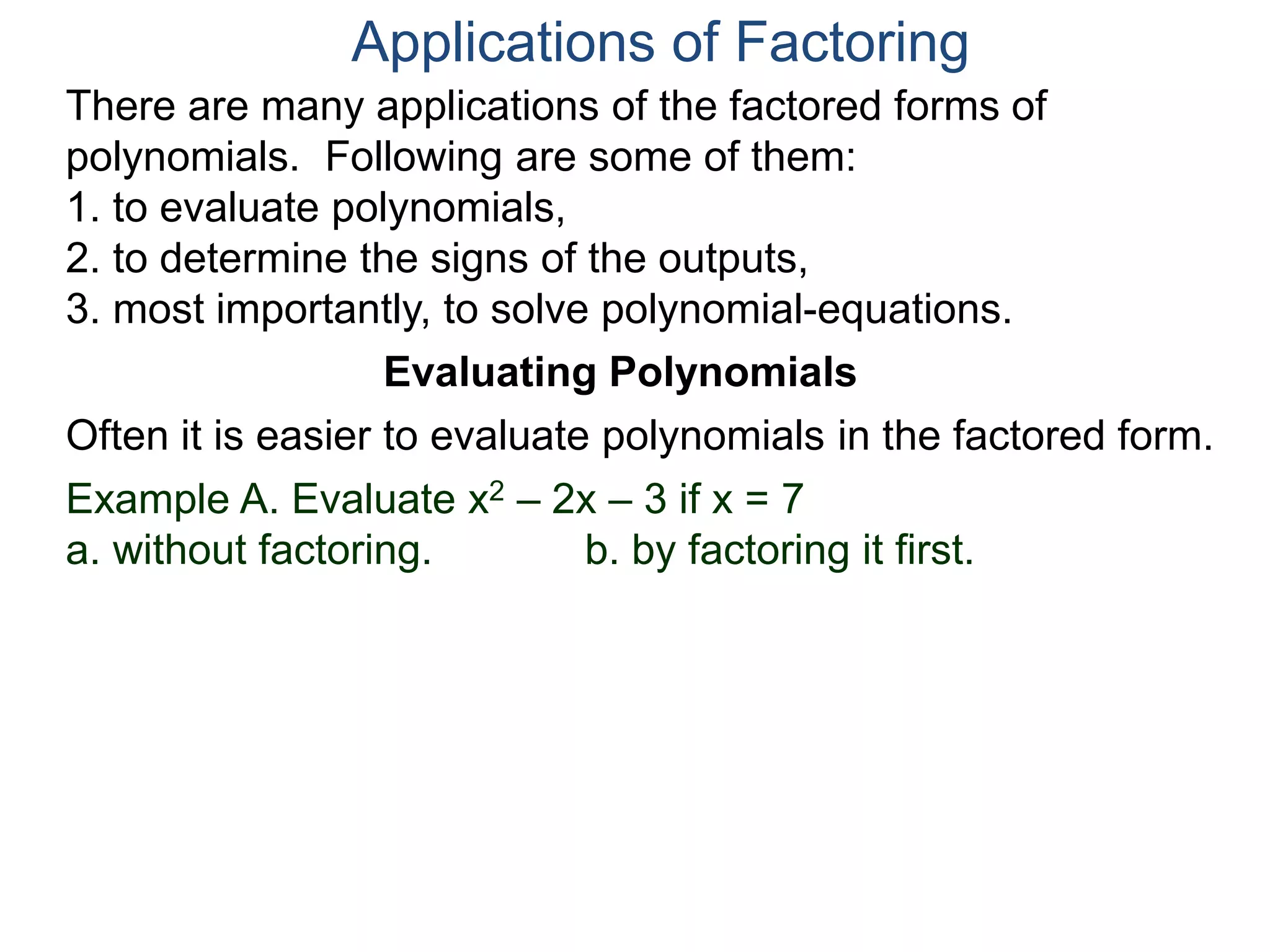
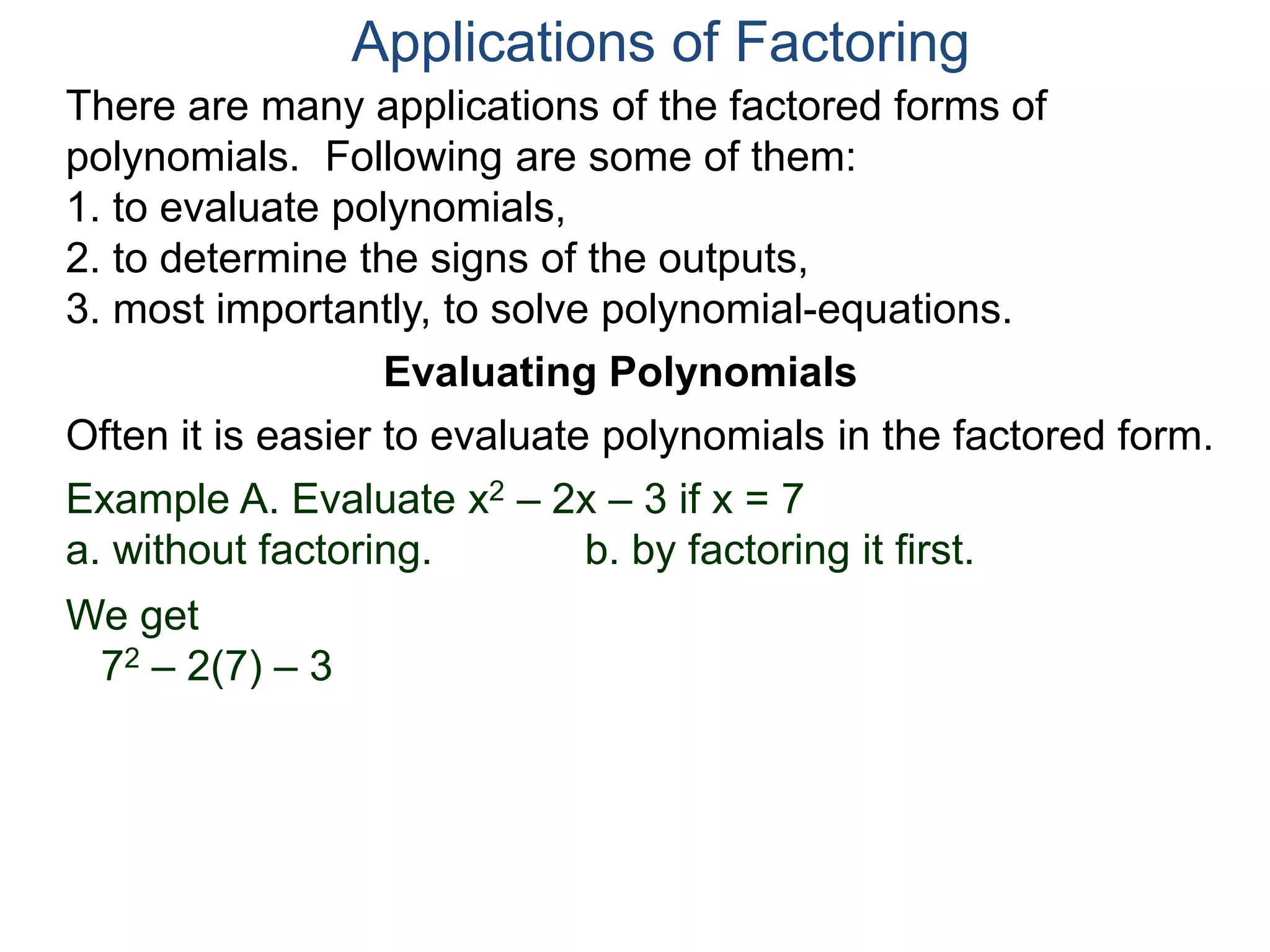
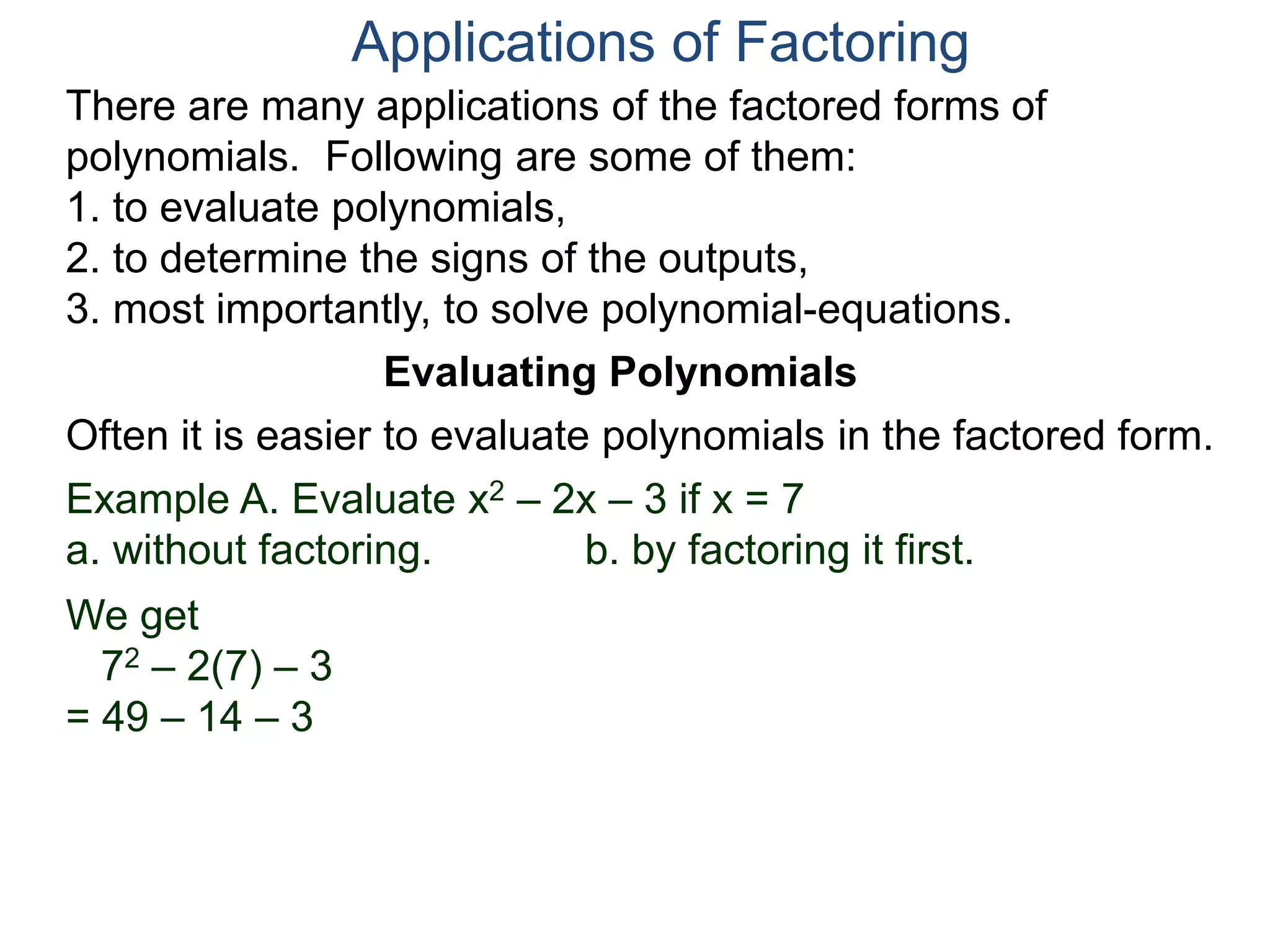
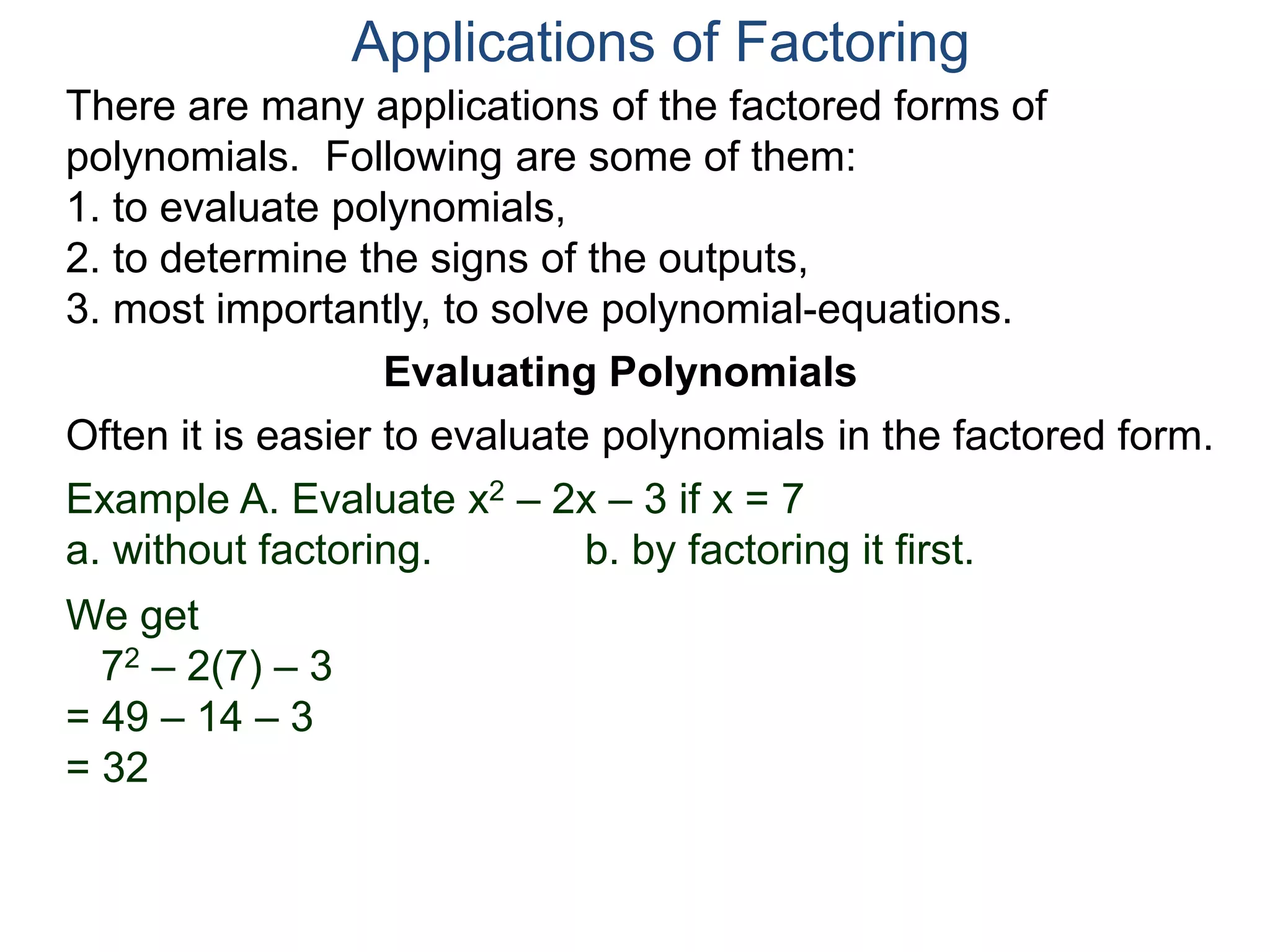
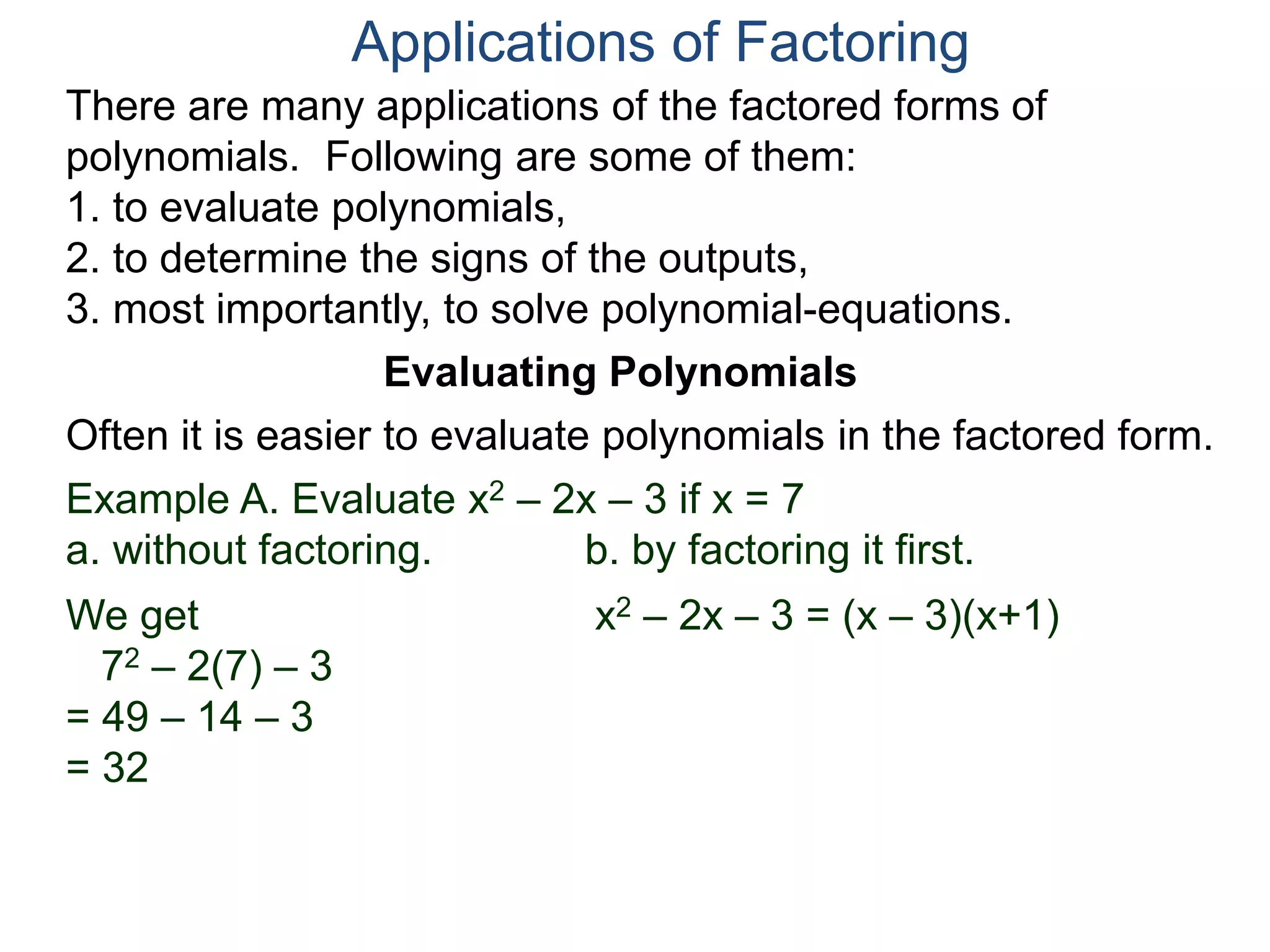
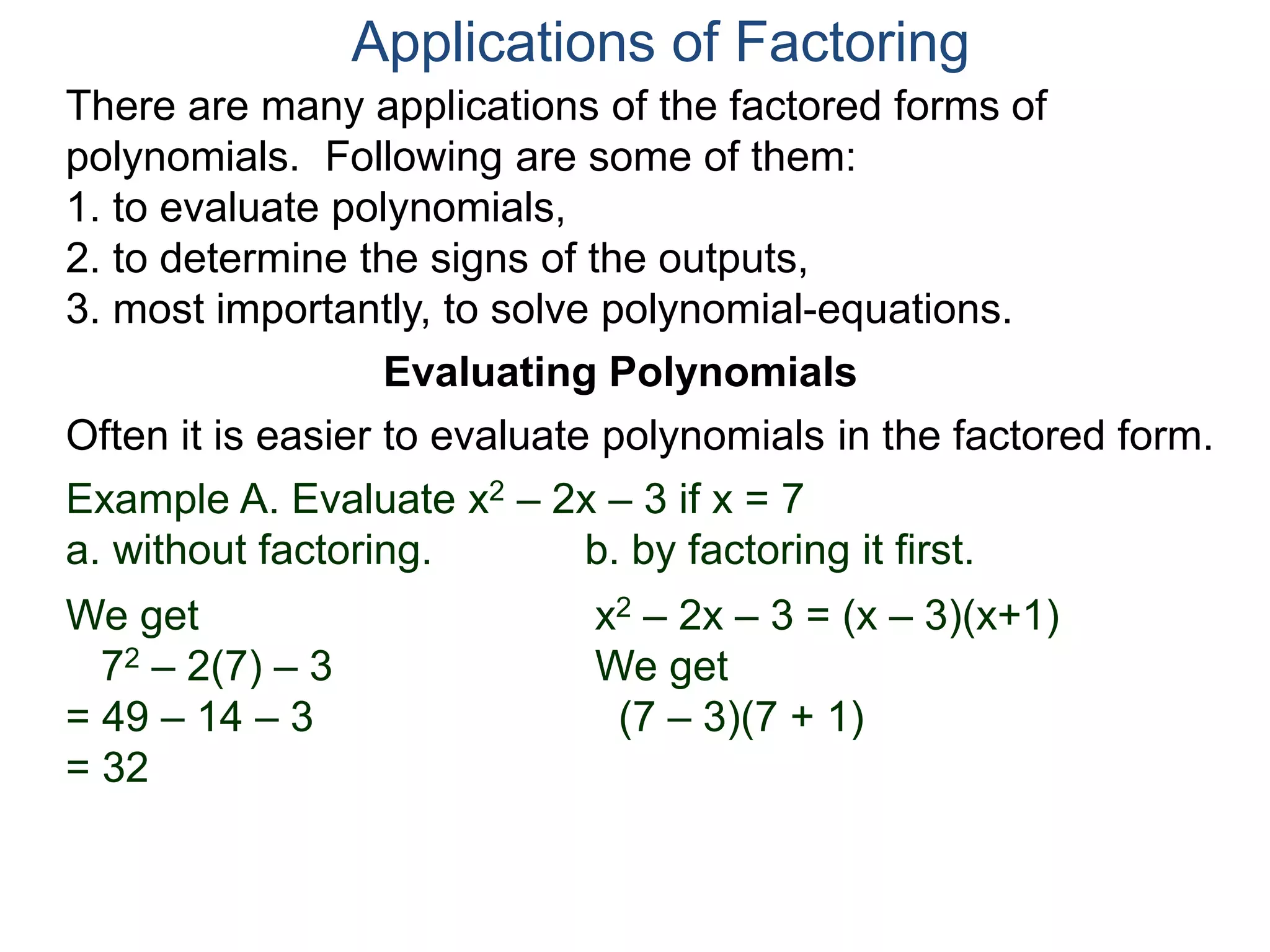


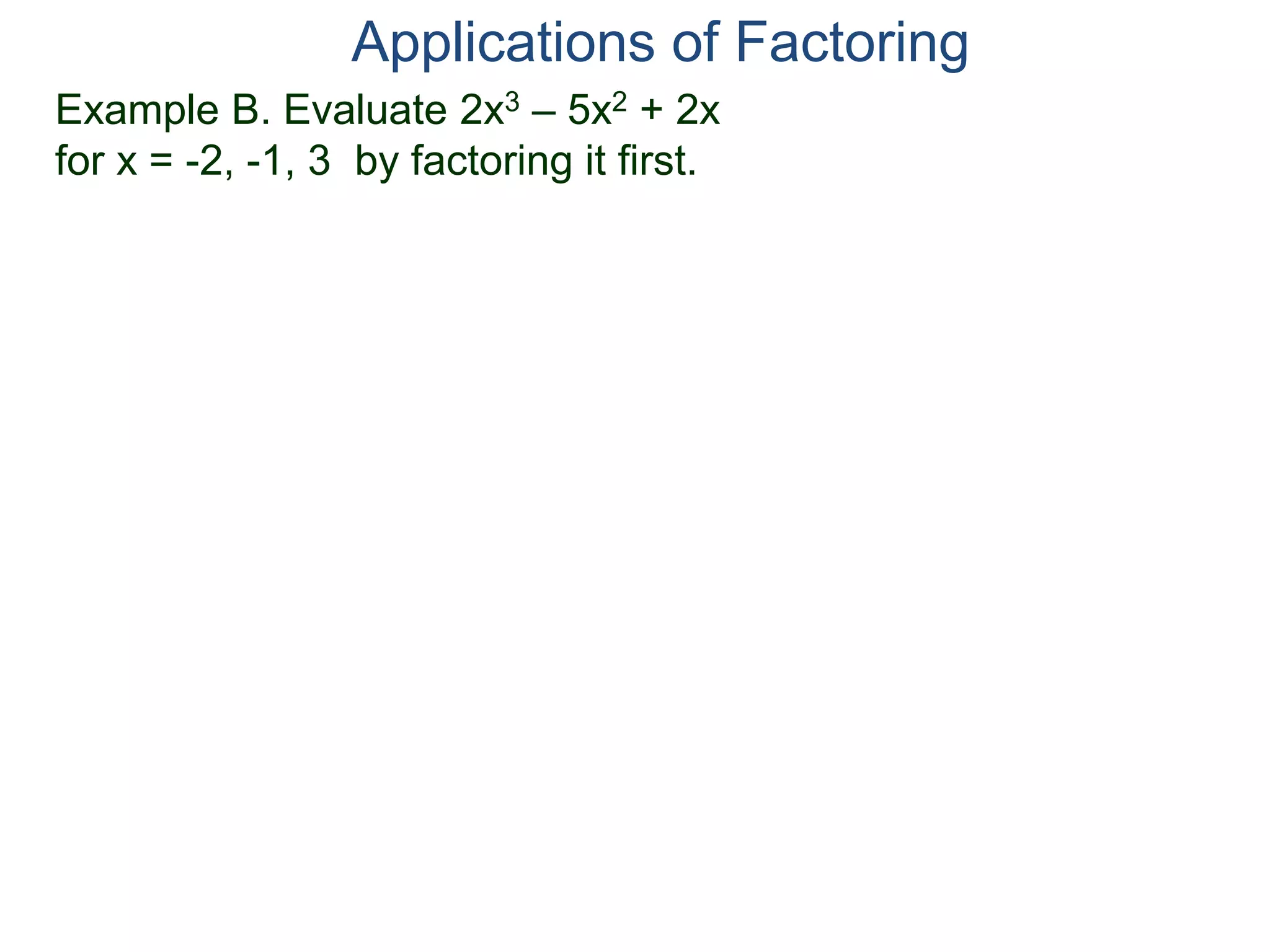
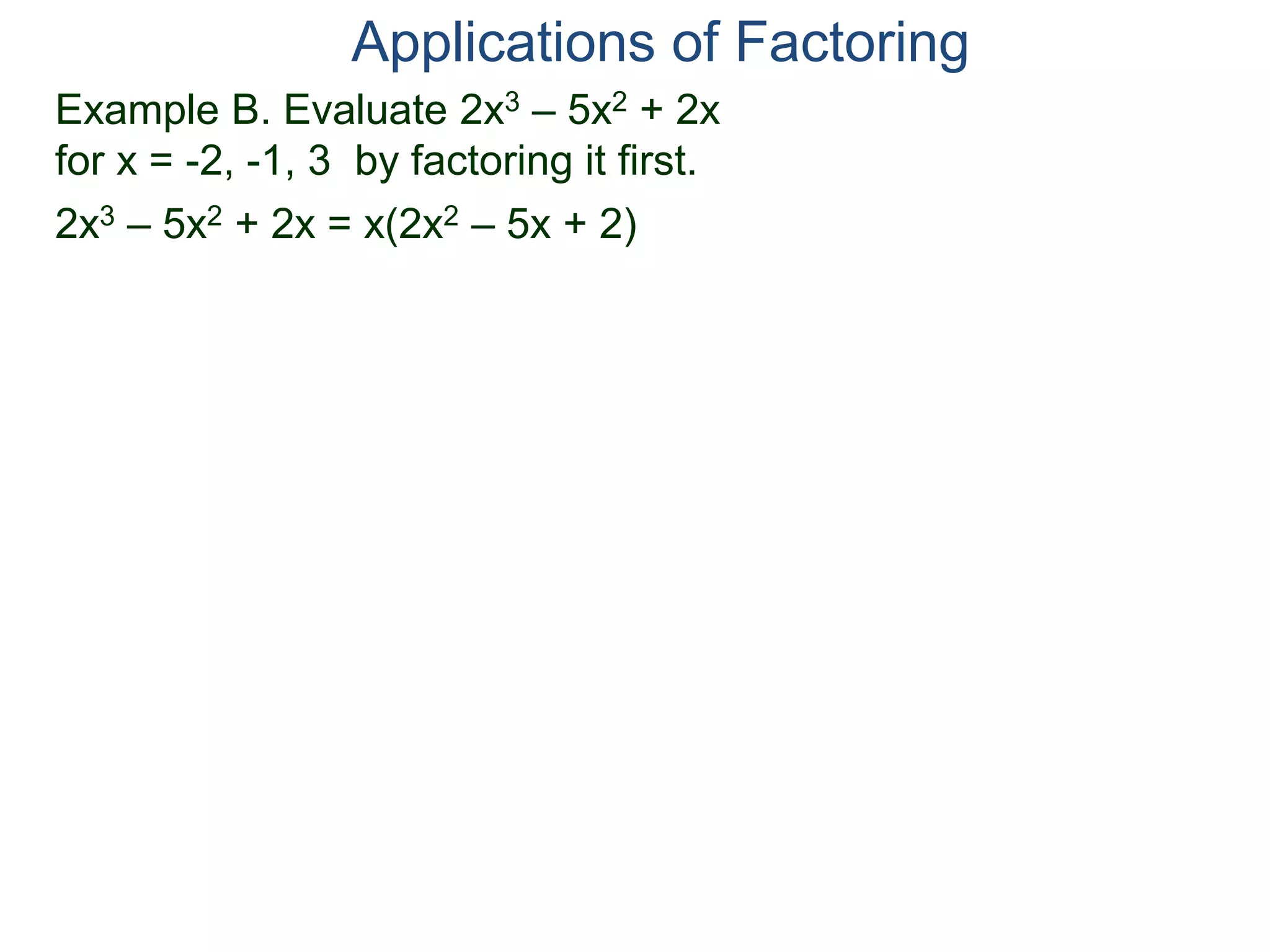
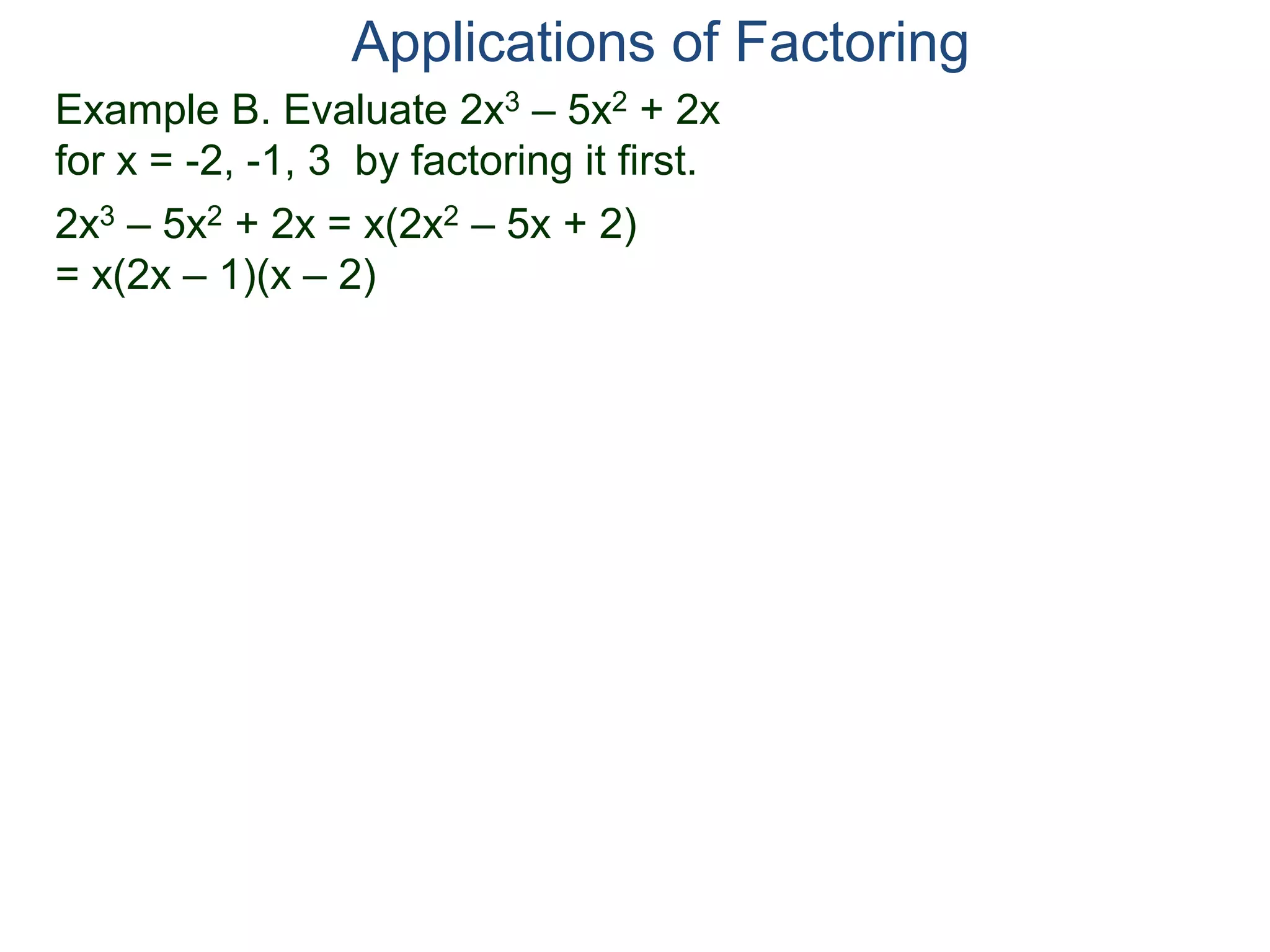
![Example B. Evaluate 2x3 – 5x2 + 2x
for x = -2, -1, 3 by factoring it first.
2x3 – 5x2 + 2x = x(2x2 – 5x + 2)
= x(2x – 1)(x – 2)
For x = -2:
(-2)[2(-2) – 1] [(-2) – 2]
Applications of Factoring](https://image.slidesharecdn.com/11applicationsoffactoring-150719190619-lva1-app6891/75/11-applications-of-factoring-20-2048.jpg)
![Example B. Evaluate 2x3 – 5x2 + 2x
for x = -2, -1, 3 by factoring it first.
2x3 – 5x2 + 2x = x(2x2 – 5x + 2)
= x(2x – 1)(x – 2)
For x = -2:
(-2)[2(-2) – 1] [(-2) – 2] = -2 [-5] [-4]
Applications of Factoring](https://image.slidesharecdn.com/11applicationsoffactoring-150719190619-lva1-app6891/75/11-applications-of-factoring-21-2048.jpg)
![Example B. Evaluate 2x3 – 5x2 + 2x
for x = -2, -1, 3 by factoring it first.
2x3 – 5x2 + 2x = x(2x2 – 5x + 2)
= x(2x – 1)(x – 2)
For x = -2:
(-2)[2(-2) – 1] [(-2) – 2] = -2 [-5] [-4] = -40
Applications of Factoring](https://image.slidesharecdn.com/11applicationsoffactoring-150719190619-lva1-app6891/75/11-applications-of-factoring-22-2048.jpg)
![Example B. Evaluate 2x3 – 5x2 + 2x
for x = -2, -1, 3 by factoring it first.
2x3 – 5x2 + 2x = x(2x2 – 5x + 2)
= x(2x – 1)(x – 2)
For x = -2:
(-2)[2(-2) – 1] [(-2) – 2] = -2 [-5] [-4] = -40
For x = -1:
(-1)[2(-1) – 1] [(-1) – 2]
Applications of Factoring](https://image.slidesharecdn.com/11applicationsoffactoring-150719190619-lva1-app6891/75/11-applications-of-factoring-23-2048.jpg)
![Example B. Evaluate 2x3 – 5x2 + 2x
for x = -2, -1, 3 by factoring it first.
2x3 – 5x2 + 2x = x(2x2 – 5x + 2)
= x(2x – 1)(x – 2)
For x = -2:
(-2)[2(-2) – 1] [(-2) – 2] = -2 [-5] [-4] = -40
For x = -1:
(-1)[2(-1) – 1] [(-1) – 2] = -1 [-3] [-3]
Applications of Factoring](https://image.slidesharecdn.com/11applicationsoffactoring-150719190619-lva1-app6891/75/11-applications-of-factoring-24-2048.jpg)
![Example B. Evaluate 2x3 – 5x2 + 2x
for x = -2, -1, 3 by factoring it first.
2x3 – 5x2 + 2x = x(2x2 – 5x + 2)
= x(2x – 1)(x – 2)
For x = -2:
(-2)[2(-2) – 1] [(-2) – 2] = -2 [-5] [-4] = -40
For x = -1:
(-1)[2(-1) – 1] [(-1) – 2] = -1 [-3] [-3] = -9
Applications of Factoring](https://image.slidesharecdn.com/11applicationsoffactoring-150719190619-lva1-app6891/75/11-applications-of-factoring-25-2048.jpg)
![Example B. Evaluate 2x3 – 5x2 + 2x
for x = -2, -1, 3 by factoring it first.
2x3 – 5x2 + 2x = x(2x2 – 5x + 2)
= x(2x – 1)(x – 2)
For x = -2:
(-2)[2(-2) – 1] [(-2) – 2] = -2 [-5] [-4] = -40
For x = -1:
(-1)[2(-1) – 1] [(-1) – 2] = -1 [-3] [-3] = -9
For x = 3:
3 [2(3) – 1] [(3) – 2]
Applications of Factoring](https://image.slidesharecdn.com/11applicationsoffactoring-150719190619-lva1-app6891/75/11-applications-of-factoring-26-2048.jpg)
![Example B. Evaluate 2x3 – 5x2 + 2x
for x = -2, -1, 3 by factoring it first.
2x3 – 5x2 + 2x = x(2x2 – 5x + 2)
= x(2x – 1)(x – 2)
For x = -2:
(-2)[2(-2) – 1] [(-2) – 2] = -2 [-5] [-4] = -40
For x = -1:
(-1)[2(-1) – 1] [(-1) – 2] = -1 [-3] [-3] = -9
For x = 3:
3 [2(3) – 1] [(3) – 2] = 3 [5] [1] = 15
Applications of Factoring](https://image.slidesharecdn.com/11applicationsoffactoring-150719190619-lva1-app6891/75/11-applications-of-factoring-27-2048.jpg)
![Example B. Evaluate 2x3 – 5x2 + 2x
for x = -2, -1, 3 by factoring it first.
2x3 – 5x2 + 2x = x(2x2 – 5x + 2)
= x(2x – 1)(x – 2)
For x = -2:
(-2)[2(-2) – 1] [(-2) – 2] = -2 [-5] [-4] = -40
For x = -1:
(-1)[2(-1) – 1] [(-1) – 2] = -1 [-3] [-3] = -9
For x = 3:
3 [2(3) – 1] [(3) – 2] = 3 [5] [1] = 15
Applications of Factoring](https://image.slidesharecdn.com/11applicationsoffactoring-150719190619-lva1-app6891/75/11-applications-of-factoring-28-2048.jpg)
![Example B. Evaluate 2x3 – 5x2 + 2x
for x = -2, -1, 3 by factoring it first.
2x3 – 5x2 + 2x = x(2x2 – 5x + 2)
= x(2x – 1)(x – 2)
For x = -2:
(-2)[2(-2) – 1] [(-2) – 2] = -2 [-5] [-4] = -40
For x = -1:
(-1)[2(-1) – 1] [(-1) – 2] = -1 [-3] [-3] = -9
For x = 3:
3 [2(3) – 1] [(3) – 2] = 3 [5] [1] = 15
Applications of Factoring
Your turn: Double check these answers via the expanded form.](https://image.slidesharecdn.com/11applicationsoffactoring-150719190619-lva1-app6891/75/11-applications-of-factoring-29-2048.jpg)
![Example B. Evaluate 2x3 – 5x2 + 2x
for x = -2, -1, 3 by factoring it first.
2x3 – 5x2 + 2x = x(2x2 – 5x + 2)
= x(2x – 1)(x – 2)
For x = -2:
(-2)[2(-2) – 1] [(-2) – 2] = -2 [-5] [-4] = -40
For x = -1:
(-1)[2(-1) – 1] [(-1) – 2] = -1 [-3] [-3] = -9
For x = 3:
3 [2(3) – 1] [(3) – 2] = 3 [5] [1] = 15
Applications of Factoring
Determine the signs of the outputs
Your turn: Double check these answers via the expanded form.](https://image.slidesharecdn.com/11applicationsoffactoring-150719190619-lva1-app6891/75/11-applications-of-factoring-30-2048.jpg)
![Example B. Evaluate 2x3 – 5x2 + 2x
for x = -2, -1, 3 by factoring it first.
2x3 – 5x2 + 2x = x(2x2 – 5x + 2)
= x(2x – 1)(x – 2)
For x = -2:
(-2)[2(-2) – 1] [(-2) – 2] = -2 [-5] [-4] = -40
For x = -1:
(-1)[2(-1) – 1] [(-1) – 2] = -1 [-3] [-3] = -9
For x = 3:
3 [2(3) – 1] [(3) – 2] = 3 [5] [1] = 15
Applications of Factoring
Determine the signs of the outputs
Often we only want to know the sign of the output, i.e.
whether the output is positive or negative.
Your turn: Double check these answers via the expanded form.](https://image.slidesharecdn.com/11applicationsoffactoring-150719190619-lva1-app6891/75/11-applications-of-factoring-31-2048.jpg)
![Example B. Evaluate 2x3 – 5x2 + 2x
for x = -2, -1, 3 by factoring it first.
2x3 – 5x2 + 2x = x(2x2 – 5x + 2)
= x(2x – 1)(x – 2)
For x = -2:
(-2)[2(-2) – 1] [(-2) – 2] = -2 [-5] [-4] = -40
For x = -1:
(-1)[2(-1) – 1] [(-1) – 2] = -1 [-3] [-3] = -9
For x = 3:
3 [2(3) – 1] [(3) – 2] = 3 [5] [1] = 15
Applications of Factoring
Determine the signs of the outputs
Often we only want to know the sign of the output, i.e.
whether the output is positive or negative. It is easy to do this
using the factored form.
Your turn: Double check these answers via the expanded form.](https://image.slidesharecdn.com/11applicationsoffactoring-150719190619-lva1-app6891/75/11-applications-of-factoring-32-2048.jpg)
